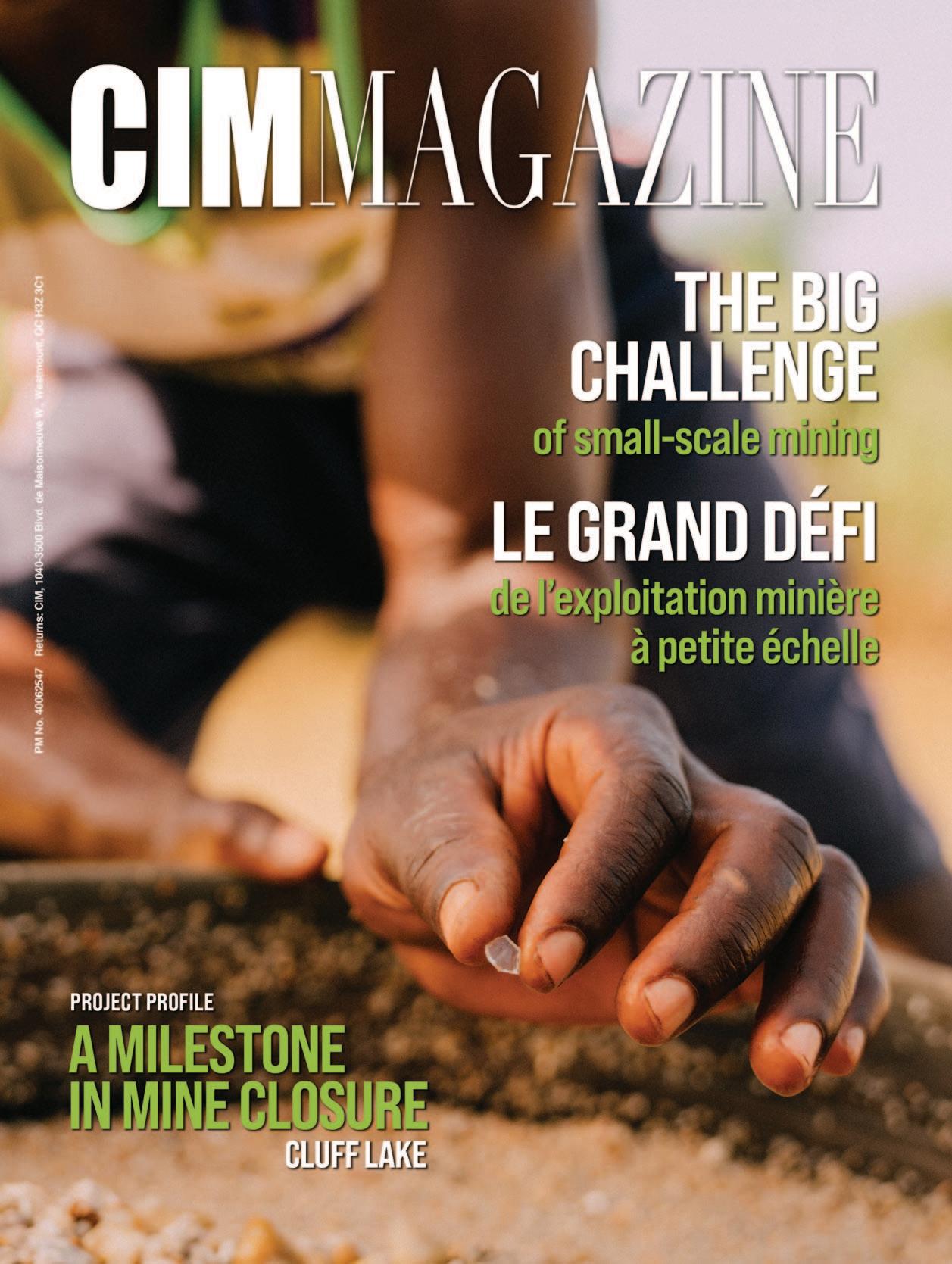

Optimize your results
The HPGR Pro features are next-gen technology resulting in operational advantages versus conventional HPGR… features that are retrofittable!
Whether it’s a new machine or an upgrade for an existing unit, the HPGR Pro takes your grinding operations to the next level with the most efficient comminution product in grinding and milling!
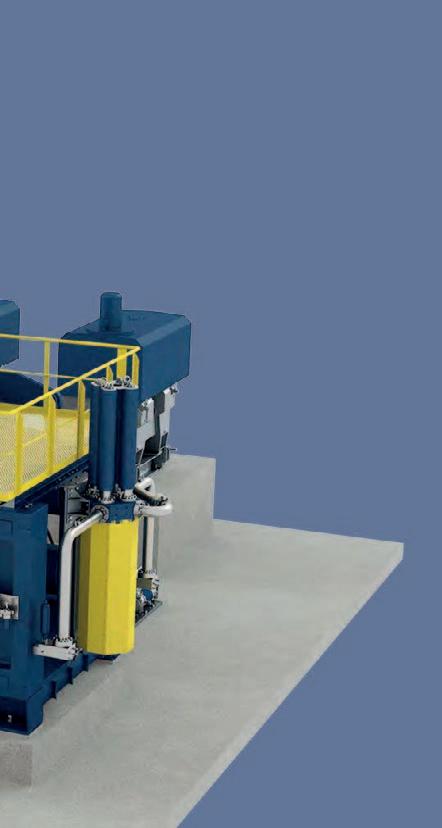
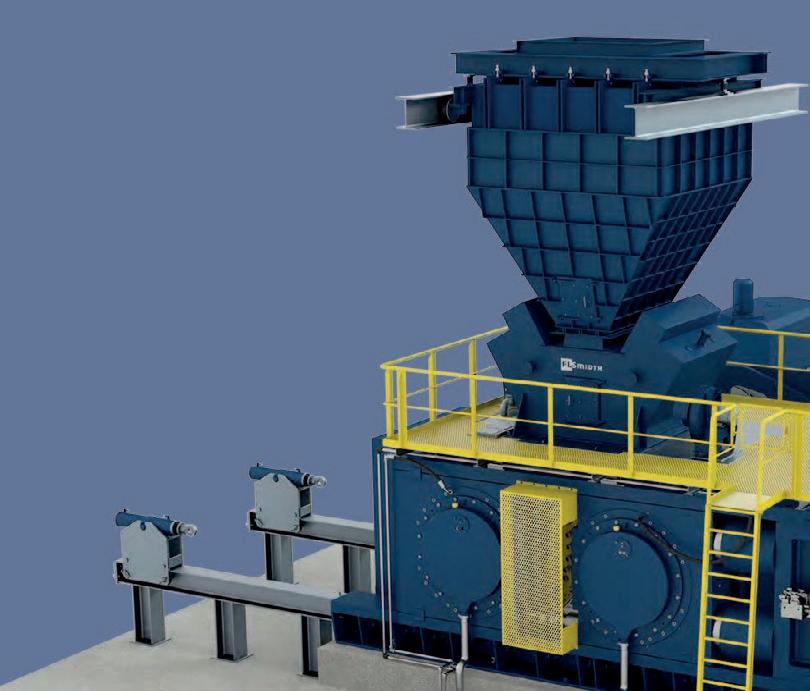
Key benefits vs conventional HPGR
■ Increased throughput up to 20%
■ Reduce power demands by as much as 15%
■ Extend life of the rolls up to 30%
■ Maximize life of the bearings
■ On-line monitoring of roll surfaces

with the HPGR Pro the next evolutionary step in our market-leading HPGR technology
For more than 40 years, we’ve been providing the labor, expertise and products to keep you mining.
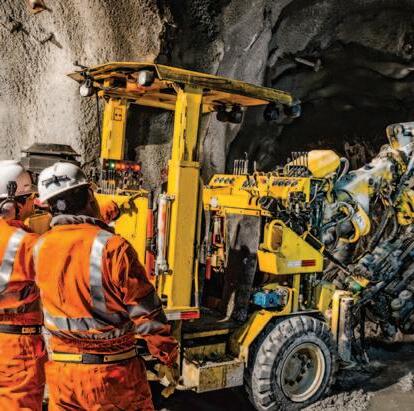
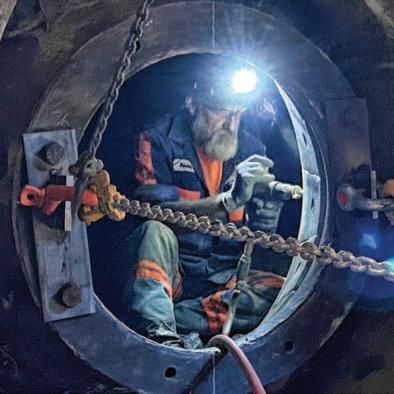
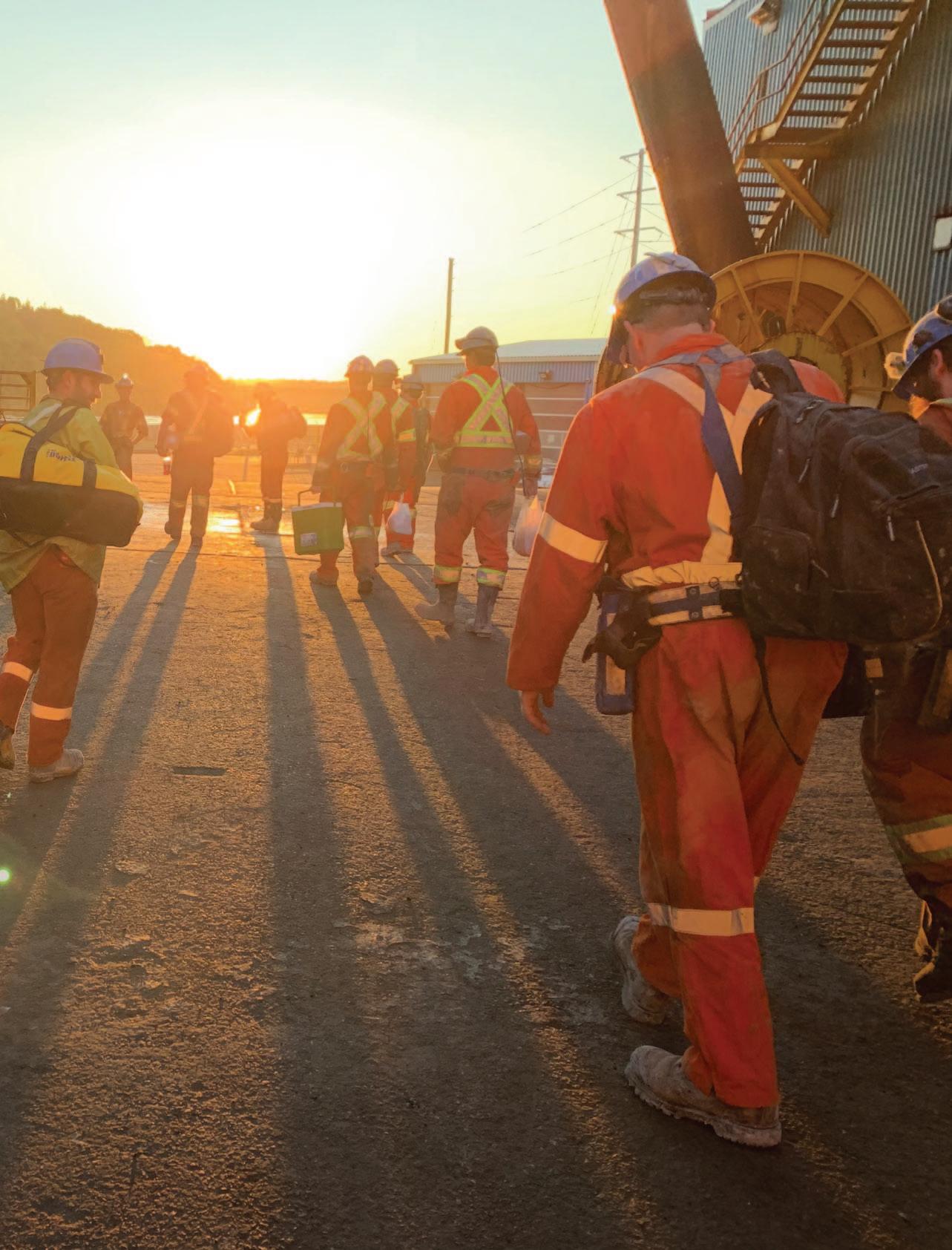
WE’RE THERE WHEN YOU NEED US!
SERVICES INCLUDE:
•CONTRACT MINING
•CONTRACT LABOR
•SHAFT WORK
•SHOTCRETE WORK
•BACK & RIB BOLTING
•MILL SITE MAINTENANCE
•CONCRETE WORK
•GLUE & GROUT INJECTION
•MINE SEALS
•MOBILE SERVICE
GROUND CONTROL
PRODUCTS INCLUDE:
•SPLIT SETS / FRICTION BOLTS
•EXPANDABLE BOLTS
•WIRE MESH
•QUICK INSTALL PROPS
•STEEL CAN SUPPORTS

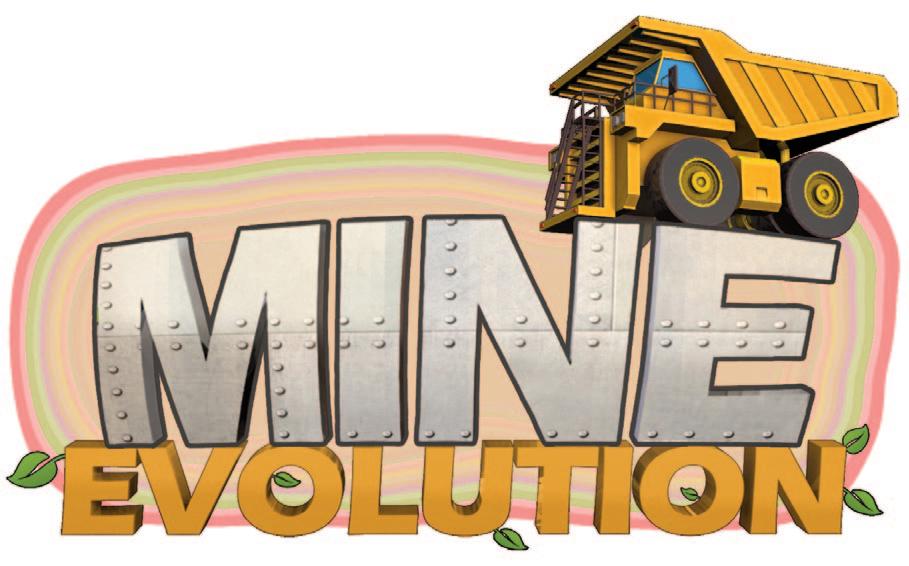



42 Two industries at a crossroads
The formalization of artisanal and smallscale mining may be necessary to help meet global demand for critical minerals
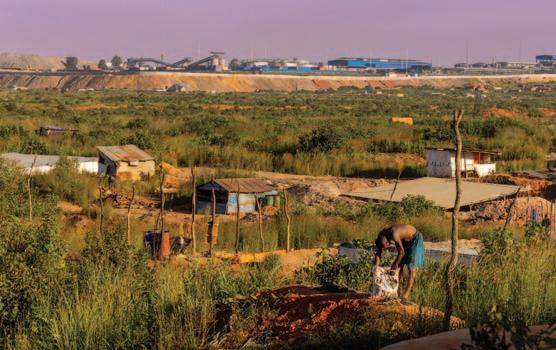 By Kelsey Rolfe
By Kelsey Rolfe
Project Profile
48 Cluff Lake rebirth
Orano Canada spent 21 years decommissioning and reclaiming its Saskatchewan uranium project—almost as long as the 22 years the mine was in operation

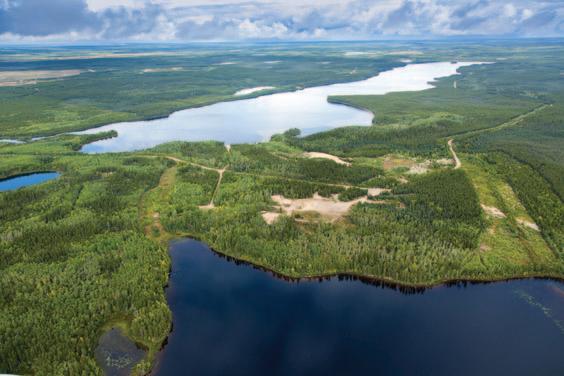 By Alexandra Lopez-Pacheco
By Alexandra Lopez-Pacheco
51 Screen time
Efficiency, uptime and optimization is the focus of companies offering a wide range of screening technologies
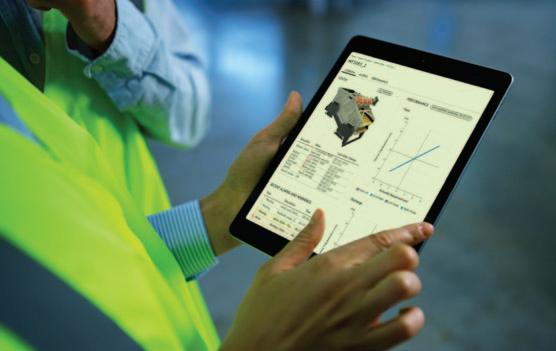 By Tijana Mitrovic
By Tijana Mitrovic
64 Aerial exploration
An excerpt of a 1929 paper by the staff of Northern Aerial Minerals Exploration, with an introduction by John E. Hammell, who became the company’s president, about the about the genesis of aerial exploration in Canada’s North
Compiled by Ailbhe Goodbody
In each issue
8 Editor’s letter
10 President’s notes
Tools of the trade
11 The best in new technology
Compiled by Alice Martin
Developments
12 Space sample could answer questions about asteroid mining
By Silvia Pikal13 The pursuit of United Nations sustainable development goals
By Tijana Mitrovic20 A protocol for diversity
By Alice MartinColumn
30 To restore confidence in mining projects, it is essential to return to the reporting standards upheld before the 2014 super cycle
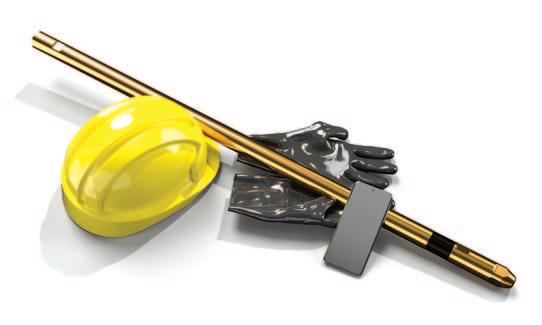 By Manochehr Oliazadeh
By Manochehr Oliazadeh
Modern miner
32 In a traditionally maledominated industry, Mary-Jane Piggott creates opportunities for women to succeed
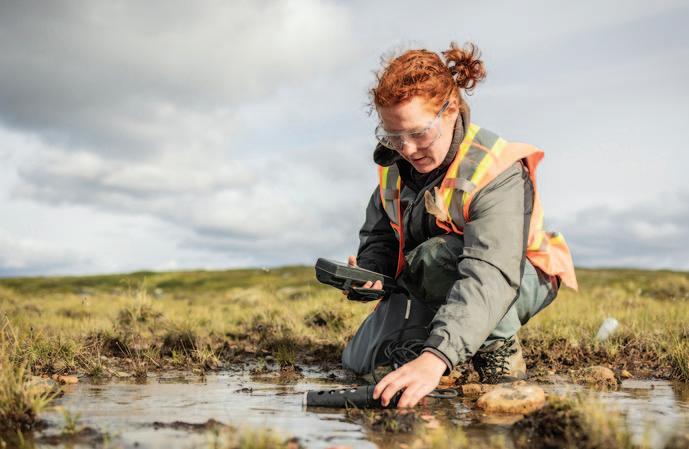 By Alice Martin
By Alice Martin
Pilot projects
34 Ammonia removal pilot projects seek to take on the challenges of biological wastewater treatment at mine sites
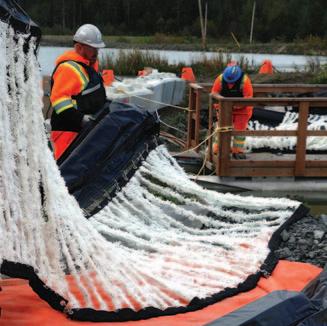 By Sarah St-Pierre
By Sarah St-Pierre
37 Following nearly two years of testing its autonomous haulage system at the Roy Hill iron ore mine, ASI Mining is ready to deploy its agnostic AHS technology to any mine fleet in the world
By Mehanaz Yakub40 Geoscientist Robert Horn says Canada has the tools needed to help develop Ukraine's metal and mineral resources
By Ailbhe GoodbodyCIM news
54 CIM launches new cloud-based mentorship program
By Sara King-AbadiContenu francophone
56 Table des matières
56 Lettre de l’éditeur
57 Mot du président
Article de fond
58 À la croisée de deux industries
L’officialisation de l’exploitation minière artisanale et à petite échelle : une étape nécessaire pour répondre à la demande mondiale en minéraux critiques
Par Kelsey Rolfe
Les actualités
63 Québec investit pour valoriser les résidus miniers amiantés
Par Alice Martin

The test of time
It has been almost exactly a decade since the last time we dug into the topic of artisanal and small-scale mining (ASM) in CIM Magazine. In 2013, the run up in gold prices following the global financial crisis drew an enormous number of people in to the ASM sector. Despite its notoriety for poor safety, environmental practices and labour standards, the sector has been a key source of income for communities for generations and employs vastly more people than industrial-scale mining, often in areas where mining companies look to develop or grow their own operations.
The conflicts that resulted between small-scale miners and the industrial miners working the same deposits generated headlines and lawsuits. The unknown number of ASM miners who lost their lives in accidents and mine collapses did not.
At the time we explored this subject, we struggled to find mining companies that were prepared to talk about this thorny issue.
To its credit, Barrick Gold was willing to offer comment. The representative highlighted some of the work done to help lower the tension at its North Mara mine in Tanzania, but also conceded that finding a workable solution that improved safety, security and environmental practices, while reconciling the two sectors, was incredibly complex.
Ten years later, Barrick is still confronting these challenges and legal fallout from its unresolved conflict with artisanal miners in Tanzania.
In the feature for this issue, “Two industries at a crossroads” (p. 42), regular contributor Kelsey Rolfe provides a progress report of a kind.
Formalization, a framework for standards in the ASM sector that could begin to address the risks of the ASM sector, remains an elusive goal. A key advance has been the establishment of a diamond-buying program by De Beers. It is instructive both in how it works and for the enduring commitment required to make it work.
The role of cobalt in the energy transition, and the significant contribution the ASM sector makes to the overall output of the critical mineral, has reinvigorated the discussion of formalization. Manufacturers want to demonstrate their commitment to sustainable practices, yet at the same time, cutting out cobalt produced from small-scale miners could create a supply crunch soon.
A stamp of approval for artisanally sourced cobalt could be an important victory.
As the story details, such an outcome will only come from a sustained, multi-year effort. Up until now, the challenge has just been that there are few who have had the opportunity and persistence to commit that time and effort.
Ryan Bergen, Editor-in-chief editor@cim.org @Ryan_CIM_Mag
Editor-in-chief Ryan Bergen, rbergen@cim.org
Managing editor Michele Beacom, mbeacom@cim.org
Senior editor Ailbhe Goodbody, agoodbody@cim.org
Section editor Silvia Pikal, spikal@cim.org
Editorial intern Alice Martin, amartin@cim.org
Contributors Sara King-Abadi, Alexandra Lopez-Pacheco, Tijana Mitrovic, Manochehr Oliazadeh, Kelsey Rolfe, Sarah St-Pierre, Mehanaz Yakub
Editorial advisory board Mohammad Babaei Khorzhoughi, Vic Pakalnis, Steve Rusk, Nathan Stubina
Translations Karen Rolland, karen.g.rolland@gmail.com
Layout and design Clò Communications Inc., communications.clo@gmail.com
Published 8 times a year by:
Canadian Institute of Mining, Metallurgy and Petroleum 1040 – 3500 de Maisonneuve Blvd. West Westmount, QC H3Z 3C1 Tel.: 514.939.2710; Fax: 514.939.2714 www.cim.org; magazine@cim.org
Advertising sales Dovetail Communications Inc.
Tel.: 905.886.6640; Fax: 905.886.6615; www.dvtail.com
Senior Account Executives
Leesa Nacht, lnacht@dvtail.com, 905.886.6640 ext 321
Dinah Quattrin, dquattrin@dvtail.com, 905.886.6640 ext 308

Neal Young, nyoung@dvtail.com, 905.886.6640 ext 306
Subscriptions
Online version included in CIM Membership ($197/yr). Print version for institutions or agencies – Canada: $275/yr (AB, BC, MB, NT, NU, SK, YT add 5% GST; ON add 13% HST; QC add 5% GST + 9.975% PST; NB, NL, NS, PE add 15% HST). Print version for institutions or agencies – USA/International: US$325/yr. Online access to single copy: $50.
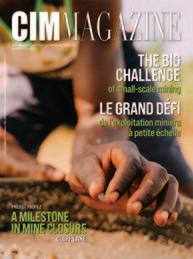
Copyright©2023. All rights reserved.
ISSN 1718-4177. Publications Mail No. 09786. Postage paid at CPA Saint-Laurent, QC.
Dépôt légal: Bibliothèque nationale du Québec. The Institute, as a body, is not responsible for statements made or opinions advanced either in articles or in any discussion appearing in its publications
2020 2021 2022

DISTINGUISHED LECTURERS 2023-2024

THE PROGRAM
The Distinguished Lecturers program is offered to 31 CIM Branches, 11 Technical Societies and 8 Student Chapters. Universities can also request a lecture.
The CIM Distinguished Lecturers program started in 1968 and has continuously provided a lineup of individuals who have shared their knowledge with the mining community for over five decades.


Every year, the lecturers are elected by their peers through the CIM Awards program and hold the title for a complete season (September to June).
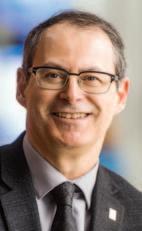


CIM is privileged to count more than 260 of the industry’s finest as its lecturers. Because the motto “once a lecturer, always a lecturer” defines our pride and dedication in ensuring that the learning curve is endless, a complete list of past lecturers is available at www.cim.org, where you can benefit from the ever-growing pool of expertise that the program has to offer.
LECTURERS ARE AVAILABLE FOR YOUR ONLINE OR IN-PERSON EVENTS.


A commitment to our shared future

News of climate-related events all around the world, including the recent tragic fires in Maui, remind us that we are all stakeholders when it comes to the effects of climate change. As we stand at the intersection of climate responsibility and the needs of our diverse stakeholders and land rights holders, the mining industry is presented with both a challenging journey and a remarkable opportunity. The year 2023 has thrust upon us an undeniable reality: the climate crisis is no longer a distant concern but an urgent call for collective action. The extreme heatwaves and forest fires that have swept across Canada this year serve as potent reminders that the impacts of climate change are no longer a future scenario, they are our present reality.
Our industry cannot remain insulated from these seismic shifts. As the chief financial officer at B2Gold Corp., a senior gold producer committed to responsible mining, I am acutely aware of the dual challenge we face: to drastically reduce our greenhouse gas emissions and mitigate our climate impacts while simultaneously nurturing the prosperity of our employees, local communities, host governments and the environment in which we operate.
At B2Gold, like many other mining companies, we are embracing this challenge by setting a target to reduce our greenhouse gas emissions by 30 per cent by 2030. Yet, setting targets is only the first step in a long and complex journey. Our industry, by its very nature, is energy-intensive and often operates in remote corners of the world. The pursuit of renewable energy sources, the electrification of our operations and advancements in energy efficiency are at the forefront of our industry’s strategy. However, many technologies still require significant advancement or adequate market conditions before they can become technically or economically feasible for implementation. The road ahead is far from simple, and as such, our industry’s efforts to transition to low-carbon operations demand ambition, innovation and determination.
In our pursuit of emissions-reduction targets, we are not simply forging a path towards a more sustainable future, we are also honouring our commitment to our stakeholders and our communities. The mining industry, rightly so, is a beacon of economic progress, providing jobs, revenue and investments to countries and regions worldwide. Our obligation lies in ensuring that our emissions-reduction pathways are crafted with sensitivity to the needs of our employees, communities and governments. We recognize the right of nations to harness their resources for development, and it is our duty to facilitate this while maintaining our climate obligations.
The challenges our industry faces are formidable, but they are not insurmountable. The dynamic landscape of the climate transition compels us to adapt continuously and seek new avenues, technologies and partnerships. While the path may be uncertain, I am confident that the mining industry can, and will, respond effectively to the climate crisis. Our resilience is our strength, and our commitment to innovation and responsibility is unwavering.
As we navigate the climate transition, we are not just protecting our environment, we are also nurturing the livelihoods of our communities and the future of generations to come. Our commitment to climate responsibility is, at its core, a commitment to our shared future—one that is inclusive, resilient and sustainable.
Mike Cinnamond CIM President
“I am confident that the mining industry can, and will, respond effectively to the climate crisis.”
Versatile mapping tool
Quantum Systems’ Trinity Pro is an electric fixed-wing mapping drone for mines and large areas of up to 700 hectares. The drone has an optimal cruise speed of 17 metres per second and a maximum flight time of 90 minutes. The Trinity Pro comes with six fully integrated cameras, including RGB, oblique, multispectral and LiDAR cameras. Quantum Systems stated that the cameras help create 3D models of mine sites, which are used to monitor progress and identify potential hazards. The Trinity Pro can also be used for stockpile measurement using photogrammetry to calculate volume and weight.

High accuracy total station

Trimble Inc.’s SX12 scanning total station is an integrated system that combines surveying, imaging and 3D-scanning capabilities. With its high-power laser, users can stake out mine features, then scan to collect georeferenced point cloud data. The SX12’s eyesafe laser pointer has a diameter of three millimetres at 50 metres, which the company said is the smallest spot size in the industry. According to Trimble, the SX12 can boost accuracy and speed when performing volumetric surveys, including overbreak and underbreak comparisons. In April 2023, the SX12 was upgraded with Wi-Fi HaLow radio technology, providing up to 14 times higher bandwidth than long-range radio, which Trimble said allows for a more reliable and robust connection.
All-terrain robot for hazardous environments
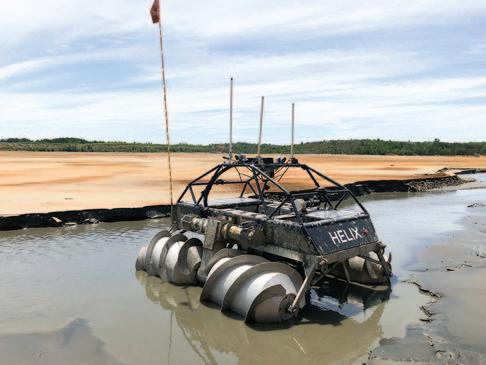
Copperstone Technologies Ltd.’s HELIX Neptune is a 400kilogram amphibious robot that collects data and water samples from tailings storage facilities. Copperstone’s scroll-drive propulsion system allows the HELIX Neptune to move on many types of terrain, including mud, tailings, snow, ice and water. Since its release in September 2021, the HELIX Neptune has been upgraded from two to four cameras, which provide a 360-degree view on all aspects of the rover when in use. It was also upgraded with an increased battery capacity, a telemetry range of up to eight kilometres, a Wi-Fi range of 2.5 kilometres and now includes autopilot on all types of terrains.
Precise and reliable borehole surveying

Stockholm Precision Tools AB recently launched its GyroLogic Evo, a downhole directional survey tool intended for borehole surveying. The solid-state gyroscope’s continuous mode allows for rapid surveying with data points registered at centimetre intervals. The GyroLogic Evo is designed to work in magneticallydisturbed environments, reducing the risk of magnetic-induced errors while in operation. Bluetooth enables the tool to be operated remotely and it has a battery capacity of 12 hours.
Compiled by Alice MartinDevelopments
Space sample could answer questions about asteroid mining
On Sept. 8, 2016, the OSIRIS-REx spacecraft began its journey to Bennu, a dark and ancient asteroid thought to have formed over 4.5 billion years ago. The NASA mission is the Canadian Space Agency’s (CSA) first participation in an asteroid sample-return due to its contribution of the OSIRISREx Laser Altimeter (OLA), a laser system utilized by the spacecraft to create a 3D model of Bennu’s surface, which allowed (continued on page 13)
Recovery teams participate in helicopter training in July in preparation for the retrieval of the sample return capsule from NASA’s OSIRIS-REx mission, at the U.S. Department of Defense’s Utah Test and Training Range.
of
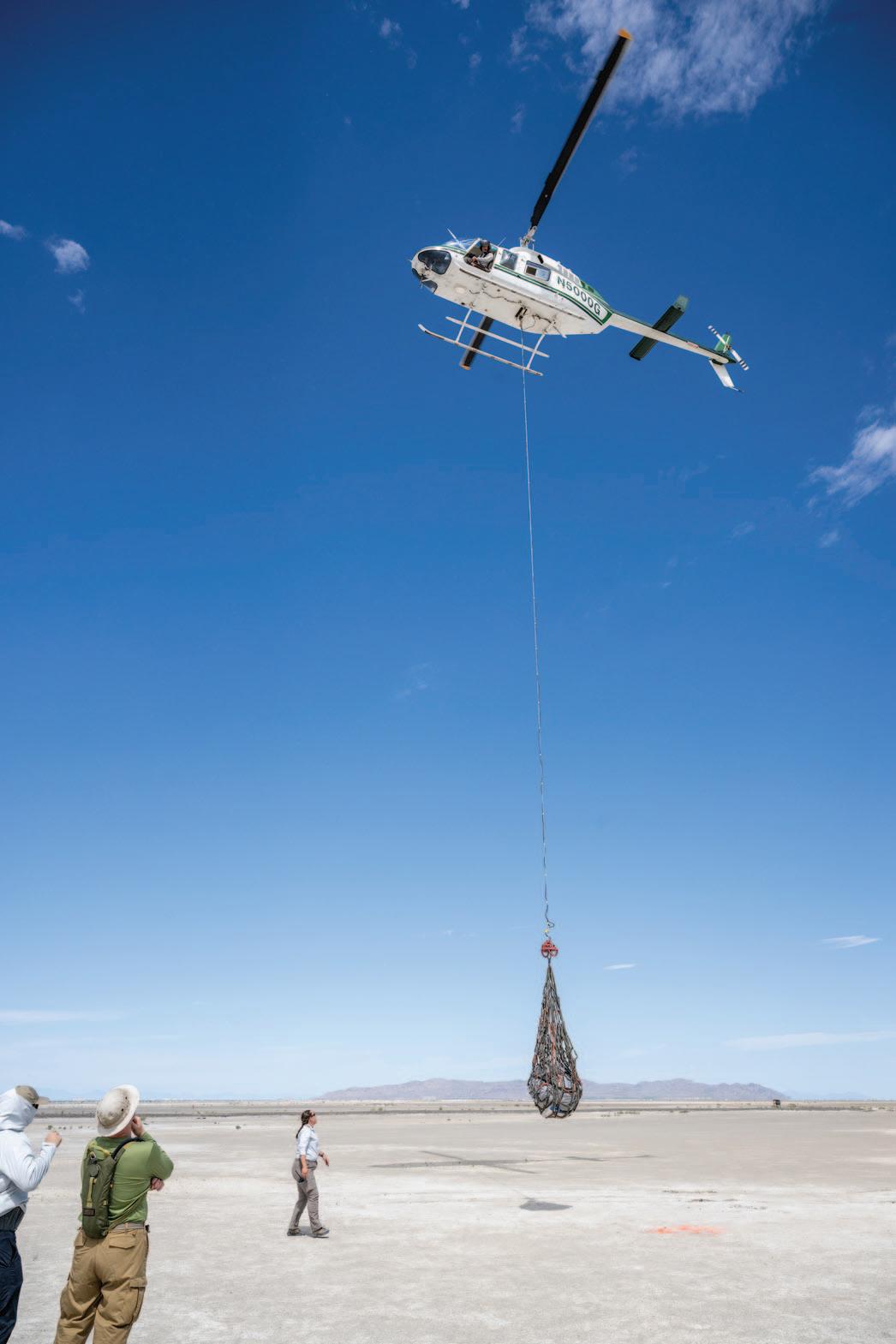
scientists to pick the best sample site for the mission. A sample was successfully collected from Bennu in October 2020 and the spacecraft will return to earth on Sept. 24, 2023, when its sample capsule will parachute down into the Utah desert.
Moving the dial forward
Mining companies find appeal in the comprehensiveness of United Nations sustainability goals
By Tijana MitrovicWhen Barrick Gold Corporation published its 2022 Sustainability Report in April of this year, the United Nations (UN) sustainable development goals (SDGs) were front and centre. It was another recent example of mining companies turning to the SDGs to go above and beyond environmental, social and governance (ESG) frameworks and disclosures.
“By using the SDGs as the skeleton for our reporting, we are better able to apply an integrated and holistic approach to sustainability management, and to avoid a siloed-thinking and mere box-ticking approach that can be a consequence of taking an ESG-compliance-driven approach,” explained the Barrick report.
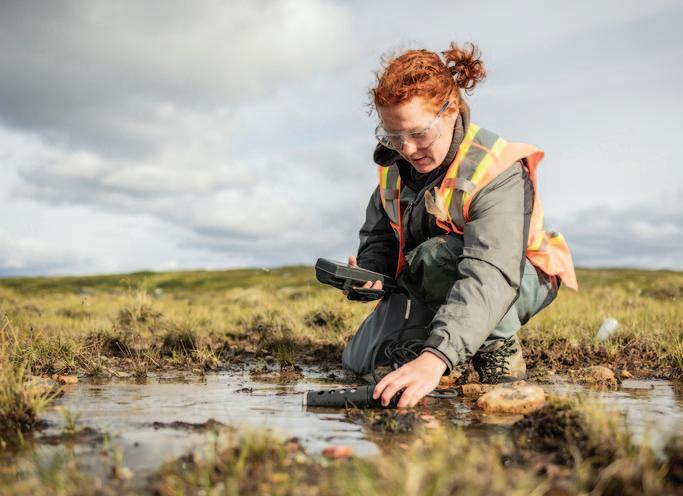
Established in 2015, the SDGs are 17 interrelated goals that present a blueprint to achieve a more equitable and sustainable future by 2030 through addressing global challenges related to poverty, climate change, inequality and more.
In April 2023, the UN declared that “just 12 per cent of the SDG targets are on track” and urged decisive action to correct the course and meet the 2030 deadline. Due to its impact on the environment and local economies worldwide, the mining industry can contribute to the achievement of, and even lead the way on, many of the goals, according to the UN.
While there is no SDG that explicitly refers to mining, the industry can use
Due to the CSA’s contribution to OSIRISREx, Canada will receive a portion of the asteroid material. First discovered by scientists in 1999, Bennu is carbon-rich and will contain chemicals and rocks from the birth of the solar system
Developments
many of the goals to evolve its ESG reporting. According to Patrick Drouin, senior vice-president of investor relations and sustainability at Wheaton Precious Metals, which committed to supporting the SDGs in 2019, a significant benefit for mining companies of following the SDGs is that the goals help outline a holistic framework where companies can incorporate multiple SDGs and address multiple issues at once instead of using a one-by-one or piecemeal approach.
Agnico Eagle Mines is another company using the SDGs as part of its sustainability reporting. It first communicated its alignment with the goals in 2017. “We took the step to start aligning all of the work that we were doing that was contributing to the sustainability of communities and society with the framework set out by the UN SDGs,” said Melanie Plante, a sustainability performance and engagement manager at Agnico Eagle in an interview with CIM Magazine.
For Agnico Eagle, the goals provide a direction for its approach to sustainability and represent a common goal for
beneath its deeper-than-pitch-black surface. NASA is hopeful that the asteroid will also contain platinum and gold, and that studying it will determine if asteroid mining during deep-space exploration and travel is feasible. – Silvia
Pikalthe industry to work towards together. According to Plante, the SDGs are bigger than one company or the industry: they represent an opportunity for collective action to build a better future and provide concrete ways to contribute to that goal, as well as the inspiration to push further. “It requires us to look at how we tackle certain issues, and it pushes the boundaries of best practice,” Plante said. “It means every year we have to sort of level up what we do to go further.”
Agnico Eagle recently partnered with the Quebec government to use non-acidgenerating tailings from its Goldex gold mine to rehabilitate the abandoned Manitou site in northwestern Quebec. The rehabilitation directly connects to SDG 15, which respectively sets targets to ensure that water and sanitation are available and sustainably managed and to protect, restore and promote sustainable use of terrestrial and inland freshwater ecosystems. Plante described it as a “win-win partnership” in contributing to the SDGs.
More mining companies are following suit. Teck, for example, committed to
From the wire
Compiled by Alice MartinOsisko Gold Royalties has named Paul Martin as interim chief executive officer to replace Sandeep Singh, who left the position after three and a half years. Martin has held CEO and chief financial officer roles in the mining industry and currently serves as chair of the board at Red Pine Exploration. Osisko Gold Royalties stated it is still looking for a permanent CEO.
Lucara Diamond Corp. reappointed William Lamb as CEO, president and a director of the company, after Eira Thomas stepped down from the position, which she has held since 2018. Lamb previously held the position of CEO at Lucara Diamond from 2011 to 2018 and has more than 25 years of experience in mining project development and operations.
Taurus Gold Corp. appointed Frank Lagiglia as CEO and director, effective Sept. 1. Lagiglia has a background in corporate development and investor relations, as well as more than 20 years of experience in the capital markets and mining sector working with multiple mineral exploration and production companies.
The Mining Innovation Commercialization Accelerator (MICA) named Chamirai Charles Nyabeze as network director. Nyabeze is a co-founder of MICA and was previously MICA’s vice-president of business development and commercialization. For the past 11 years, he has also worked for the Centre for Excellence in Mining Innovation, where he is currently vice-president of business development.
Mich Resources Ltd. appointed Geoff Balderson as CFO. Balderson serves as the CFO and director of several publicly traded companies in various industries and is the founder and president of Harmony Corporate Services. He has been involved in the capital markets for 25 years and has a background in corporate compliance.
Samir Patel, general counsel and corporate secretary at First Mining Gold Corp., will leave his role to pursue another opportunity in the mining industry. Lisa Peterson, the company’s CFO, will assume corporate secretary duties on an interim basis.
aligning its sustainability strategy with the SDGs in 2022. One of its initiatives that contributes to the SDGs is its aim to become “nature positive by 2030” (an emerging framework focused on “[halting] and [reversing] the destruction of nature by 2030,” as described by the World Economic Forum). This framework will help Teck align with SDG 15, which is focused on sustainable land use. To meet this goal, Teck stated on its website that it plans to work with local partners, Indigenous peoples and communities to conserve ecologically and culturally significant lands. As an example of taking action, the company made a $10 million donation in June to Chile’s Protected Marine Areas Program with a focus on the Juan Fernández Archipelago, which is a UNESCO Biosphere Reserve and is “one of the most threatened ecosystems in the world.”
Mining companies not only have a responsibility to reduce environmental impacts and, according to the UN, ensure that when they “generate profits, employment and economic growth in low-income countries,” those benefits extend beyond the life of mine, but they may also find that existing organizational goals are already aligned with the SDGs. For example, mining for critical metals and minerals is needed for SDG 13 on climate action, which sets a target of achieving 40 to 45 per cent greenhouse gas emission (GHG) reductions below 2010 levels by 2030 and achieving netzero GHG emissions by 2050. “If you’re going to hit climate action, you’re not going to do that without copper, lithium, cobalt,” Drouin told CIM Magazine.
Another area where the industry is aligned with the SDGs, Drouin said, is goal 10, which aims to reduce income inequalities. “To me, mining is the best way to transfer wealth from the more affluent urban areas into the rural areas that don’t get resources,” he said. “That’s where mining shines. You’re not going to put a silicon chip plant in rural Mexico, but [you’re going to put a mine there] if there’s gold. And that will bring economic benefit to that region [through] job creation, economic growth, community infrastructure and funding for social programs. All that is crucial.”
However, there are challenges when following the SDGs, which include measuring the impact of policies and practices, Drouin explained. “[The impact] is not always quantifiable, but you want to
make sure that you’re getting the biggest benefit out of the efforts you’re putting in.” He said that the move towards an increased regulatory environment in some jurisdictions around the world may prevent miners from moving the dial forward on the goals.
There are also external challenges at play. Drouin said that while more permits and regulations that limit mining may give the illusion of protecting the environment, it comes at the trade-off of economic benefits that alleviate poverty and food insecurity and improve health and well-being and contribute more to the region. “Mining plays a crucial role, so it’s always concerning when you see increased regulatory permitting that causes roadblocks,” he said. “When done right, mining can tackle 16 of the 17 SDGs. And it does disturb the land. There’s no doubt. [But], you can do it responsibly and tackle everything else.”
While several mining companies are taking action, a 2020 report from the Responsible Mining Foundation, called “Mining and the SDGs: a 2020 status update,” stated that adoption across the mining industry needs to be higher to tackle the SDGs. The report, which reviewed 38 large-scale mining companies worldwide on their policies and practices, declared that systematic actions across the 17 SDGs were “largely lacking” and that “no one company is showing comprehensive actions to address all 17 SDGs.”
The report found four goals on which mining companies were taking the least action: SDG 3 on good health and wellbeing, SDG 5 on gender equality, SDG 6 on clean water and sanitation and SDG 14 on life below water. In addition, the report posited that while some companies strongly emphasize those goals as priorities, SDG 3 and 6 are “both among the most frequently prioritized SDGs, but show some of the weakest levels of action by mining companies.”
To reach the goals by 2030 and even beyond, the report stated that action must be the top priority. “[The goals] provide ambition, but if we don’t have action, it’s not going to make a difference,” Plante stated. “It’s great to say that we are aligned with the goals and we have targets in certain areas, but if we cannot demonstrate action, and if we’re not implementing initiatives on the ground, we’re never going to make steps towards those goals.” CIM
Health check
Formerly injured workers in sectors such as construction and mining in Ontario are more at risk of opioidrelated harms than workers in other sectors, according to findings emerging from the Opioid-related Harms Among Ontario Workers study.
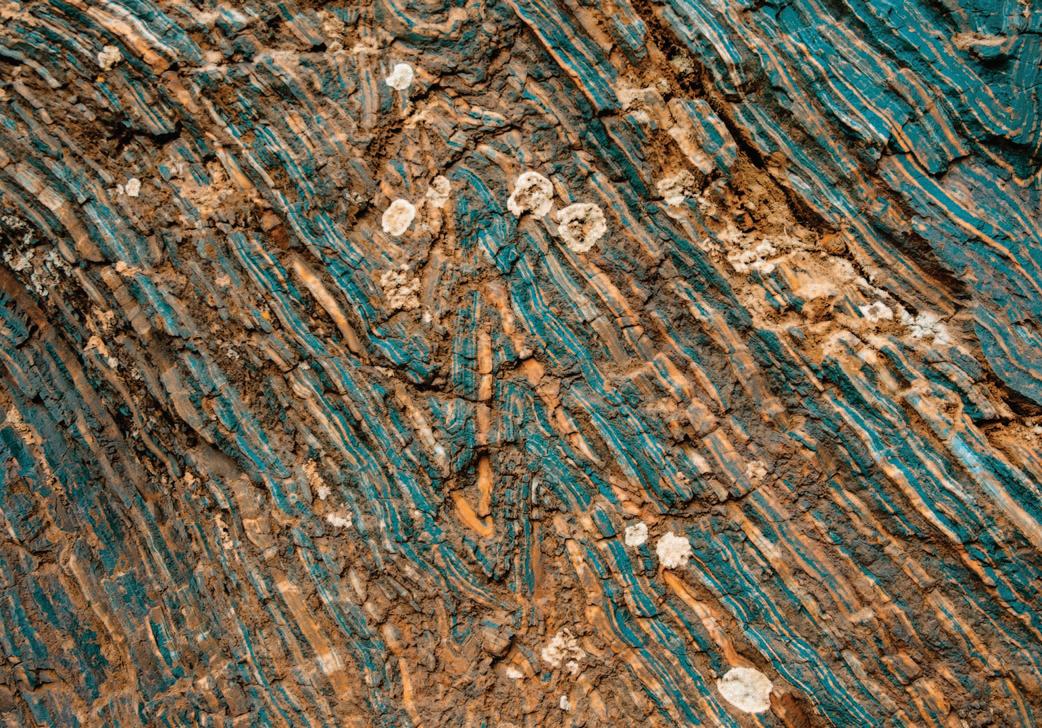
The ongoing research project is being conducted by the Institute for Work & Health and the Occupational Cancer Research Centre at Ontario Health. The project was created to better understand which worker groups are most affected by Canada’s opioid crisis. According to the Public Health Agency of Canada, more than 36,000 people in this country have died from apparent opioid toxicity deaths between January 2016 and December 2022.
The co-leads on the study, Dr. Jeavana Sritharan, scientist at the Occupational Cancer Research Centre, and Dr. Nancy Carnide, scientist at the Institute for Work & Health, described the findings to CIM Magazine
“When we’re looking at opioidrelated harms, what we see is that it tends to be men of working age that have been disproportionately affected by the opioid crisis,” Carnide said.
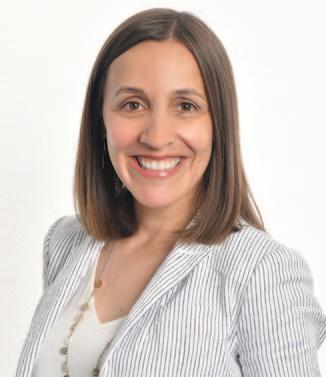

Sritharan explained that opioid-related harms include poisonings (when someone takes too much of an opioid drug) and
mental/behavioural disorders (this includes withdrawal or intoxication).
Carnide said that most of what is known about the role of occupation in opioid-related harms has come from studies in the U.S.
In Canada, empirical data on occupation among those affected by the opioid
crisis has been limited, Carnide said. To address this gap, the project is looking at data from 1.7 million Ontario workers who have been injured on the job and were recorded in the Occupational Disease Surveillance System (ODSS), which is designed to identify and monitor trends in work-related disease in the province. The study focuses on opioidrelated visits to the emergency department and hospitalizations.
“You can imagine that someone who has a workplace injury, depending on the nature of the injury, can experience quite a bit of pain; poor mental health; and pressures to return to work,” Carnide said. “It creates the environment and the risk factors for potentially developing a [substance] use disorder because they need pain management.”
She added that other factors could include working in a male-dominated environment, where there are gender norms present that encourage “toughing it out” and working through the pain; a stigma that prevents workers from disclosing they are struggling with pain from injury or substance use; and challenging aspects of the work environment, from stress to job insecurity.
July 12 webinar hosted by the CIM Management and Economics Society.
Consolidation
Pletcher stated in the presentation that since the gold industry is the most fractured of all the metal commodities, gold consolidation has emerged as a strong trend in the past four years.
He referenced Barrick Gold’s nopremium deal with Randgold in 2019, which was followed by Newmont’s acquisition of Goldcorp in the same year, as deals that established both companies as major players in the gold sector.
The researchers explained that they focused on two different comparisons among workers between 2006 and 2020: rates of opioid-related harms among workers in the ODSS compared to workers in the general Ontario population, and opioid-related harms compared between workers within the ODSS.
The study found that when compared to the general population of Ontario, the ODSS group has a risk of emergency department visits for opioid-related poisonings that is 2.41 times higher than the general population and a risk of hospitalization for opioid-related poisonings that is 1.54 times higher.
According to the ODSS data, the workers who are most at risk of opioid-related harms when compared to the general Ontario population included those who work in the construction and trades, materials handling, processing (minerals, metals, chemicals), machining, transport, mining, medicine and service industries.
“It tended to be traditionally blue collar, physically demanding jobs for the most part,” Carnide said. “It does seem to suggest that there are particular groups of workers in certain occupations that tend to be at a higher risk of developing opioid-related harms.”
The results were similar when comparing occupational groups within the ODSS. The researchers theorized that the role of workplace injuries is a significant factor in developing opioid-related harms.
When asked about the mining industry specifically, Carnide said mining jobs in Ontario typically occur in rural communities where workers may not have the same access to pain management programs found in more urban centres.
“We need to think about the role that the workplace can play in helping to address the opioid crisis,” Carnide said. “By bringing awareness to the fact that there are certain workplaces that should be aware of this, we can use the workplace as a point of intervention.”
“It is a much bigger public health crisis than I think most people understand right now,” Sritharan said. “The pandemic also exacerbated that. There’s a lot of work to do beyond what we’re doing right now—even just increasing worker awareness. That’s what we’re hoping to do with this project.”
The study’s key findings were presented at an Institute for Work & Health webinar on June 13 and can be viewed through iwh.on.ca/events.
– Silvia PikalThe mining industry’s top transactional and legal trends
Consolidation, environmental, social and governance (ESG)-driven transactions, Indigenous consultation and resource nationalism were four key trends that Fred R. Pletcher, chair of the Mining Group and a partner in the Securities and Capital Markets Group at Borden Ladner Gervais LLP, noted have defined the global mining industry recently. Pletcher was the featured presenter at a
Other significant deals in this arena identified by Pletcher included Newcrest’s acquisition of Pretium Resources— the Vancouver-based miner that operates the Brucejack mine in northwest B.C.—in 2021, the merger between Agnico Eagle and Kirkland Lake Gold in 2022 and earlier this year, Newmont’s acquisition of Newcrest.
“The top 10 producers in the gold industry only generate 28 per cent of the production, which is very different than more concentrated commodities, like iron ore, nickel or zinc,” he said. “Gold was an area crying out for consolidation.”
Copper
Copper deals outpaced gold mergers and acquisitions (M&A) in 2022 for the first time in four years with US$14.24 billion in total value. Big copper deals Pletcher noted included Rio Tinto’s acquisition of Turquoise Hill Resources in 2022, BHP’s takeover of OZ Minerals, which was finalized in May, and Glencore’s sale of its CSA copper mine in New South Wales, Australia, to Metals Acquisition Corp, which closed in June.
This year has seen its own copper rush, due to Glencore’s multiple unsolicited attempts to purchase Teck Resources and Hudbay Minerals’ acquisition of Copper Mountain Mining Corporation.
“That’s all been made easier by recent extremely strong copper prices, which has really given a lot of firepower to the copper players and allowed them to afford some of these acquisitions,” Pletcher said.
Due to U.S. President Joe Biden’s Inflation Reduction Act, which was passed in August 2022, American automakers have also increasingly entered transactions with lithium producers to secure supply. This includes Canadian miner Nemaska Lithium’s recent deal with Ford, announced in
“We need to think about the role that the workplace can play in helping to address the opioid crisis.”
– Dr. Nancy Carnide, scientist at the Institute for Work & Health
May, to supply lithium products over an 11-year period.
A seller-friendly market
Pletcher described the current mining industry as a seller’s market, but due to the large number of parties interested in purchasing, pressure is being put on sellers when it comes to due diligence and exclusivity.
Pletcher also mentioned the recent increase in syndicated acquisitions in the mining industry, noting the joint acquisition of Yamana Gold by Pan American Silver and Agnico Eagle in March. He said syndicated acquisitions can be mutually beneficial for companies and help fund large transactions, but they also add closing risks and the risk of multiple negotiations.
Pletcher added that another impediment to transactions is M&A activism— or when shareholders use their ownership leverage to influence the structure of a transaction. He emphasized the importance of shareholder engagement in defending against M&A activism.
ESG-driven transactions
“In the last year, we’ve seen enormous ESG-driven transactions amongst some of the largest players in the industry,” Pletcher said.
He stated that the “poster child” for this trend is Teck Resources proposing to spin off its steelmaking coal business into a separate publicly traded company.
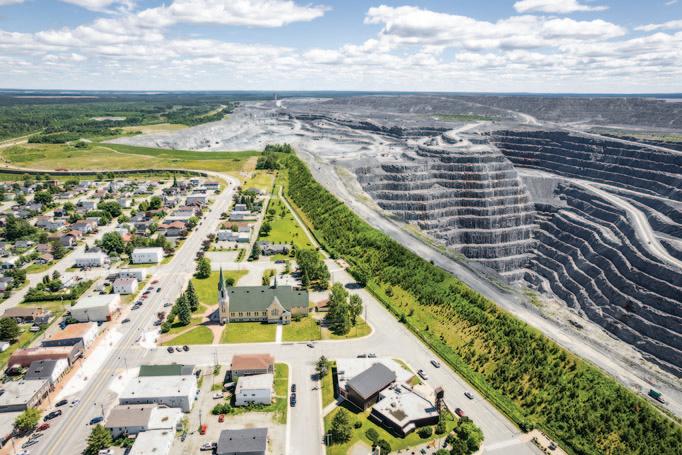
Pletcher added that companies may be forced into a transaction due to events that pose a threat to ESG principles.
“With the war between Russia and Ukraine, western companies [are forced to] exit Russia, and Kinross, unfortunately, had to sell its Russian assets at a deeply discounted price to [the Highland Gold Mining Group],” he explained. “Similarly, Tahoe Resources took a hit in [its] share price following a court-ordered shutdown at [its] Escobal mine in Guatemala to permit Indigenous consultation.” Pan American Silver seized the moment to buy Tahoe Resources shortly afterwards, completing the transaction in February 2019.
Indigenous consultation
The Tahoe Resources shutdown is a notorious example of the impact a failure to consult with local Indigenous communities could have on mining operations.
In 2021, Canada’s federal government incorporated the United Nations Declaration on the Rights of Indigenous Peoples (UNDRIP) into law to support Indigenous rights to self-determination, as did the B.C. government in 2019.
UNDRIP includes a principle that stipulates Indigenous groups are entitled to “free, prior and informed consent” (FPIC) when a government is contemplating actions that might affect them negatively.
“Early statements from the federal government have been that FPIC doesn’t mean veto; what it means is meaningful
Developments
in-depth consultation,” Pletcher said. “Aboriginal consultation rates in Canada may change with the adoption of UNDRIP, but they’re only changing in one direction, in that they’ll be more robust.”
Increased mining nationalism
Countries are increasingly turning to state ownership for their natural resources. Pletcher stated that Mexico and Chile have been at the forefront of mining nationalism.
In April 2022, Mexico nationalized its lithium industry, despite having no producing mines. On May 8 of this year, Mexico also approved several mining reforms, including reserving most new mineral exploration activities to the Mexican state and requiring all new mining concessions to be granted pursuant to a public tendering process.
“So even if you held the exploration concessions, you may not be the company that ends up developing and operating those concessions,” Pletcher explained.
The reforms also introduced Indigenous consultation requirements, as well as environmental safeguards. Chile, the second-largest producer of lithium in the world, nationalized its lithium industry on April 20 of this year.
“The pendulum is swinging towards mining nationalism, away from mining investments,” added Pletcher. “Companies should be cautious when they’re operating outside of tier one established mining jurisdictions with a rule of law, and maybe even when they’re within those jurisdictions.” – Alice Martin
Battery X Metals Inc. named Alain Moreau as exploration manager of lithium properties and Brodie Gunning as senior manager of battery recycling. Moreau has more than 35 years of experience in exploration innovation, program management and corporate leadership, while Gunning has a background in battery storage, electric vehicle infrastructure and charging technologies across Asia and the Americas.
Powerstone Metals Corp. named Zachary Goldenberg, an existing board director and significant shareholder of the company, as CEO. Goldenberg is an executive, lawyer and corporate director with experience in public markets and corporate finance and also sits on the board of directors of several public and private companies.
Critical Minerals Market Review 2023 Highlights
The International Energy Agency (IEA) released its first annual “Critical Minerals Market Review 2023” in July, in which it noted unprecedented growth in the critical minerals market up and down the supply chain due to the energy transition. The report stated that global exploration spending rose by 20 per cent, exploration for nickel by 45 per cent and for lithium by 90 per cent in 2022. The search for new lithium and nickel deposits helped make Canada and Australia top jurisdictions for exploration spending—both saw a 40 per cent increase over the year before.
Compiled by Silvia PikalCANADA
In November 2022, General Motors Co. signed a long-term offtake agreement to receive 25,000 tonnes of batterygrade nickel sulfate annually from Vale’s proposed nickel sulfate facility in Bécancour, Quebec, with delivery starting in the second half of 2026.
UNITED STATES
Lithium-ion battery demand in the U.S. grew by about 80 per cent in 2022, due to SUVs still ruling the U.S. market, which require a larger battery.
In February 2023, Ford Motor Company announced it will build a US$3.5 billion electric-vehicle battery factory in Michigan.
Chile, the second-largest producer of lithium in the world, nationalized its lithium industry on April 20, 2023.

CANADA
In May 2023, General Motors Co. and South Korean company Posco Future M Co., Ltd. secured $300 million in funding from the provincial and federal governments to build a new electricvehicle battery component plant in Bécancour.
UNITED STATES
Critical mineral start-ups raised a record US$1.6 billion in 2022, bringing the critical minerals category to four per cent of all venture capital (VC) funding for clean energy. In 2023, battery recycling was the largest recipient of VC funding for clean energy, followed by lithium extraction and refining technologies. Companies based in the U.S. raised 45 per cent of the total funds between 2018 and 2022.
MEXICO
In April 2022, Mexico nationalized its lithium industry, despite having no producing mines. On May 8, 2023, Mexico also approved several mining reforms, including reserving most new mineral exploration activities to the Mexican state and requiring all new mining concessions to be granted pursuant to a public tendering process.
CHINA
Between 2018 and the first half of 2021, Chinese companies invested US$4.3 billion to acquire lithium assets outside of China, twice the amount invested by the U.S., Australia and Canada combined during the same period. While China is a global leader in lithium processing and refining, it still sources the bulk of its raw lithium products from beyond its borders, according to data from S&P Global Market Intelligence.
AUSTRALIA
In February 2022, Liontown Resources signed a five-year lithium supply deal with Tesla to provide 100,000 tonnes of lithium-spodumene concentrate in 2024 and to increase that annual amount to 150,000 tonnes in the following years.
China accounted for about 60 per cent of global electric car sales in 2022.
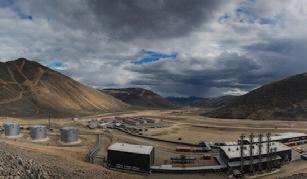
A protocol for diversity
New Towards Sustainable Mining protocol builds on industry commitment to attain high EDI standards
By Alice MartinIn December 2020, the Mining Association of Canada (MAC) and its members put out a statement that denounced all forms of discrimination, racism and sexism, as well as recommending actions for the Canadian mining industry to take in the hopes of eliminating them.
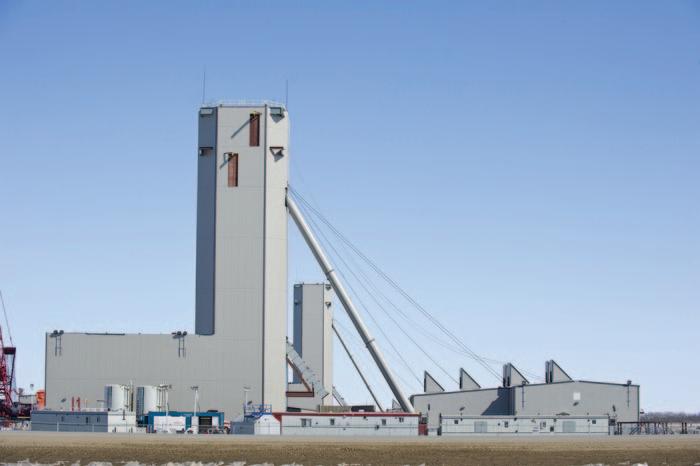
More than two years later, the original statement has been used as inspiration for MAC’s newest reporting protocol—the Equitable, Diverse, and Inclusive Workplaces protocol—in its Towards Sustainable Mining (TSM) program, which requires participation from mining companies that are members of MAC, as well as members of other mining associations that have adopted the program. The TSM program is meant to assist mining companies in improving their environmental and social practices.
Katherine Gosselin, director of the TSM program at MAC, told CIM Magazine that it has received unanimous support from its members for the protocol, which was launched in June and sets out requirements for mining companies to improve equity, diversity and inclusion (EDI) performance.
The protocol will measure mining companies’ performance on EDI using three indicators: 1) leadership and strategy; 2) advancing equity, diversity and inclusion; and 3) monitoring, performance and reporting.
“Then those indicators are themselves made up of detailed criteria [that assign] different levels of performance from Level C to Level AAA,” Gosselin said. “We consider [achieving a minimum of] Level A to be good practice.”
One of Level A’s criteria in the first indicator requires companies to have a corporate commitment and strategy on EDI that is communicated to workers, and they must update their board on progress towards implementation. Companies also need to have training or
awareness programs related to equity, diversity and inclusion available to all workers and management to attain Level A at the second indicator. For the third indicator, companies need to publicly report on their demographic diversity and have scope and methods for data collection and reporting.
Gosselin said that transforming these commitments into a protocol focused on EDI practices helps to ensure that the commitments made by the industry are implemented, and that performance within each company is tracked.
Putting the protocol into practice
MAC members will have to start publicly reporting on their performance on the EDI protocol in 2026.
“It’s to allow companies time to phase in the new requirements because it is a lot of work,” Gosselin said.
Companies will report confidentially to MAC in 2024 and 2025, and it will publish an initial industry-level picture of how companies are faring. At the time of print, MAC had 46 full members listed on its website and 59 associate members. While all members and associate members are required to sign onto the principles of the protocol, only companies with operating mines are required to report on their performance.
Industry engagement
MAC’s community of interest (COI) advisory panel was key in developing the program, Gosselin said. Both the COI
advisory panel and the TSM program were put into place in 2004. The panel includes individuals from Indigenous groups and communities where the industry is active, environmental and social NGOs and labour and financial organizations. Select MAC board members are also part of the panel to provide an industry perspective.
“We had multiple touchpoints with them over the last two years to get their views on what they felt were important criteria to set for the industry, making sure that the industry is setting sufficiently ambitious targets related to EDI,” Gosselin said. She added international industry partners like the Minerals Council of Australia also gave their input during the development of the protocol.
Gosselin said that capturing EDI as distinct yet interlinked concepts was an important part of the protocol development process.
EDI in mining companies
Georgina Blanco, vice-president of external affairs and social responsibility at Equinox Gold Corp., was part of the working group that developed the protocol.
“It was a very enriching experience because it was developed by us and our peers as an industry and not imposed by any external parties,” Blanco told CIM Magazine.
Blanco said one of Equinox Gold’s goals in the last year was to achieve a Level A rating for a minimum of 75 per
cent of all TSM protocol indicators, which it outlined in its 2022 ESG report. She added that Equinox Gold plans on scoring Level A on the EDI protocol, too.
ously want that to be more, but it already shows that women have their space in higher positions of decision-making,” Blanco said.
According to data compiled in April 2023 by S&P Global Commodity Insights, women in metals and mining companies globally held 14 per cent of executive positions, 12.3 per cent of board positions and 12.1 per cent of C-suite positions. According to Canada’s most recent census data, in 2021, women made up 16.4 per cent of the Canadian mining workforce.

Blanco stated that while Equinox wants to recruit more women, there have to be policies in place to retain women who are already in the workforce.
“We want to make sure that the women already working with us feel safe and respected at work and that their needs are covered by the company, in terms of family-work balance,” she said, adding that it could create a ripple effect to attract more women to the workforce.
ance is defined by BHP as “a minimum 40 per cent female and 40 per cent male in line with the definitions used by entities such as the International Labour Organisation and HESTA.” The Jansen project, located in Saskatchewan and expected to start production in late 2026, also has a leadership team comprised of 52 per cent women.
Simon Thomas, president of potash at BHP, told CIM Magazine it is also aiming to have Indigenous employees represent 20 per cent of the Jansen workforce by the end of the 2026 fiscal year, once operational. He said it would be representative of the community it operates in. Currently, the figure stands at 7.7 per cent.
“Workforces that are balanced and are inclusive are far more productive. The well-being of the individuals that work in those teams is much stronger and their connectivity to the organization, the outcomes they produce as a group, are stronger too,” he said.
In its report, Equinox Gold stated that women comprised 14 per cent of employees and held 20 per cent of executive and senior management positions. “We obvi-
On July 17, BHP Group Ltd. announced that the Jansen project’s workforce had achieved gender balance with 43.8 per cent female representation at the end of the 2023 fiscal year in June. Gender bal-
Across all of BHP’s operations, the company aims to achieve gender balance by June 30, 2025. As of June 30, 2023, the representation of women in BHP’s employee workforce stood at 35.2 per cent, according to its 2023 annual report.
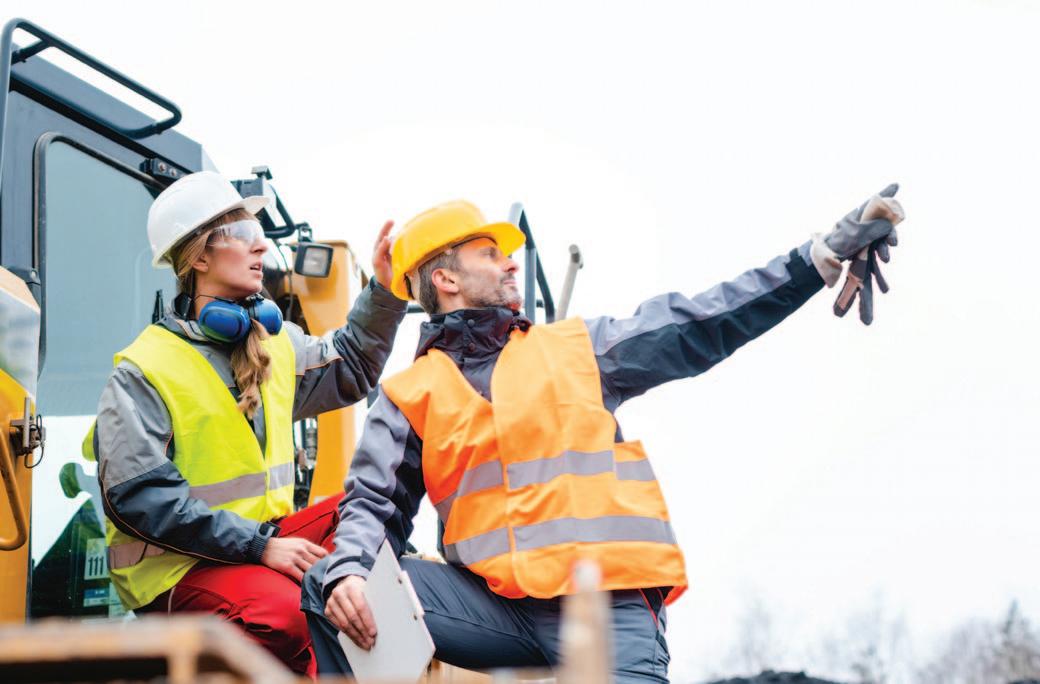
“Workforces that are balanced and are inclusive are far more productive. The wellbeing of the individuals that work in those teams is much stronger and their connectivity to the organization, the outcomes they produce as a group, are stronger too.”
– Simon Thomas, president of potash at BHP
Eldorado Gold Corp. has also taken steps towards increasing the representation of women in its workforce. In 2018, the company joined the 30% Club Canada, an initiative that aims to achieve better gender balance at both the board and senior management levels. In its 2022 sustainability report, Eldorado Gold stated its board was composed of 56 per cent female directors, and that it set a goal for women to hold 30 per cent of senior management positions by 2023.
Shauna Goldenberg, director of inclusion and engagement at Eldorado Gold, told CIM Magazine that diversity is a strength for driving better quality business decisions. She noted the company undertakes a survey annually to better understand its employees and consequentially, better understand where to focus EDI practices.
She also pointed to a partnership between Eldorado and the School of Indigenous Studies at the University of Québec in Abitibi-Témiscamingue that aims to increase Indigenous participation in the mining industry. Through the expertise of teaching staff, the partners developed a project to retain members of the Anishinaabe community in the industry’s workforce.
Eldorado is currently using the new EDI protocol to assess where the company has gaps in its EDI performance, Goldenberg said.
“The TSM protocols have done a really great job outlining what organizations should be doing,” Goldenberg said. “Support from senior leaders combined with TSM protocols, like EDI, is the catalyst to see the change that we need and stimulate the mining industry for continued success.” CIM
Quebec University researches recovering minerals from asbestos tailings
The Quebec government has allocated $3 million over five years towards the creation of a new research chair at the Université de Sherbrooke that will focus on the recovery of critical minerals from asbestos mine tailings.
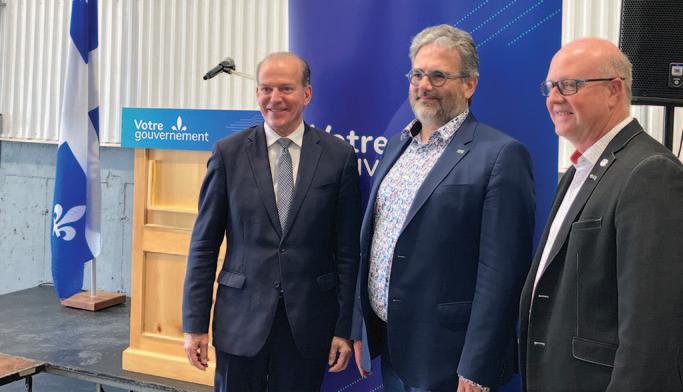

The funding from the provincial government will serve to establish and support the new research chair, which has
been operating since the start of June. The research chair aims to increase knowledge on the concentration of critical minerals in the tailings and to develop processing methods to extract them.
Asbestos mine waste is rich in magnesium and also contains nickel. Both critical minerals are crucial in the energy transition due to their use in solar panels and electric vehicle batteries.
Gervais Soucy, director of the department of chemical engineering and biotechnology engineering at the Université de Sherbrooke, and one of two chairholders of the research chair, told CIM Magazine the new funding will
#ICYMI
In case you missed it (ICYMI), here’s some notable news since the last issue of CIM Magazine, which is just a sample of the news you’ll find in our weekly recap emailed to our newsletter subscribers.
Teck’s Trail Operations (pictured) received $10 million in funding from the B.C. government’s CleanBC Industry Fund in July to support the progress of its Carbon Capture Utilization and Storage (CCUS) pilot project. Construction of the pilot plant is under way and once operational, which is expected to be later this year, it is expected to capture one tonne of CO2 per day from Teck’s Trail Operations.
India’s Chandrayaan-3 spacecraft landed on the moon’s south pole region on Aug. 23, which could be home to water ice deposits. According to Reuters, water ice could be key to a moon colony, lunar mining and potential missions to Mars. If water ice exists in sufficient quantities, it could be converted into fuel or drinking water to support missions to Mars and lunar mining.
The Mining Association of Canada (MAC)’s Towards Sustainable Mining standard has launched a new subscription service. MAC stated the service will help mining companies publicly report on sustainability data. Ioneer, an emerging lithium-boron producer, is the protocol’s first subscriber. Ioneer’s next ESG report will publicly report on its performance on the standards’ eight protocols.
An Aug. 8 report by the Conference Board of Canada said the rising demand for nickel will fuel investment in Sudbury, as reported by the CBC. The report stated that nickel demand is being driven by the war in Ukraine, along with an increased interest
in nickel exploration from the electric vehicle battery sector, which could help Sudbury’s local economy return it to prepandemic prosperity by 2026.
Canadian mining groups are asking for a one-year extension on the country’s planned January launch date of the Modern Slavery Act because of a lack of reporting and procedural guidelines in the law, as reported by Reuters Ben Chalmers, vice-president of the Mining Association of Canada, said that the organization is not disputing the law’s aim to fight forced and child labour in supply chains. Companies would first report under the law on or before May 31, 2024.
Sweden’s Climate Minister Romina Pourmokhtari has announced plans to lift the country’s ban on uranium mining to allow for greater nuclear energy capacity, as reported by Mining Technology According to the minister, the Swedish Parliament has shown majority support to lift the ban, and the government plans to build at least 10 large reactors in the next 20 years to meet the demand for lowcarbon energy. Several companies, including Canada’s District Metals, have already expressed interest in developing uranium sites in Sweden.
A consortium of Ford Motor Company and South Korean partners EcoProBM and SK On Co, Ltd. have chosen Bécancour, Quebec, as the location for a new $1.2 billion electric-vehicle battery materials plant, as reported by Reuters The facility is expected to produce 45,000 tonnes of cathode active materials per year for Ford electric vehicles. The facility is expected to be operational in the first half of 2026.
Sign up for our newsletter

Stay up to date on the latest mining developments with our weekly news recap, where we catch you up on the most relevant and topical mining news from CIM Magazine and elsewhere that you may have missed.
help the researchers undertake a variety of projects.
“Through this chair, we will train highly skilled people—masters and doctorate students and technicians—to support the [mining] industry,” Soucy said. “We are also aiming to create an overview of the science and research that has been made over the last 50 years on the topic of mineral recovery. Then, we want to make this [scientific literature review] available to the public.”
With the review, Soucy said the goal is to determine which technologies are most efficient and promising in the recovery of minerals from asbestos tailings.
“We want to avoid reinventing the wheel and instead use what has already been researched to build upon it,” he said. “For example, some mineral recovery technologies made a decade
Developments
ago were powered by combustible fuels; we want to see if we can use them with a more sustainable source of energy.”
The announcement was made in Valdes-Sources (formerly Asbestos and renamed in a 2020 referendum), where a large number of asbestos mines operated but are no longer active. However, around 800 million tonnes of asbestos mining waste are still present on these sites, according to the government. Valdes-Sources is situated 56 kilometres north of Sherbrooke, making the university a strategic location for research.
To avoid transporting the asbestos mine tailings, some of the larger research projects will take place directly at Valdes-Sources, while smaller-scale projects will take place at the university.
– Alice MartinLessons from the San José mine rescue
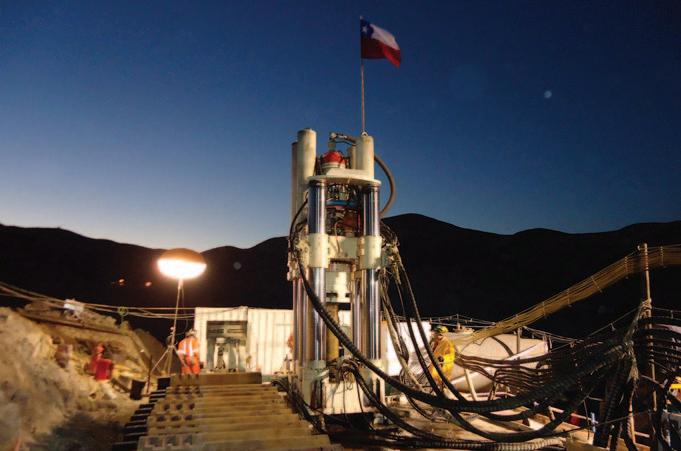
When the San José copper-gold mine in Chile collapsed on Aug. 5, 2010, it was a man-made and avoidable disaster, according to Cementation Americas director Roy Slack. He made these comments as part of his opening keynote at Hoist and Haul 2023, an international conference on hoisting and haulage that took place in Montreal on Aug. 14.
The rockfall at the San José mine blocked the ventilation shaft, which was its sole exit point. The mine was left
unstable, and 33 miners were trapped 700 metres underneath the surface for 69 days.
Slack told the audience that the San José mine rescue mission has valuable lessons to teach the mining industry, even more than a decade later.
“It was a great rescue success,” Slack said. “But we can’t forget it was a great mining failure.”
Slack added that the mine was notoriously dangerous. He noted that from 1998 to 2010, eight fatalities occurred at the mine. The mine operator had also been ordered to build a second means of egress
Number of operations simultaneously working to rescue the miners
33
Number of miners trapped underground
69
Number of days the miners spent trapped underground
in 2003, but when the mine collapsed in 2010, it still had not been constructed.
State-owned Chilean copper mining company Codelco was brought in by the government to coordinate the rescue mission. The government solicited rescue plans from around the world. Out of
more than 21 proposals submitted, the Cementation Group and its Chilean partner Terraservice were selected to carry out what became known as Plan A.
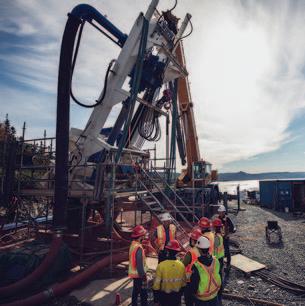
“One thing [the Chilean government] did was move quickly, as soon as the miners were found alive, to show that there was a plan in place,” Slack said. “I think that’s one of the reasons why we were picked—we could mobilize quickly and start Plan A while they began to look for other plans.”
Plan A involved drilling a first hole, then doing a second pass to widen it to a 28-inch hole, all with a Strata 950 raise drill. Soon thereafter, Plans B and C were also put into place. For Plan B, like Plan A, Chilean-American drilling company Geotec SA drilled two holes using a Schramm T130XD exploration drill.
Made-in-Canada technology gets a boost from MICA funding
Compiled by Silvia PikalThe Mining Innovation Commercialization Accelerator (MICA) Network, an initiative funded by the Government of Canada’s Strategic Innovation Fund to bridge gaps between innovation and commercialization in mining, announced in late June it will allocate more than $15 million in funding to 24 Canadian companies. The funding aims to accelerate the commercialization of mining technologies focused on increasing mine production capacity at a lower cost, reducing energy consumption and greenhouse gas (GHG) emissions, implementing autonomous systems and reducing environmental risk and long-term liabilities. CIM Magazine contacted five of the recipients to find out what they are planning to do with the funding.
$1.1 million
Prairie Clean Energy produces biomass fuel by utilizing flax straw, a byproduct of flax grown in Saskatchewan that is considered waste and usually burned, and processing it into pellets that can be used to heat potash mines in place of natural gas. The company said this biomass fuel has the potential to reduce the carbon intensity of heat energy consumed in potash production by up to 80 per cent. The MICA funding will support the annual production of 75,000 tonnes of flax straw pellets at a processing facility in Regina, in addition to the operation of a demonstration 250 kW modern biomass boiler at a training site in Moose Jaw in partnership with Saskatchewan Polytechnic.

Calgary-based Precision Drilling Corporation was responsible for Plan C, which consisted of a single hole drilled with a Rig 421 oil drill.
Plan B ended up rescuing the miners. On Oct. 13, 2010, the 33 miners were all successfully hoisted to the surface with the Phoenix 2, a rescue capsule.
Slack emphasized that the collaboration between the companies when one group’s plan was stuck was critical to the rescue’s success. When Plan B burned one of its drill bits and had difficulties fishing it out, Slack said the other groups were there to help. “There was interaction between all the groups working, there was collaboration and innovation,” he said. “Three plans made a difference.”
However, Slack said that while the urgency of the situation drove a successful
$850,005
Novamera Inc. creates surgical mining technologies that integrate into standard drilling equipment to pinpoint, map and extract ore from narrow vein deposits, which the company said is difficult to extract economically with conventional mining methods, and would typically be left unmined due to the deposits’ complex size and geometry. The company’s guidance tool gathers subsurface data and defines ore body geometry, which is then utilized to calculate optimal drill trajectory that maximizes ore extraction. The MICA funding will aid in the demonstration of its technology at a mine site in Newfoundland.
rescue mission, the accident could have been avoided, had the owner of the San José mine been mindful about safety.
“They didn’t spend money to make the mine a place where people wanted to work at, instead of a place where people had to work,” he said. “There were some things they could have done to make this mine safe and instead, they paid danger pay.”
Slack concluded by noting that the mining industry is facing big challenges to which it could apply the same sense of urgency that fuelled the innovation and collaboration at the San José mine rescue in 2010.
“I feel the largest challenge in our industry is tailings, and we’re still struggling with massive failures that [have] killed people,” he said. “I don’t have the answer, I just wish there was that sense
$579,696
Developments
Alice Martinof urgency we had at San José to solve that challenge.” –
Mining companies urged to boost cyber resilience
As the extractive sector becomes increasingly automated, companies have to be aware of cybersecurity threats and how they can negatively impact safety, reputation, operations and finances.
Rob Labbé was appointed chief information security officer (CISO)-in-residence on July 4 for the Mining and Metals Information Sharing and Analysis Centre (MM-ISAC), a non-profit, industryowned corporation established with the
RockMass Technologies Inc. builds data collection technology that allows geologists and geotechnical engineers to perform face mapping and assess tunnel stability. The MICA funding will help develop a product that uses LiDAR and computer vision to collect 3D georeferenced data, eliminating the need for data transcription and digitization, which the company said will save time and keep workers a safe distance away from hazardous ground conditions. Its software can identify and calculate geological features, enabling underground operations to rapidly make decisions using data collected from face mapping, structural mapping, ground support ID/audits, shotcrete thickness and more.
$500,000
aim of improving the cybersecurity of metals and mining companies. The organization currently has 20 members, six of which are based in Canada.
Labbé told CIM Magazine that the MM-ISAC tracked 11 cybersecurity incidents in July 2023 from a combined sample of the organization’s members and publicly reported incidents globally. This year, MM-ISAC noted an average of two to three cybersecurity incidents in the extractive sector each month. Last year, the number was around one to two cybersecurity incidents each month, which means the number of incidents since last year has doubled. Labbé said it is too early to tell if the July figures are the start of a new trend.
He said that the most common cybersecurity threat for companies in the

$292,333 Telescope Innovations, which is headquartered in Vancouver, is developing a carbonnegative technology to produce lithium carbonate from brines. The company stated it aims to address the lack of processing capacity in Canada, which it said is a net importer of lithium chemicals despite the country’s large lithium reserves. The funding will support the various technology phases, including brine sourcing and surveys, bench-scale proof-of-concept for its carbonation and crystallization process and bench-scale lithium carbonate production from a variety of brine compositions based on North American brines, including a scale-up of select processes.
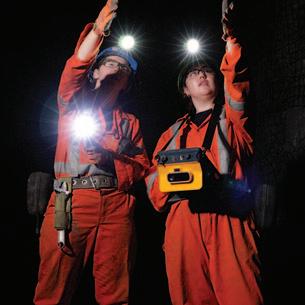
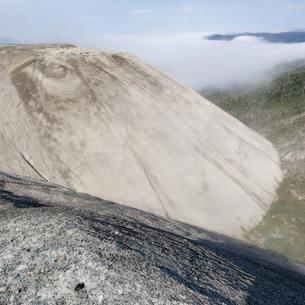
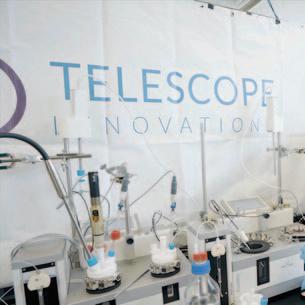
Using abandoned chrysotile asbestos tailings in Baie Verte, Newfoundland, Baie Minerals Inc. has developed technology that extracts commercial grades of industrial and critical minerals, and destroys and eliminates chrysotile fibres from tailings, using a netzero carbon process. The company said its technology sequesters CO2 through the process of carbon mineralization. The MICA funding will be applied to the construction of a scalable CO2 capture and sequestration pilot plant.
View the full list of recipients online.
extractive sector is ransomware, which is a type of malware designed to lock a company out of its files or systems until a ransom is paid.
“A company that doesn’t rely on technology to perform their daily operations is not an attractive target to [hackers], because they don’t have the leverage to extort you for money,” Labbé explained.
Critical Elements Lithium Corporation appointed Nancy Duquet-Harvey as senior director of sustainable development and environment. Duquet-Harvey has more than 25 years of experience in environmental studies, environmental monitoring and permitting, as well as collaboration with local Indigenous groups.
NorZinc Ltd. named Jim Dainard as CFO and Robin Bienenstock as chair of its board of directors. Dainard is a chartered professional accountant with more than 22 years of experience, and most recently held the role of vice-president, finance at Victoria Gold Corp. Bienenstock is an investor and the Canadian representative of Resource Capital Funds, a mining-focused alternative investment firm.
Frontier Lithium Inc. appointed Erick Underwood as CFO. Underwood has more than 25 years of experience in the finance and project development sectors within the mining industry and held key positions at companies such as Chesapeake Gold Corp., Cia. Minera Zafranal (Teck Resources Ltd.), AQM Copper Inc. and BHP Billiton.
Premium Nickel Resources Ltd. appointed Peter Rawlins as senior vicepresident and CFO and Sean Whiteford as president of Premium Nickel Resources International Ltd., an indirect wholly owned subsidiary of the company. It also appointed CEO Keith Morrison as chair of the board and Mark Christensen to the board of directors.
“As we get more technology-driven and more complex, now we become a more attractive industry to those people.”
Labbé said that the extractive sector is seen as a lucrative target for hackers, but the threat may not be on the radar for most companies.
“Cyber risk hasn’t made it to a lot of the boards and executives in a significant way, so they’re unprepared to manage it as a company-wide event when an incident happens,” Labbé said. “Cybersecurity threats are very much seen as a technology problem in the industry, where really it needs to be looked at as a business risk.”
He added that while companies of all sizes face the risk of cybersecurity incidents, smaller companies are more at risk because of fewer resources.
In 2021, according to a Statistics Canada survey, 27.5 per cent of Canadian mining, quarrying and oil and gas extraction businesses were impacted by cybersecurity incidents, and 12.5 per cent of businesses in this sector were impacted by incidents to steal money or demand ransom payment.
Labbé pointed to a recent example of a significant cybersecurity incident in the mining industry: Copper Mountain Mining Corporation’s ransomware attack, which occurred on Dec. 27 of last year. The company preventively shut down its mill near Princeton, B.C., until Jan. 1 to address the attack and gradually returned to full production on Jan. 4, according to a Jan. 6 press release.
In a July 19 article, The Globe and Mail reported that Canadian miner Barrick Gold Corp. was one of at least 376 organizations impacted by a global data theft incident. Barrick Gold has yet to publicly confirm the attack took place.
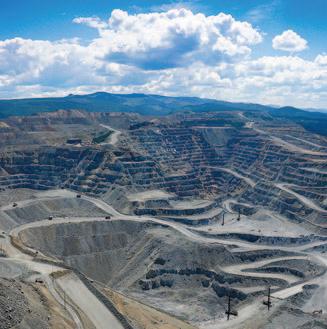
The Canadian Centre for Cyber Security (CCCS) counted about 305 reports of ransomware attacks last year, up from the 295 reported the year before. Sami Khoury, the head of the CCCS, told The Canadian Press in an article published on July 19 that the number could be 10 times higher as many organizations are too embarrassed to report that they have been impacted by cybercrimes.
Labbé said that it is often cybercrime groups that publicly announce the attack, instead of the company itself.
“When you communicate poorly, it becomes a massive distraction,” he said. “You’ve got employees, shareholders, investors and media asking you what’s
going on, which raises the pressure in the room. Good communication turns down the external volume so you can focus on the actual problems.”
Labbé said that to prevent a cybersecurity incident in the first place, all companies should plan for cybersecurity incidents and have action protocols in place for them. He compared the importance of planning to a fire drill. “Instead of hoping it doesn’t happen, companies need to realize this is something that has a high possibility of happening. Hope is not a security control,” he said.
As the new CISO-in-residence at MMISAC, Labbé’s role is to provide education and guidance to the industry. He also provides one-on-one counselling to MMISAC members on how to increase their cyber resilience. –
305
Alice MartinNumber of ransomware attacks in 2022 reported by the Canadian Centre for Cyber Security 11
Number of cybersecurity incidents tracked in the mining and metals industry in July 2023
27.5
Percentage of Canadian mining, quarrying and oil and gas extraction businesses impacted by cybersecurity incidents in 2021
“Cybersecurity threats are very much seen as a technology problem in the industry, where really it needs to be looked at as a business risk.”
Rob Labbé, CISO-in-residence for the MM-ISAC
Mining made fun
If you have ever browsed the app store for a mining game, you get a small window into how the public sees the industry: the images are usually of a man with a pickaxe or shovel digging and filling up a minecart with gold, which he rides all the way to the bank. That is not how it works and it is also an outdated picture of an industry that is rapidly changing in many aspects, from its technology to the people who make up its workforce.
A new strategy game called Mine Evolution has been designed to provide a more modern viewpoint of one of the world’s oldest industries.
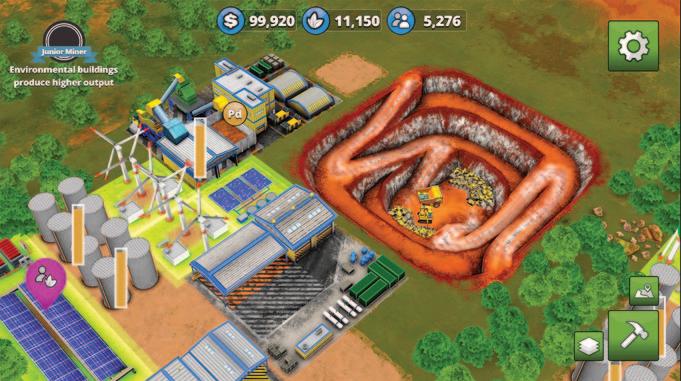
Mine Evolution is a collaboration between The Canadian Institute of Mining, Metallurgy and Petroleum, a number of its branches and societies and Science North, a science centre in Sudbury, Ontario, which hosts Dynamic Earth, an attraction with earth science and mining experiences. The game was developed by D&D Skunkworks.
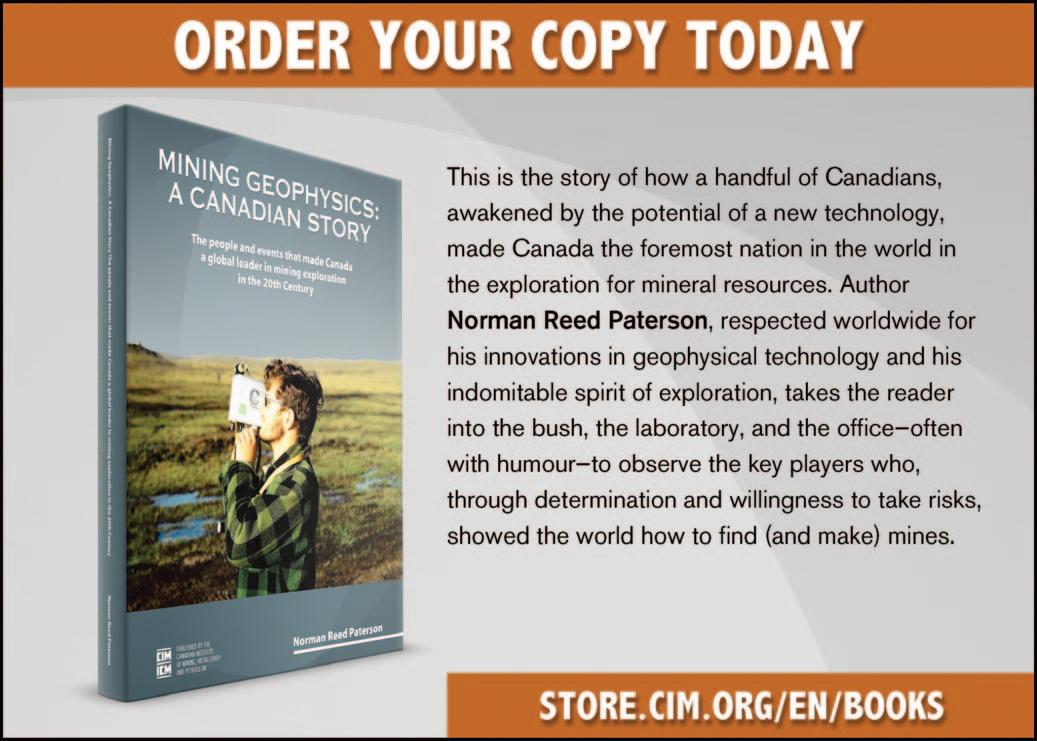
Jennifer Beaudry, senior scientist at Dynamic Earth, told CIM Magazine that Science North had always wanted to develop a game and saw its chance after the pandemic hit and children were switching to online education.
“This was the opportunity for us to shed a different light on what modern
mining is about and where the future is heading,” she said.
As described on its website, the mission in the game is to “explore the ground beneath your feet and search for precious minerals that are critical to evolving your mine—from your building materials to Wi-Fi technologies.”
Users are involved in all aspects of mine development, some of which include picking a plot of land, extracting ore by blasting rocks, harnessing solar power and eventually closing the mine. Users run multiple mines across Canada to extract a short list of critical minerals including lithium, nickel and copper and earn financial, social and environmental credits to grow their operations.
Jacqueline Allison, chair of Canstar Resources Inc. and an executive on CIM’s Management and Economics Society, was one of the industry leaders who provided expertise into how to portray certain aspects of the mining industry. She told CIM Magazine that incorporating financial, social and environmental credits into the game is a way to demonstrate how many factors contribute to the success of a mining project.
“In addition to being technically sound, a mining project is expected to provide a financial return, which adequately compensates the operator for the risks being taken,” Allison said. “It is also important for the operator of a mining project to earn and maintain the social licence to operate while minimizing the environmental impact.”
The game intends to inspire younger generations to consider a career in the mining industry, by raising awareness of its innovation, technology and sustainability practices, and highlighting the importance of critical minerals to clean energy technologies.
“This is about introducing people to what mining is,” Beaudry said. “And first and foremost, it’s about having fun—we want people to have fun and play this game. But as you start digging into it, it’s about realizing that mining is high tech. Mining is socially and environmentally conscious. We need to be sustainable in order to continue mining and you see those aspects built throughout the entirety of the game.”
To showcase the people behind the industry, there are moments in the game that introduce actual workers, like Zara, a mining engineer nicknamed the “Rock Doctor” by her team.
Beaudry said the game takes care to showcase the leaps the mining industry has taken when it comes to everything from safety to environmental, social and governance (ESG) standards. For example, the game requires you to build a refuge station in your mine.
In addition to the game’s educational focus, Science North will release six les-
son plans in November geared for grades four to 12 across the country so that teachers have the option of incorporating the game into their curriculum.
At the time of print, Mine Evolution was in its beta stage and available for
Utility corridor could export potash from Prairies to Brazil
Fox Lake Cree Nation and FirstNation company NeeStaNan Projects Inc. announced in July they are partnering to spearhead the development of a utility corridor through the Prairie provinces to export natural resources like potash, natural gas, wheat, bitumen and other critical minerals landlocked in western Canada.
The proposed corridor would rely upon existing railway infrastructure and start in Fort McMurray, Alberta, and end in Port Nelson, on the Hudson Bay coast of Manitoba, where Fox Lake Cree Nation would construct and own a deep-sea port. A set route for the corridor has yet to be determined.
A memorandum of understanding has been signed between Fox Lake Cree Nation and NeeStaNan for the latter to conduct an environmental assessment and social impact study. The process is currently under way, according to Wil Jimmy, Fox Lake Cree Nation economic development officer, and is expected to take between eight and 12 months to complete.

download in English and French for PCs, Android and Apple devices, with an official launch date for the general public at Science North in Sudbury planned for November. It is downloadable and playable offline. – Silvia Pikal
The government of Manitoba announced on August 3 it would provide $6.7 million over the next two years to advance the utility corridor’s feasibility study, which the province said is contingent on funding participation from the governments of Alberta and Saskatchewan, as well as First Nations communities. The feasibility study is expected to cost $26.6 million.
The utility corridor would be 100 per cent Indigenous-owned and governed by a board of directors. According to NeeStaNan’s website, the corridor would be useful in exporting potash from the Prairie provinces to Brazil, a major consumer of the fertilizer. Canada, the biggest exporter of potash in the world, exported 22.5 million tonnes of potash—or 31 per cent of the world’s total exports—in 2021, according to the federal government.
Exporting Saskatchewan potash to Brazilian markets from Port Nelson would shave off 630 kilometres in railway transport compared to the existing routes to Vancouver ports, according to NeeStaNan’s website.
“It’s a lot closer to transport potash from the province of Saskatchewan to Port Nelson and it’s relatively level land as opposed to going out west through the
Rocky Mountains, and that’s a big benefit,” Jimmy said. “[Companies] get their product to market a lot quicker.”
Port Nelson is also 3,800 kilometres closer to Brazilian markets by ship compared to the current main export route that goes from the Vancouver ports to Brazil through the Panama Canal.
The entire development of the utility corridor would cost between $35 billion and $50 billion, Jimmy said. He added the project would be done in phases, pending the outcome of the environmental assessment and social impact studies.
“Phase one in Manitoba is to build a port on the Nelson River, then build a new railway of 120 kilometres to Port Nelson from Amery, Manitoba, and to upgrade the existing rail that’s owned by the First Nations in northern Manitoba,”




Jimmy said. “That itself is going to run to the tune of about a billion dollars.”
The agreement by the two Indigenous entities, as well as the Manitoba government’s funding announcement, comes after the governments of Alberta, Saskatchewan and Manitoba signed an MOU to explore inter-provincial economic corridors in April. The agreement between the Prairie provinces includes “advancing economic corridors in a manner consistent with the spirit and principles of Indigenous reconciliation, and that advance Indigenous economic opportunity.”
“This project will create incredible opportunities for Manitoba’s Indigenous communities to participate in clean energy and economic corridors that create financial benefit for remote and Indigenous communities,” said Manitoba
Premier Heather Stefanson in the August 3 press release referencing the funding announcement.
“I think [reconciliation] is something that we all, as First Nations people and Canadians, want to work towards,” Jimmy said. “[The NeeStaNan utility corridor] would be a very good example by the Government of Canada, and also the Prairie provinces, that they are working towards reconciliation.”
Jimmy also noted the benefits that the NeeStaNan utility corridor would bring to Fox Lake Cree Nation.
“We [would] become equal players and participants in a local, national and global economy,” said Jimmy. “Actually, over time, it should create economic independence for Fox Lake Cree Nation, and great wealth for the nation.” – Alice Martin
Intelligence Report provides year-to-date data on listings, financings and trading activity across the Toronto Stock Exchange (TSX) and TSX Venture Exchange, broken down by sector and region. The June 2023 edition examines the first half of the year. CIM Magazine has pulled out key data related to mining.
The Market
New market listings: Miners play a smaller role
Mining companies and market capitalization: Rising value
The number of mining companies newly listed on the TSX and TSX Venture Exchange has dropped by 21 per cent from H1 2022 to H1 2023.
In H1 2023, mining companies had a market capitalization of $527 billion, compared to $495 billion from the same period last year, representing an increase of 6.5 per cent.
21 % 6.5 % Equity capital raised by mining: A bigger slice of the smaller pie
In H1 2022, equity capital raised by the mining sector was $4 billion out of a total of $15.6 billion raised by various industries, including clean technology, real estate, oil and gas and more. In H1 2023, it was $4.2 billion out of $7.9 billion.
Back to Normal
By Manochehr OliazadehHigh-price cycles are a common occurrence in the mining industry, but the most recent one in 2014 was notably prolonged and had a considerable impact on engineering design processes. The 2014 super cycle brought about significant changes in engineering expectations and the quality of feasibility studies. In response to the high prices of metals and favourable market conditions at the time, mining companies rushed to complete engineering designs and cost estimates to build their mines.
To invest in a mining project, it is necessary to conduct prefeasibility and feasibility studies to determine the capital cost and establish a financial model with a certain level of precision. These studies have requirements such as accuracy of capital and operating cost estimates that must be met. For instance, the feasibility study should have an accuracy of 10 to 15 per cent (Class 4 as defined by Association for the Advancement of Cost Engineering) which can be attained with a certain amount of engineering efforts. If a project relies on lightweight feasibility studies, which involve less engineering and result in inaccurate cost estimates, it can lead to cost overruns and ultimately project failure due to inadequate investment.
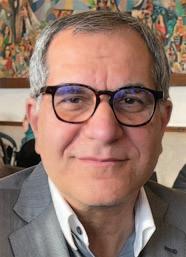
While a high price for metal may make a project appear economically feasible, it is impor tant to conduct, for example, proper metallurgical testwork to confirm the expected metal recovery and other design parameters. This information is critical to the success of the project and ensures that it will deliver the expected returns. During the super-cycle period in 2014, some companies were willing to forgo testwork or engineering efforts to speed up the project’s schedule. This approach might have saved time in the short term, but in the long term, it led to costly mistakes and project delays. This “cost-cutting” approach resulted in a dearth of data for determining the capital cost and financial outcomes, which resulted in optimistic or light feasibility studies that underestimated the capital expenditure to build the project. As a result, the projects experienced cost and schedule overruns and were unable to be completed within the budget and timeline outlined in the feasibility study.
According to a 2015 Deloitte report, during the super-cycle period, mining projects in South America had the highest overrun rate at 64 per cent, while South Africa had the lowest at 30 per cent. North America and Australia experienced overruns of 51 per cent and 40 per cent, respectively. These findings have led to a loss of credibility in mining projects, causing a confidence crisis.
The shortage of projects in the market, due to low metal prices after the super cycle, created a highly competitive market that exacerbated the situation, leading to lower-quality prefeasibility and feasibility studies as companies attempted to
reduce engineering costs to win the available limited projects in the market. These conditions led to reports of an even lower quality and has become the “new normal.”
While a high price for metal may make a project appear economically feasible, it is important to conduct, for example, proper metallurgical testwork to confirm the expected metal recovery and other design parameters. This information is critical to the success of the project and ensures that it will deliver the expected returns.
While the requirements for NI 43-101 reports are maintained regarding confirming geological resources and reserves, it is important to note that the same level of quality may not be reflected when it comes to mining and processing, since the same lightweight prefeasibility and feasibility studies are still performed. The 43-101 reports are a summary of these studies, thus the quality of them are reflected in the 43-101 outcomes.
The recent super cycle has significantly impacted the quality of mining studies, and it appears that we have not yet returned to the necessary quality standards (“normal”) used in the past. You can easily compare a feasibility study report issued presuper cycle with more recent ones to observe the differences in quality and content.
As a result, if you intend to undertake and progress a project (from prefeasibility to feasibility study or from feasibility study to detailed engineering), a significant amount of engineering work will need to be completed. For instance, a crucial aspect such as piping and instrumentation diagrams must be welldeveloped for a feasibility study. Unfortunately, some feasibility studies still only indicate marked up process flow diagrams, requiring you to start from the beginning.
To restore confidence in mining projects, it is essential to return to normal and produce engineering works that meet the well-established quality and accuracy standards for feasibility studies. Low-quality feasibility study reports can result in more work during construction and can leave investors in a difficult financial situation, ultimately leading to a loss of confidence again in mining projects. CIM
Send comments to editor@cim.org
CIM Celebration of Excellence



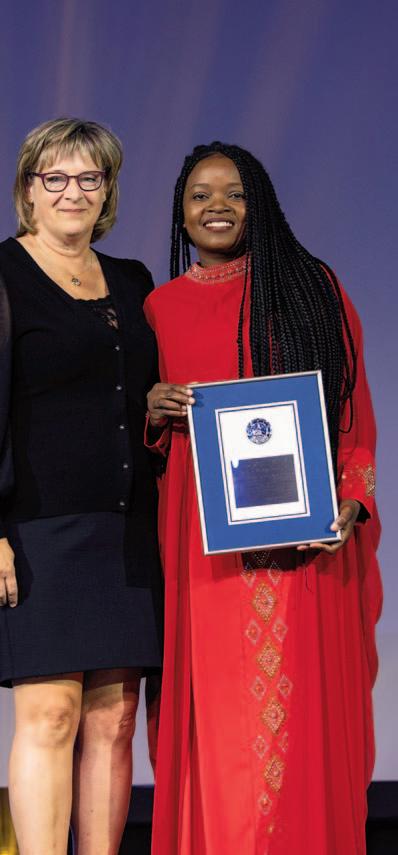
modern miner
Quietly defiant
In a traditionally maledominated industry, Mary-Jane Piggott creates opportunities for women to succeed
By Alice Martin Mary-Jane PiggottP.Eng, P.E., MBA
Vice-president, mining environmental group
Klohn Crippen Berger
B. Eng.
Civil Engineering, University of Newcastle, Australia
P. Eng.
British Columbia and Northwest Territories
P. E.
Alaska
Master of Business Administration (MBA) Simon Fraser University
Mary-Jane Piggott, vice-president of Klohn Crippen Berger (KCB)’s mining environmental group, said her traits of resiliency and stubbornness have helped her to develop a career in a male-dominated industry. Now, she uses her position and her experience to help other women succeed in the mining industry.
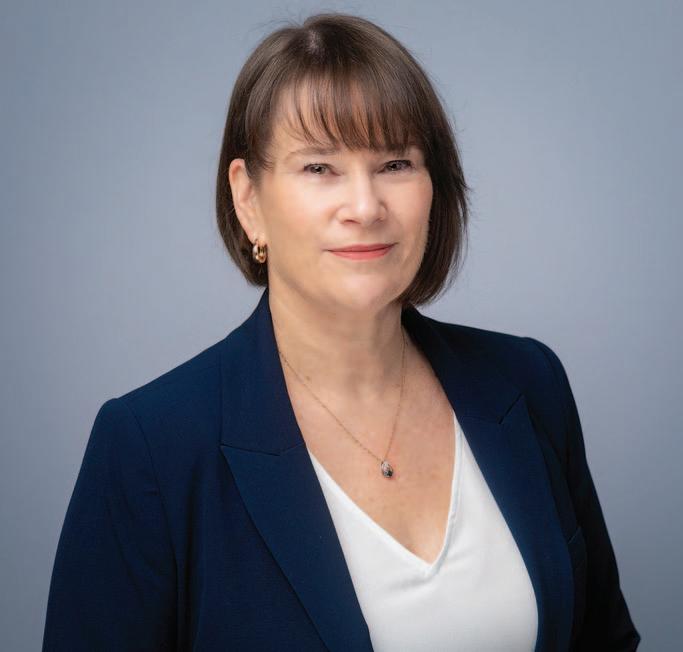
Piggott is the first woman to take on a vice-president role in KCB’s history, something that she does not like to point out. Piggott, who is a self-described “extreme introvert,” prefers not to have the spotlight shine on her.
“I don’t like being [referred to as] the first [female vice-president] because what does it matter whether I’m female or not?” she said. However, Piggott understands that her accomplishment matters. In an industry where women are underrepresented at every level—“the drop-off from entry level to executive for females in mining is among the most dramatic across all industries we studied,” according to a McKinsey & Company article published in 2021—the lone woman at the top stands out, and provides valuable representation for other women.
Being the voice of the team is what Piggott likes most about her leadership role in the company. “[I love] being able to hear what changes the group wants, whether that’s from a technical perspective, a recruiting perspective or from an ESG [environmental, social and governance] perspective, and seeing how we can fit that into what we’re doing as a business,” she explained.
What is the biggest challenge the industry is facing this year?
Recruiting good quality people with the skills [required] and a curious mindset. Someone who’s not just going to turn up and do a job, but someone who has a passion for what they do.
Piggott graduated from the University of Newcastle in Australia with a bachelor of civil engineering in 1998. One of the first jobs she took in the mining industry was in 2006 with Australian engineering company GHD, where she worked on project sizing for a sediment pond for Centennial Coal. Following that experience, Piggott moved to Canada and started working for KCB in its mining environmental group in 2011.
All along the way, she stood out. As with mining, she was one of the few women in the MBA program she completed at Simon Fraser University in 2019. While she has become used to the gender imbalance, she also sees how it can represent a real risk to an organization.
“If you’ve got a different opinion [as a woman in a room full of men], sometimes you question yourself and run the risk of discounting your own opinion or idea,” she explained. “Whereas, when you’re in that more balanced room, everyone’s got different opinions and whether you’re male or female, it makes no difference whatsoever. You’re more inclined to speak up.”
Piggott said achieving gender balance within an organization requires attracting more women into the workforce, and that one way to accomplish this is by providing
information about opportunities in the mining industry to young girls in middle school and high school.
“By 12 [years old], it’s already starting to kick in that gender roles are assigned. Up until then, boys and girls couldn’t care less,” Piggott said. “You’ve got to get in early so that you keep their minds open to what future opportunities there might be.”
She recalled a presentation she made to a Girl Guides group in British Columbia as a volunteer for Engineers and Geoscientists B.C. The experience served as a catalyst for her to realize that gender socialization in children can limit their future career choices.
“One of the questions I asked them was, ‘Do you know what an engineer is?’ and the first thing they said was, ‘You drive a train?’ No.” Piggott laughed. “So, I described it a bit more and then one of the girls—she must have been 10 and this was only in 2015, so it’s not that long ago—said, ‘Oh, I didn’t know girls could be engineers.’”
When Piggott was 10 years old, she too had been exposed to those same gender norms. As a young girl who loved Lego, she told her father that she wanted to become a builder just like him, but to her father, that was an impossible dream. Looking back on her early life, she suspected he wanted to shield her from construction sites, which can be notoriously sexist environments. However, Piggott pursued her career against these odds, which she attributed to her stubbornness.
At KCB, Piggott works every day to build a better world where women feel comfortable pursuing a career they are passionate about. She mentors women and champions policies that help
retain them in the workforce, such as offering the option for employees to return to part-time work following parental leave instead of full-time work, which she has been actively promoting since taking her first Canadian management role at KCB in 2015.
“We’ve had that in place for about eight years now, and we’ve got between 10 and 15 staff members just within the mining environmental group that have taken that leave,” she said.
Piggott frequently calls upon her experience to help others in her field develop their careers. She recalled having regular chats about maternity leave with a geotechnical engineer on her team who had a baby and was wondering whether it would affect her career progression.
Piggott encouraged this employee to pass on her experience to newer employees, emphasizing that everyone has a duty to mentor: “Why reinvent the wheel? If someone has a challenge, you can share a different but similar experience from which they can pull portions of those stories to create a solution that works for them individually. No one succeeds on their own. If you can help those around you make the best of themselves, that helps you in the end as well.”
Mining is a varied, multi-faceted industry and the people who work in the sector are equally diverse. Modern Miner will run through 2023 and showcase mining professionals from a range of backgrounds and highlight the ways they are leading, innovating and pushing the industry forward. If you know somebody who should be profiled, email editor@cim.org
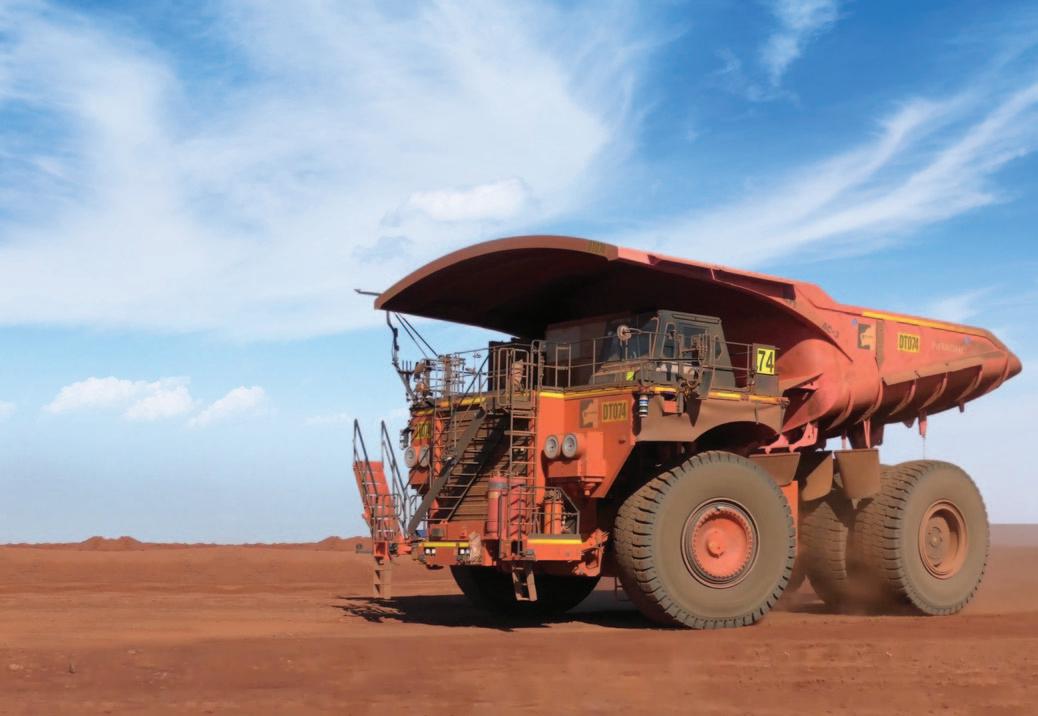
Trial by bacteria
Ammonia removal pilot projects seek to take on the challenges of biological wastewater treatment at mine sites
By Sarah St-PierreIn recent years, Canada’s metal and diamond mining effluent regulations (MDMER) have become more stringent when it comes to the levels of ammonia deemed permissible in treated wastewater effluent that is released from mine sites. Ammonia is an inorganic compound of nitrogen and hydrogen, most often derived from waste, fertilizer or natural processes such as the decomposition of organic matter. The umbrella term “total ammonia nitrogen” includes both ammonia (NH3), which is un-ionized, and ammonium (NH4+), which is ionized. Ammonia is the form most threatening to aquatic life when present at a high enough concentration. The MDMER, by regulating its levels, ensure that mining activity does not impose a toxic toll on local ecosystems.
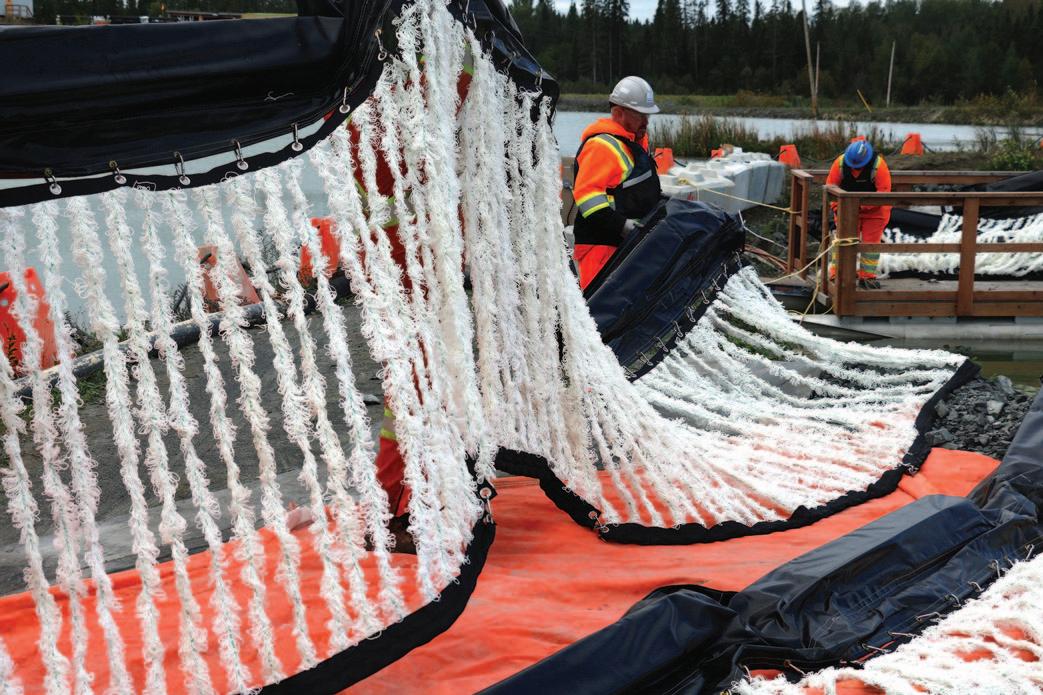
To meet these restrictions, biological ammonia removal processes can be used throughout the mining industry. Biological treatment—which is less complex, less energy-intensive and more cost-effective than other approaches—introduces microorganisms that convert ammonia in wastewater into the less-harmful nitrate. With the potential for yet more stringent regulations to come, recent pilot projects conducted by Manitoba-based wastewater technology company Nexom, and Ontario-based water treatment supplier Bishop Water, sought to test innovations to these processes in order to perform more
robust biological ammonia removal under the harsh conditions of mine sites.
The need for high-performing biological ammonia removal was amplified by the updated MDMER, which came into effect in June 2021, prescribing a limit of 0.5 milligrams of ammonia nitrogen per litre of effluent. However, additional clauses in federal regulations also prescribe that mining effluent must not be acutely lethal to daphnia magna, a small planktonic crustacean species, or to the rainbow trout. To avoid being acutely lethal to these species, however, ammonia levels need to be even lower than what is prescribed by the MDMER, typically somewhere within the range of 0.1 to 0.2 milligrams of ammonia per litre.
At a mine site, the presence of ammonia can be the result of many factors. For gold mines dealing with a cyanidation process, the conversion of cyanide into ammonia is a by-product of the extraction of gold itself. Ammonia can also become an issue due to blasting that uses ammonium nitrate fuel oil as the explosive, as ammonia is likely to make its way into underground water or site runoffs. For some mine sites, there may even already be a natural presence of ammonia in pit water.
Because not all sources of ammonia are made equal, the intensity of ammonia removal efforts required at each mine site to meet regulations varies widely. While some mines may only need
to remove half of the ammonia present in their wastewater to hit regulatory targets, others may need to remove as much as 99 per cent of it. For these sites, having a reliable process to get rid of ammonia at high rates is key to meeting these regulatory targets.
Weathering the cold
For many mines located in northern climates, having access to technologies robust enough for cold weather ammonia removal is a necessity.

Over the course of a five-month demonstration that took place at a northern Ontario gold mine in 2021, Bishop Water put its BioCord reactors to the test by treating wastewater from the mine’s mill and tailings. The mine site was already meeting regulatory requirements for ammonia removal, but with the potential for more stringent regulations looming in the future, it was interested in exploring other treatment technologies. The mine was also looking for a treatment technology that could maintain robust ammonia removal at near-freezing water temperatures. Biological activity begins to slow at about 15°C and continues to decline as the water temperature drops. At 1°C, an ordinary treatment pond achieves little to no ammonia removal.
The aims of the demonstration were twofold for Bishop Water. “One, it allows the client to see that this is an effective treatment process,” said Kevin Bossy, owner and CEO of Bishop Water. The company’s BioCord reactors are like a “condominium for bacteria” that boosts the nitrification process thanks in part to being fitted with woven polypropylene loops. The media provides a massive surface area for naturally occurring nitrifying bacteria to thrive and produce a biofilm. A built-in low-energy aeration system provides the necessary oxygen for the bacteria to convert the ammonia into nitrate, while also sloughing off dead bacteria to promote regeneration. It also prevents ice from forming around the BioCord reactors.
The other objective of the demonstration was to collect data that usually goes unrecorded in a wastewater treatment process. “Typically, you’re interested in your incoming [wastewater] and in what goes out,” said Bossy. “In between there, it’s really not relevant to what your reporting or treatment requirements are.” Yet for the mine sites looking to improve on nitrification processes, understanding exactly what’s happening, and when, while the bacteria are at work is of no small interest.
The demonstration unfolded in two main phases. The first, which took place from August to October 2021, saw water pumped from a pond that contained low-strength ammonia and then run through a set of tanks outfitted with BioCord reactors. Then, in early October, the provenance of the wastewater was switched to a pond with a much higher ammonia content. “There was also a significant reduction in temperature from the beginning of October until the completion of the project [in December],” said Bossy.
As the temperature dropped and the bacteria was tasked with converting a greater volume of ammonia into nitrate, Bishop Water’s system not only responded well to the new conditions, but also registered an increase in ammonia removal— the opposite of what usually occurs in ordinary treatment ponds that rely on free-floating bacteria.
“That’s really exciting for us, because we can see that the biofilm and BioCord does work in [the] cold, but will also help regulate and increase treatment in response to increased loading conditions,” said Tony Kobilnyk, sales and marketing executive at Bishop Water.
It was also considered a success for Bishop Water to be able to demonstrate the applicability of its technology in a mining application. The BioCord reactors are meant to be easy to implement with existing infrastructure without disturbing existing operations. The in-situ installation also helps reduce capital costs since no additional process equipment is needed, such as tanks, pumps, pipes and control equipment. “What we demonstrated was the ability to use [a mine’s] current infrastructure that is meeting all the regulatory requirements, [and] has the ability to be upgraded [with a BioCord reactor] to meet future regulatory requirements, pending on what those are,” said Bossy.
A novel process
When it comes to biological processes for ammonia removal from mining wastewater, most, if not all, employ nitrification microorganisms, which consume ammonia and turn it into nitrate—under the right conditions. Nitrifying microorganisms can be sensitive to their environmental conditions, including low temperatures, fluctuating pH levels and inhibitory compounds such as metals that are found in mining wastewater. To ensure robust wastewater treatment, moving bed biofilm reactors (MBBR) can foster and stimulate higher levels of bacterial activity in a wastewater treatment system by providing a surface area for the biofilm, in which the microorganisms thrive, to attach. Nitrification processes usually also involve adding phosphorus and caustic (typically sodium hydroxide, but soda ash or
Water Treatment & Process Solutions for the Mining Industry



Customized
Process, underground and environmental water solutions.
Expertise, performance and cost savings.
sodium bicarbonate can also be used) to the wastewater to reach optimal conditions for the bacteria to thrive.
For mines with a watershed location in an area where eutrophication, a term for the gradual enrichment of a body of water with nutrients, can cause algal blooms and unwanted plant growth, official nitrate limits may also need to be adhered to. In such cases, a nitrification-denitrification process may be implemented to remove the excess nitrate generated through ammonia removal by turning it into nitrogen gas, therefore tacking on further steps to the conventional nitrification process.
Over the course of a five-month pilot project conducted at an Ontario mine from June to October 2020, Nexom tested out a process that has been employed in other fields, namely municipal wastewater treatment as well as the food and beverage industries, but is novel to mining: assimilation. By simultaneously removing ammonia, nitrite and nitrate from the wastewater through bacterial activity, assimilation requires fewer steps than conventional denitrification.
“Because we’re just growing biomass, we’re not actually doing the nitrification process,” said Tanner Devlin, product manager at Nexom. This means that the process does not generate nearly as much acid as nitrification does, therefore eliminating the need to add caustic to keep the alkalinity levels high enough in the wastewater. “We have to add external carbon [instead of caustic], but now you’re not looking at any significant pH control, whereas with nitrification for some of these mine sites, you’re talking about truckloads of chemical a day just to control your pH [and make sure it doesn’t drop too low],” said Devlin.
Another element that differentiates assimilation from nitrification is the use of heterotrophic microorganisms, which require organic carbon for their nutrition, compared to the
autotrophic microorganisms used in nitrification that need inorganic carbon to grow. Heterotrophic microorganisms are also less sensitive to the adverse conditions that come with the mining sector, such as the cold weather of Canadian winters and the presence of inhibiting compounds, like copper, that are common in mining wastewater.
Nexom’s pilot project ran three processes in parallel to compare them; the client had been interested in nitrificationdenitrification as well as nitrif ication-denitrification with cyanate and thiocyanate removal, and Nexom offered to add assimilation to the mix, at its own cost. In doing so, the company aimed to see whether its calculations about assimilation and its upsides would hold up in a real-world setting.
Aside from dealing with COVID-19 protocols at the height of the pandemic, the pilot project unfolded smoothly. Nexom was able to confirm that the biofilm preferentially removed ammonia first, keeping its levels consistently low. It also recorded data showing that decreasing the carbon dose led to higher total nitrogen in the effluent, while increasing the carbon dose led to proportionally lower total nitrogen in the effluent.
“It’s actually a fairly simple and straightforward process control strategy, which ensures that you’re always removing ammonia, so you’re always non-toxic,” said Devlin. “Then, if you did have nitrate limits, you could optimize how much carbon you dose based on how much residual nitrate you need to hit.”
With the success of the assimilation pilot project in a mining setting, the next step for Nexom is finetuning the peripheral logistics. “[There is an] opportunity for mine sites: can we take this biomass that we’ve created, which is essentially a waste product of our ammonia removal or detox system, and stockpile it in a way where we can use it on site for mine closure?” said Devlin. “I think that’s of significant interest.” CIM
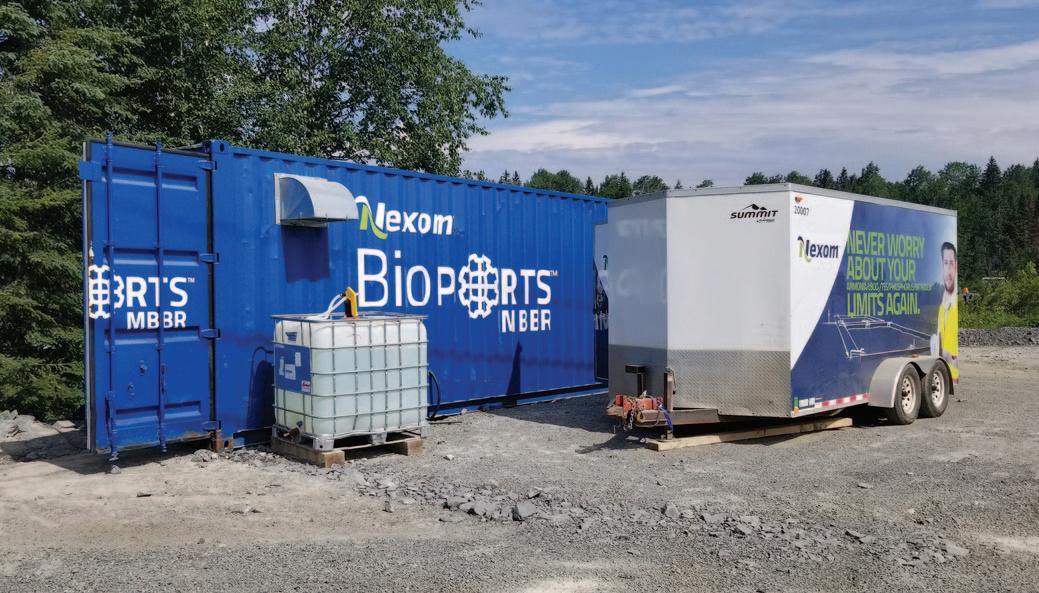
A triumph for agnostic autonomous haulage
Following nearly two years of testing its autonomous haulage system at the Roy Hill iron ore mine, ASI Mining is ready to deploy its agnostic AHS technology to any mine fleet in the world
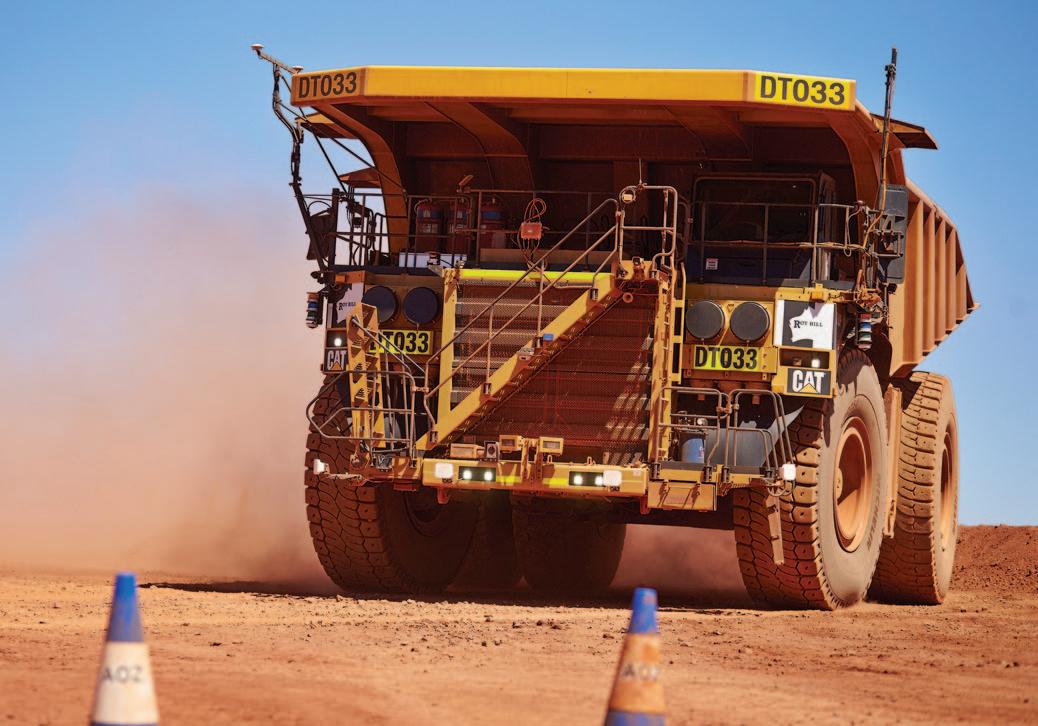 By Mehanaz Yakub
By Mehanaz Yakub
Driverless vehicles are gaining momentum in the mining industry today thanks to both the safety and productivity advantages they can offer. There are a handful of original equipment manufacturers that have created autonomous haulage systems (AHS) technologies that allow them to automate haul trucks under their own brand. The early adopters of the systems tend to be large tier-one mining companies that can afford the infrastructure and teams to perform pilot projects.
This, however, is beginning to change thanks to ASI Mining, a Utah, U.S.-based autonomous technology developer. ASI Mining, partly owned by Epiroc through a 34 per cent acquisition in 2018, has developed an AHS technology that can convert any conventional haul truck into an autonomous one.
“AHS is no new concept,” said Diederik Lugtigheid, president of ASI Mining. He had been director for the AHS implementation at Roy Hill from 2021, before joining ASI in December 2022. According to Lugtigheid, what makes ASI’s solution stand out is that it is OEM agnostic—meaning the company’s autonomous solution is completely interoperable and scalable regardless of vehicle make or model.
“The reality is there’s a lot of customers out there who have a mixed fleet,” said Alex Grant, global director of AHS at Epiroc Australia. “We can turn any truck in your fleet into an autonomous truck. This means that customers can keep their existing fleet, so the entry-level into AHS for mid-tier and lowtier customers is more affordable.”
ASI Mining has dedicated years to the development of autonomous technologies but required a chance to demonstrate the effectiveness and safety of its AHS solution in a real-world environment before bringing it to market.
Initially, ASI embarked on its first AHS test pilot at the Ferrexpo Yeristovo mine in Ukraine in October 2019. The company was testing six vehicles at the mine, with plans to expand and automate a fleet of 15 haul trucks, but the Russian invasion of Ukraine in 2022 halted the entire project.
A separate opportunity arose in 2020, when it was approached by Hancock Prospecting, the majority owner of the Roy Hill iron ore mine in the Pilbara region of Western Australia, with the challenge of developing and testing its AHS on Roy Hill’s mixed fleet consisting of Caterpillar 793F (models SSP and CMD) and Hitachi EH5000 haul trucks.
“What Roy Hill really was saying was, ‘Look, we know it’s not a fully developed product, yet we’re happy to develop it with Epiroc and ASI Mining. We want to come out and bring this affordable product to the mining community because the mining industry needs an agnostic system,’” said Grant.
Verifying the technology
The AHS project at Roy Hill was split into three implementation phases following a preliminary engineering phase. Early engineering involved characterizing the trucks and figuring out the necessary steps for integrating the autonomous kit onto the existing Roy Hill fleet, while contracts were being signed.
Once that was complete, the first implementation phase focused on installing the autonomous kits onto a Caterpillar 793F and a Hitachi EH5000. The objective was to demonstrate to Roy Hill that these trucks could be successfully mobilized and perform various tasks.
Starting in October 2020, the project entered into its second phase, known as the production verification phase. This included meeting key performance indicators (KPIs) related to reliability, productivity and utilization of the AHS, using a fleet of 10 haul trucks. The fleet operated in a dedicated autonomous operating zone at Roy Hill, interacting with two excavators and other ancillary vehicles at intersections, waste dumps and load areas.
ASI’s AHS technology is built utilizing its Mobius traffic management system, which enables controllers sitting at the Roy Hill Remote Operations Centre in Perth to seamlessly track, trace and navigate the haul trucks via a wireless network.
During the second phase, the team worked on improving both the physical components of the trucks as well as all the software components.
The phase’s goals, Lugtigheid explained, were to study the fleet’s performance by conducting stress tests on various components, wires and connections in extremely dry and wet conditions in the Pilbara; identifying areas where time was being lost during the trucks’ operational process; and finding opportunities to outperform human-driven trucks during the operation cycle. Once ideas for improvements were pinpointed, they were implemented, tested, validated and then released.
One of the most challenging parts of the project, according to Lugtigheid, was the constant need for ongoing and progressive adjustments to the system. These changes were essential to ensure that the technology would be fully prepared for widespread commercial use.
“We basically went through a period of time where we would change things almost continuously, week by week, month by month, to gradually improve and get the system to where it is today,” said Lugtigheid.
The alterations carried out for the fleet were primarily aimed at achieving peak efficiency within the mine. The teams addressed various facets of the fleet, including refining the braking and steering mechanisms, optimizing the functionality of shovels and loaders, and determining the appropriate number of tonnes of material each vehicle could carry for the distance it travelled.
“That’s been a lot of work for a long time simply because changes like these need to be validated and tested, people need to be made aware of them and trained, and documentation needs to be updated,” said Lugtigheid. “There’s a whole list of things that comes with doing those [changes] that were very labour intensive.”
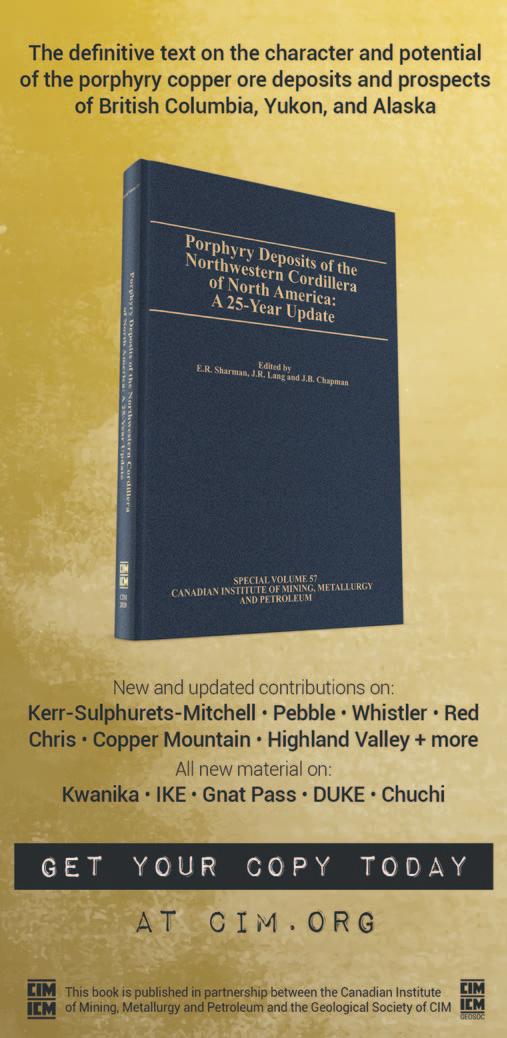
After more than 18 months, the production verification stage concluded in December 2022 with the autonomous fleet achieving productivity targets.
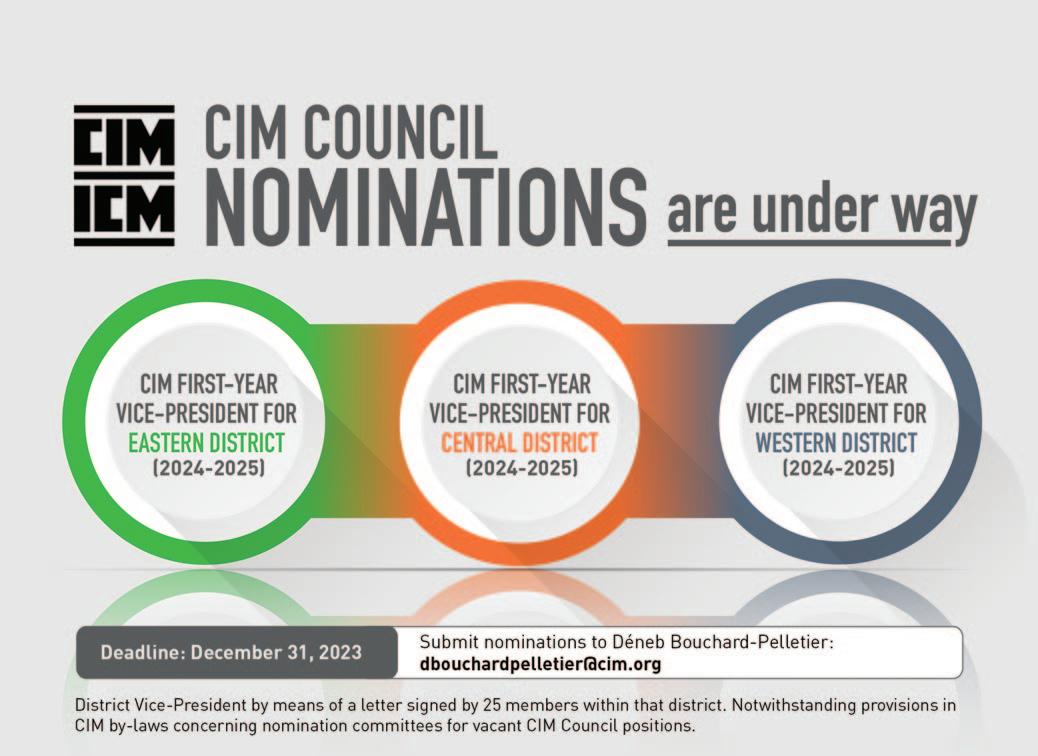
Final steps and global deployment
Having effectively finished the verification stage, ASI has been able to fully validate the overall performance capacity and operational safety of its AHS. This achievement has positioned the solution not only for immediate deployment across Roy Hill’s entire truck fleet, but also gives ASI the confidence to offer it to other potential customers.
“Roy Hill was incredibly important for us because it allowed us to run this fleet of 10 trucks in a real mining environment 24/7,” said Lugtigheid. “At the end of the day, we’ve had test drives in Utah, we have a scalability lab and we simulate a lot of things, but nothing is as important as running it in a fully productive environment like in a real mine, and Roy Hill basically accommodated that for us.”
In January 2023, the project entered its third and final phase with Roy Hill committed to transforming its entire haul truck fleet to autonomous haulage using the ASI solution.
“The critical thing for Roy Hill that we were made aware of at the very beginning was this is their only mine, so there’s a lot riding on it. This was why they needed that verification phase; they needed to be sure that we could perform at the right level, so we don’t affect the ultimate output,” said Grant. “Once we hit the [verification phase] metrics, that was one of the trigger points where Roy Hill said, ‘Okay, you have a productive system, which we could put in our business.’”
The plan was initially to convert a fleet of 78 trucks to autonomous haulage, but in August Roy Hill ordered an additional 18 Hitachi EH4000 trucks, bringing the total fleet to 96 trucks that need to be converted. “I think that’s a testament to our system,” said Grant. “We’ve now got four different truck models with three different truck body sizes, and we can accommodate that in our system. [The size and model] don’t matter for us.”
So far, 32 trucks at Roy Hill have been successfully transformed, and according to Lugtigheid, the plan for the next year involves converting six trucks per month. Upon completion, which is scheduled for 2024, Roy Hill will be the world’s largest largest single autonomous mine.
Looking to the future, Grant said the ASI and Epiroc teams will be looking to Roy Hill to determine the next phases of development for the mine. However, he did highlight that ASI’s Mobius autonomous platform could offer Roy Hill a chance to further elevate safety measures within the mine’s operations. This potential stems from the platform’s ability to support other ASI-developed mining applications as well, such as Mobius for Blasting, Mobius for Drills and Mobius for Dozer.
Meanwhile, beyond the Roy Hill project, ASI is primed to introduce the technology on a global scale. The company is already engaged in discussions with potential customers in Chile, North America and other parts of Australia.
“We haven’t made any announcements, but I’m sure soon we’ll get the second site, and we will be doing the same thing we did at [Roy Hill],” said Lugtigheid. “There’s a lot of interest because a lot of mining companies want an autonomous solution
Until his retirement, Robert Horn was a professional geoscientist based in Ontario. He now lives in Victoria, B.C. During his career, he worked in exploration and mining in South America, Africa, Australia, Europe, China, Indonesia, Canada and the U.S. He held senior management positions with BP Minerals, FMC Gold and Inco Limited.
Horn has served on expert committees of the European Union (EU) and the Nuclear Energy Agency (NEA) of the OECD, both in Brussels, and the International Atomic Energy Agency (IAEA) in Paris. He was a member of the Geological Survey of Canada advisory committee in Ottawa and was chair of the Ontario Geological Survey advisory board. He has also been a member of the board of directors of several public companies. In 2004, he received CIM’s A.O. Dufresne award for services to Canadian mineral exploration.

Russian culture, particularly music and literature, has interested Horn since school; he took a course in the Russian language at the University of Victoria, and that knowledge proved useful when he later visited Ukraine.
After the invasion of Ukraine by Russia in 2022, Horn felt strongly that he must do all he could to support the country. In March of this year, he went to Kyiv and met with professors from the Institute of Geology at the Taras Shevchenko National University, as well as various government officials. His aim was to try to find out what could be done to assist Ukrainians, not militarily but by foreign government assistance and eventually, when conditions improve, foreign investment. Since then,
Exploration support
Geoscientist Robert Horn says Canada has the tools needed to help develop Ukraine’s metal and mineral resources
By Ailbhe Goodbodyhe has tried to get support for Ukraine through Canadian and European organizations.
CIM: Could you give us some background on Ukraine’s geology and mineral reserves?
Horn: Even in time of war, the annual value of mineral production in Ukraine is US$15 billion. In the absence of war and with adequate foreign investment, the country could potentially earn a substantially greater income from mining. Some estimates put this possible income higher than US$10 trillion. In short, Ukraine is a major actual source of metals and minerals with the potential to become one of global importance.
The Ukrainian Shield contains most of the country’s mineral resources and consists of rocks of Archean to Proterozoic age. The shield covers an area of around 250,000-square-kilometres in a belt from east of Crimea on the Black Sea to the Belarusian border in the north. Ukraine is the biggest producer of manganese and the second-largest producer of iron in Europe. It has by far the largest reserves of uranium in the continent, with more uranium than the rest of Europe put together. The country is the third-largest producer in the world of the metal gallium (an important component of semiconductors), and the fifthlargest global producer of graphite. It is the only rutile producer in Europe, and the third-largest producer of this titanium mineral in the world.
The University of Pennsylvania’s Kleinman Center for Energy Policy estimated that Ukraine could be a “treasure
trove” of lithium, with lithium oxide reserves of up to 500,000 tonnes. Ukraine has the largest recoverable supply of rare earths in Europe.
The Ottawa-based research tank SecDev said Ukraine has the potential to become a “critical mineral superpower.” That may be overstating it, but Ukraine is already an important supplier of metals to Europe and the world. I believe it is important to recognize that what is at stake in the current war is the control of Europe’s largest resources of a range of metals and minerals. It is not hard to understand why Russia would like to acquire them by force.
Ukraine is a candidate member of the EU. Within the EU, Ukraine would add significantly to the union’s self-sufficiency in several important minerals and metals. To succeed in its accession, the country must meet certain conditions that include tackling corruption and limiting the power of the oligarchs. Kyiv must also address the rights of minority peoples in Ukraine, including Russians. The EU would provide the political stability that has kept most of Europe at peace for many years.
CIM: Why is it important to provide an industrial balance to Ukraine’s otherwise agricultural economy?
Horn: That is an important issue. When you look around Europe or even the world in general, the density of populations tends to follow industrial growth. Take Italy for example—the big industrial centres such as Turin and Milan are in the north, the most densely populated part of the country. The industrial sector is labour-intensive and supports more people, while rural areas dependent upon agriculture are less densely populated. Ukraine is a big country with a population of almost 37 million. If the industrial sector, including mining and its support industries, were to be lost, it would have a devasting effect on the economics of Ukraine. The agricultural and service sectors could not support so many people.
In spite of the rhetoric and spurious historical arguments of its leaders, Russia’s war on Ukraine seems to be largely driven by the desire to acquire valuable assets in parts of its western neighbour that have significant mineral resources. Hence the self-proclaimed republics of Luhansk and Donetsk with their large mining and industrial sectors that have declared themselves independent of Kyiv and therefore ripe for annexation, in a manoeuvre that was strikingly similar to Russia’s acquisition of the Finnish Petsamo nickel mine by a minor shift of the international frontier to the west in 1944.
Ukraine will need substantial financial and technical assistance to rebuild its mining economy after the war. The Ukrainian Shield has a very high potential for the discovery of new resources of metals and minerals. A logical area of the shield for exploration would be far from Ukraine’s border with Russia, to the west and north of the country, in areas that are geologically highly prospective but have had little modern exploration.
CIM: What assistance do you think Canada should provide to Ukraine in seeking new mineral resources in the country?
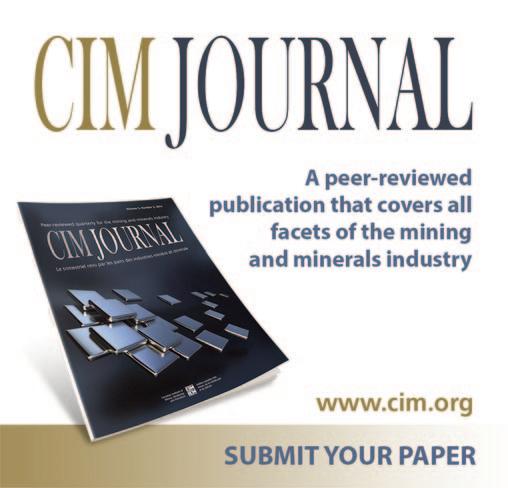
Horn: Experience and knowledge of mineral exploration in Archean-Proterozoic terranes similar to those in Ukraine is confined largely to the Nordic countries, Russia and Canada. Out of this trio, Canada has the greatest resources of geophysical contractors, a highly experienced Geological Survey and a unique
junior mining and exploration sector that has the proven capacity to raise substantial risk capital.
I believe that an important way that Canada could assist Ukraine is by providing regional surveys by low-level, highresolution airborne geophysics and LiDAR across selected parts of the Ukrainian Shield, particularly in the west and north of the country. The most recent regional geophysics dates from the early 1990s. The proposal would be for a joint enterprise financed by the Canadian government and managed by the Geological Survey of Canada working in cooperation with Ukrainian organizations. The regional geophysics would be integrated with a reappraisal of the geology, thus providing the basic technological infrastructure necessary to attract private investment.
In the modern world, ore bodies generally are not discovered by governments but by private companies. Governments do not usually have the kind of specialist knowledge that private companies do. But it is the comprehensive technical infrastructure of geological and geophysical surveys that provide incentives for companies to risk their investors’ money.
CIM: What would the next steps be?
Horn: I think the next step would be to set up a formal meeting between officials from Canada and Ukraine. I envisage a cooperative agreement between the Geological Survey of Canada, the Ukrainian Geological Survey and the Institute of Geology at Taras Shevchenko National University in Kyiv. The aim would be to set up a joint team to negotiate the permits for survey aircraft to operate in the country and manage the regional geophysical surveys using Canadian contractors, as well as a full reappraisal of the economic geology.
I am not suggesting that Canada provide this assistance just to be nice to Ukraine. The world is running short of mineral commodities. Their supply is important for the whole world, not just for Ukraine and Europe.
It is also worth noting that this proposal, if it succeeds, would create a business opportunity for Canadian mining and exploration companies. CIM
Two industries at a crossroads
The
 By Kelsey Rolfe
By Kelsey Rolfe
Jean Martineau never really bought into the way junior mining companies financed their exploration—in his opinion, issuing rounds of shares on the public market to fund exploration work only diluted the value of management’s ownership stake over time. So when Dynacor Group, the company he was newly leading as president and chief executive officer, bought a small private company in Peru in 1996, Martineau saw an opportunity in its half-built gold processing plant. Dynacor finished building the 50 tonne-per-day (tpd) mill by 1998, intending to extract and process ore from the main vein on its mining concession and use it to finance continued exploration on the site.
The area was home to many artisanal miners who came looking to sell their ore. Artisanal miners are informal and largely work with rudimentary or unmechanized tools. “We thought, ‘this isn’t our business, but it could be helpful for them and we can earn some money.’ But it wasn’t a big [focus] for us,” said Martineau.
But the price of gold skyrocketed from roughly US$290 per ounce in 1998 to US$1,300 by the end of 2010, and the number of Peru’s artisanal miners grew along with it. Dynacor developed a progressively larger producer network of artisanal miners and kept boosting its plant’s production capacity. Processing the artisanally mined ore quickly became the company’s main business. In November 2022, Dynacor completed its latest mill throughput expansion, to 500 tpd. It now works
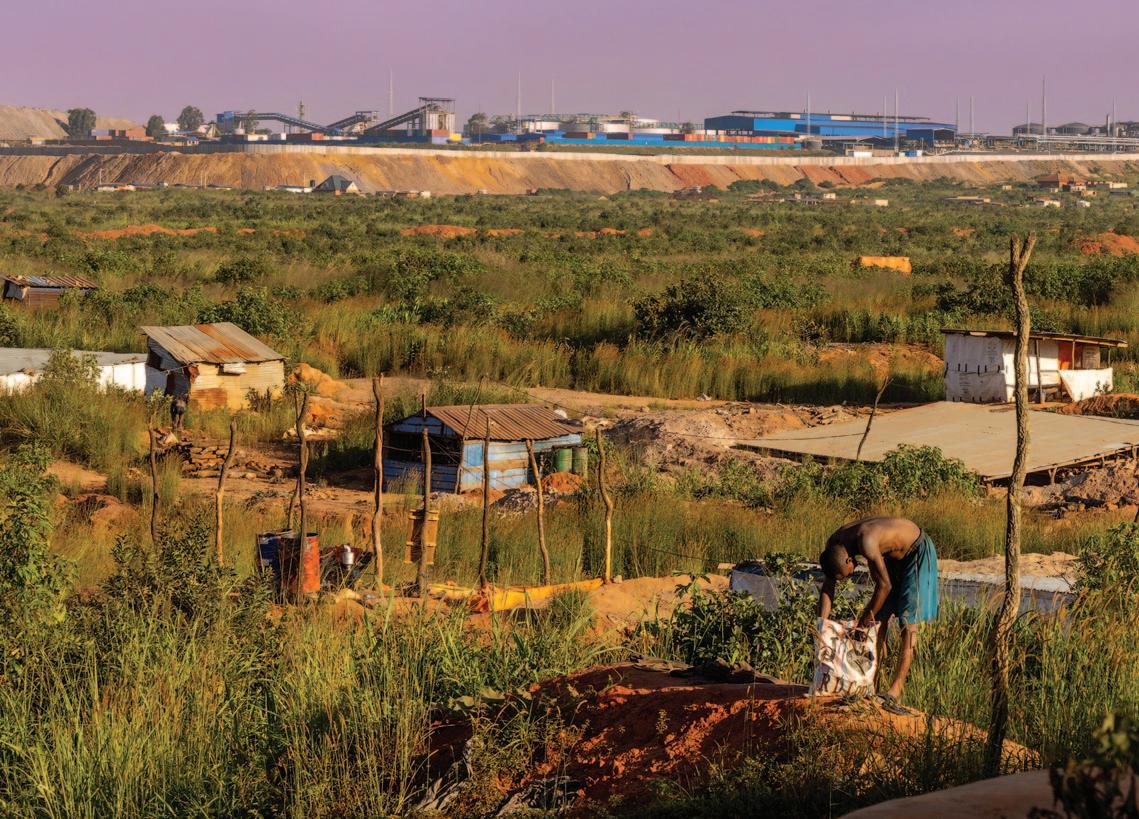
with approximately 1,000 artisanal mining collectives, representing between 5,000 and 6,000 miners.
However, its business model has not been without challenges, Martineau said. Dynacor had to set standards for the types of ore it can accept to ensure a consistent recovery rate, and set up offices around western Peru with 50 employees who develop relationships with miners and analyze the metallurgical properties of their ore. It had to adapt to the country’s changing legal framework around artisanal miners, and now works exclusively with those who are formalized or in the process of formalizing. It also provides health and safety training, support from geologists and help with filling out government paperwork.
Dynacor is one of a small but growing number of mining companies working directly with artisanal and small-scale miners (ASM). The ASM sector, which employs roughly 45 million people globally and economically supports millions more, includes operations ranging from small groups of miners, often digging on concessions owned by mining companies, to official cooperatives that employ workers but generally work with less sophisticated tools than big mining companies. There are around 20 million artisanal gold miners worldwide, with the remainder split between gemstones, diamonds and critical minerals like cobalt, copper and tantalum.
The ASM sector has long had a bad reputation for dangerous operating conditions, poor environmental practices and the
formalization of artisanal and smallscale mining may be necessary to help meet global demand for critical minerals
presence of child or forced labour, and mining companies and their downstream buyers have historically preferred not to engage with ASM miners to avoid legal and reputational risk. But experts say that co-existence models are key to helping formalize the sector and address some of its most entrenched issues, as is advocacy from buyers of critical minerals.
A mindset change among mining companies is “coming, but slowly,” said Marcello Veiga, professor emeritus at the University of British Columbia’s Norman B. Keevil Institute of Mining Engineering. Veiga, who works with multiple mining companies on engaging with artisanal miners, co-authored a 2022 paper for The Extractive Industries and Society journal on varying approaches to co-existence between gold mining companies and artisanal miners in Latin America. This ranges from companies that allow miners to operate on their concessions with minimal or no involvement to those that provide technical assistance and support, and companies like Dynacor that buy and process ASM ore. The paper highlighted arrangements with artisanal miners at sites such as Lundin Gold’s Fruta del Norte mine in Ecuador and AngloGold Ashanti and B2Gold’s Gramalote project in Colombia.
The voracious demand for critical minerals may create an imperative for more companies to help formalize the sector, said Rob Karpati, senior advisor at the Blended Capital Group, a corporate and investment advisory company. “The bottom line is
that there is either a win/win or a lose/lose approach: one where lack of engagement [with ASM] leads to conflict and value destruction, or one where earnest engagement leads to collaboration along with mutual value that extends to the community and down the value chain as productivity is enhanced,” he said.
“ASM is a legitimate sector that has existed for many centuries in different formats. Bringing stability [by] equipping, training and driving them towards best practices makes it fair and increases productivity while you’re at it. It means you can contribute [more] to the energy transition if there’s more copper and cobalt.”
Different approaches
Engagement with the ASM sector to date has been led by nongovernmental organizations (NGOs) and intergovernmental organizations like the United Nations Environmental Programme (UNEP), many of which aim to provide health and safety training and address environmental issues.
These projects are well-intentioned but “cosmetic,” Veiga said. Take programs to eradicate mercury use in the processing of artisanally mined gold, for example. According to the UNEP, ASM gold mining operations are responsible for 37 per cent of global mercury pollution. But programs designed to teach artisanal miners about the health and environmental dangers of mercury ignore the financial realities of individuals or smaller operations. “You can teach them, but if they have no money it doesn’t matter,” Veiga said.
Additionally, many ASM gold miners are not processing the gold themselves, but taking their ore to middlemen with processing facilities, whom Veiga called “sharks.” After the miners hand over their ore, the processing facilities recover a poor percentage of the gold—typically 30 per cent or less—and pay miners a small sum. The facilities retain the tailings and use cyanide to extract the remaining gold for themselves. “When people say we need to find alternatives to replace mercury, [I just think] we need to stop the sharks,” he said. “The only solution is companies working together with artisanal miners.”
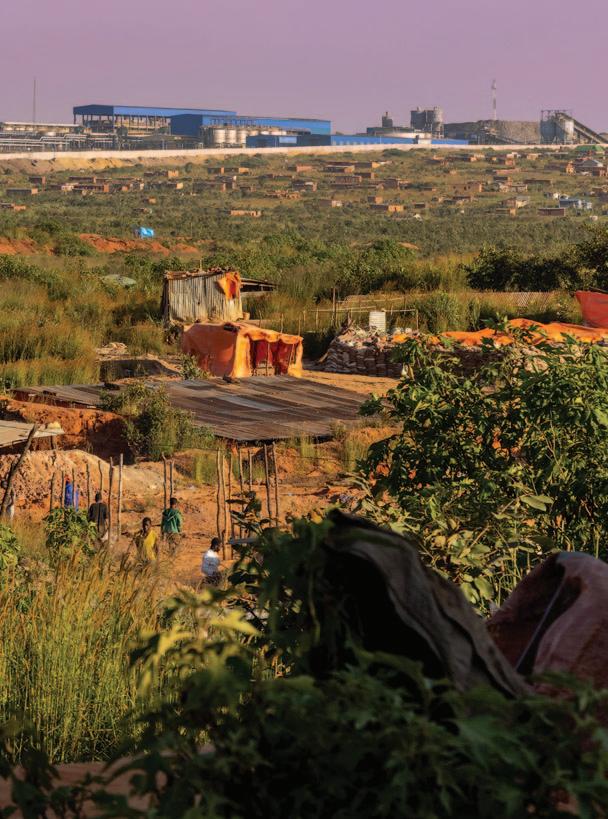
Ruby Stocklin-Weinberg, program manager of De Beers Group’s GemFair program, noted NGO-led programs are also generally unable to operate for long enough to introduce lasting changes. Her PhD research at UBC focused on developing successful training programs for artisanal miners. “Most projects I looked at lasted [between] three to five years, and that’s just not enough time,” she said.
GemFair, which launched in 2018 as a pilot program, buys diamonds from artisanal miners in Sierra Leone and sells them to the international market. A team of De Beers employees in the country’s Kono District evaluates ASM operations to ensure their labour, health and safety and environmental practices meet the company’s minimum standards for program participation. The company also does classroom and hands-on training with miners to improve their practices, and has procured safety equipment for them.
Stocklin-Weinberg said the program’s evolution demonstrates the value of working with artisanal miners over a longer timeframe. Since its initial pilot stage (which transitioned to a full program in 2021), the GemFair team has found more efficient ways to bring miners into the program and train them, allowing it to add roughly 50 ASM sites per year. She added that the company is revisiting its approach to mine site monitoring but has not seen evidence of child or forced
labour, conflict financing or human rights abuses at any of the operations it works with. De Beers is planning to evolve its standards to make it possible for miners to join the program earlier in their journey to meet the requirements, and is looking to introduce thematic-based training, including on topics such as site reclamation.
“There’s still so much to learn, and it’s been five years,” she said. “Most other projects would’ve wrapped up by now.”
The Victoria, B.C.-based Artisanal Gold Council (AGC) is working to provide training to ASM miners and develop responsible supply chains, with four active programs in Mongolia, the Philippines, Burkina Faso and Guyana. Its Burkina Faso program, which began in 2019 and is set to wrap up in 2025, is training 150 miners on mercury-free gold processing technologies and helping them organize into cooperatives, apply for licences to operate and receive business financing.
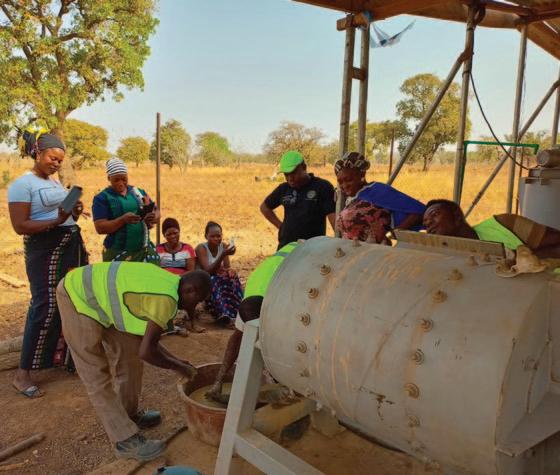
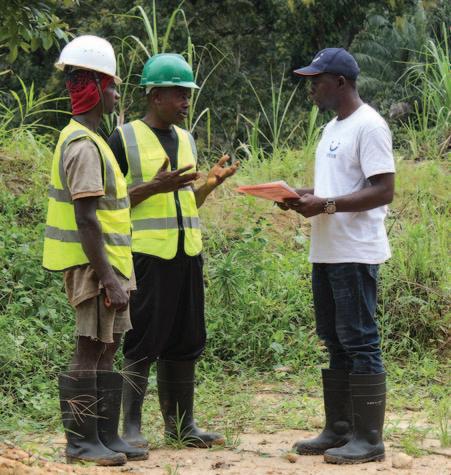
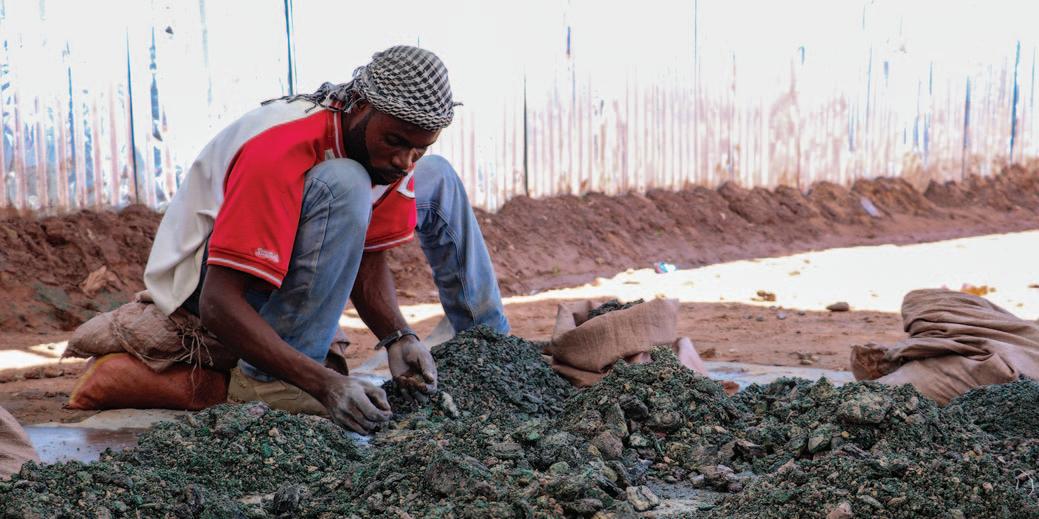
Saidou Kabre, the AGC’s national project manager for Burkina Faso, said that with the AGC’s help, the formalization process takes about a month. “The complexity is that most of the miners are illiterate, and don’t possess the necessary documents,” he said. To prepare for the ending of the program’s support, he said the AGC has been fostering connections between relevant government agencies, existing cooperatives and other critical stakeholders, including financial institutions.
Kabre acknowledged that the mercury-free gold processing technologies miners were being trained on are expensive and only currently operated at one pilot site in the country. Scaling up to service Burkina Faso’s roughly 800 artisanal mining sites would require greater support from donors and other collaborators, he said. One solution the AGC has pursued is to develop manufacturing capacity with local professionals so that equipment can be built locally instead of being imported.
Navigating the legal landscape
It is easy to say mining companies should pursue co-existent relationships with artisanal miners, but it is harder to execute them. One major hurdle is many countries’ legal landscapes around the ASM sector.
“There are not many producer countries where artisanal mining has its own category in the mining code,” said StocklinWeinberg. Sierra Leone’s clear regulations regarding the ASM sector were a “very big motivation” for De Beers to begin working there.

Dynacor is considering building gold mills in two other countries, Martineau said. When approached by representatives of Latin American and African countries, the first thing Martineau asked is how or whether artisanal miners exist under the country’s mining laws. “If I have a legal mill, how would I buy ore legally from illegal miners?” he said. In Senegal, one of the countries Dynacor is considering, the government has reserved a particular area where artisanal miners can operate legally if they register with the mining department.
Even in countries with formalization processes, Veiga noted they tend to be overly bureaucratic and contain too many hoops for miners to jump through. This can be especially challenging for miners with low literacy levels and those who live far from government offices.
Peru’s ASM formalization approach required several revisions to address the realities of artisanal miners. An earlier version of the legislation required ASM operations to complete the same kind of environmental assessment as a major mining company, which has since been simplified. To date, the country has approximately 9,600 formalized ASM operations. While Martineau said the process is improving, Dynacor often has to help its suppliers navigate it.
To comply with the law, the company has a stringent, 27point verification process. When considering a new miner, it will verify their operations’ location, that they own or have a legal right to be on the concession and what stage they are at in the formalization process. Dynacor also sends a geologist to the property to confirm that the ore actually comes from there and to determine whether there are children working on site.
Formalizing DRC miners
The Democratic Republic of the Congo (DRC) has become a focal point of discussions around formalizing the ASM sector. According to Natural Resources Canada, as of 2021 the DRC hosted 46 per cent of the world’s known cobalt deposits and was responsible for 73 per cent of the world’s cobalt production. ASMproduced cobalt constitutes 15 to 30 per cent of the country’s annual cobalt output and 10 per cent of global cobalt production.
The country established a framework in 2018 to formalize ASM operations and transition artisanal miners to small-scale operations, requiring miners to become registered, receive permits and operate in a legally designated area. But according to Anne-Marie Fleury, Glencore’s responsible sourcing director: “There are not many ASM operations that meet all these requirements yet.”
One short-lived ASM formalization pilot project highlighted the operational and livelihood improvements to miners from legal ASM. The project, launched by Chemaf Resources and Trafigura Group in 2018 with the support of Congolese authorities, arranged for a cooperative of artisanal miners to work in small open pits on Chemaf’s Mutoshi concession. The companies
provided technical assistance, training, safety equipment and geological information. The project also brought women into the ASM workforce, which Dorothée Baumann-Pauly, director of the Geneva Centre for Business and Human Rights at the Geneva School for Economics and Management, noted in a February 2023 paper increased family incomes and allowed children to attend school, reducing child labour.
But the suspension of the project in March 2020 due to the COVID-19 pandemic undid those changes. During a site visit in December 2022, Baumann-Pauly learned that formalization standards were no longer observed. Miners were not wearing personal protective equipment, the open-pit mines had been
replaced by “about 150 poorly ventilated and unstable shafts that lead to deep vertical and long horizontal tunnels,” and more than 15,000 miners, including children, were working at the site—well up from the 5,000 adults working there during the formalization pilot project.
In an email to CIM Magazine, Trafigura’s head of media relations Victoria Dix said the company had opted not to restart operations due to changes in Congolese law in March 2021 to establish the Entreprise Générale du Cobalt (EGC), an agency meant to oversee artisanal mining and purchasing of domestic ASM cobalt ore prior to the processing stage. The EGC’s rollout has been hampered by internal government controversies.
Those types of operating conditions are why many major electronics and automotive companies have tried to contractually exclude ASM-generated cobalt from their products.
But Baumann-Pauly’s paper called on cobalt end users to work with mining companies to encourage the proper formalization of ASM in the DRC. “Without ASM cobalt, buyers will not be able to meet a global demand that is projected to increase fourfold by 2030,” she said in a press release.
Michael Posner, director of the Center for Business and Human Rights at New York University’s Stern School of Business, said cobalt mining companies and buyers should work together to set standards for how to engage with artisanal miners. “There needs to be a collective effort,” he said.
Fleury agreed, noting that Glencore has evolved its approach to ASM operations over the past few years. “We recognize the importance of ASM producers in the cobalt supply chain and DRC communities. Industrial companies like us have a role to play, but partnership approaches are needed to address the issues.”
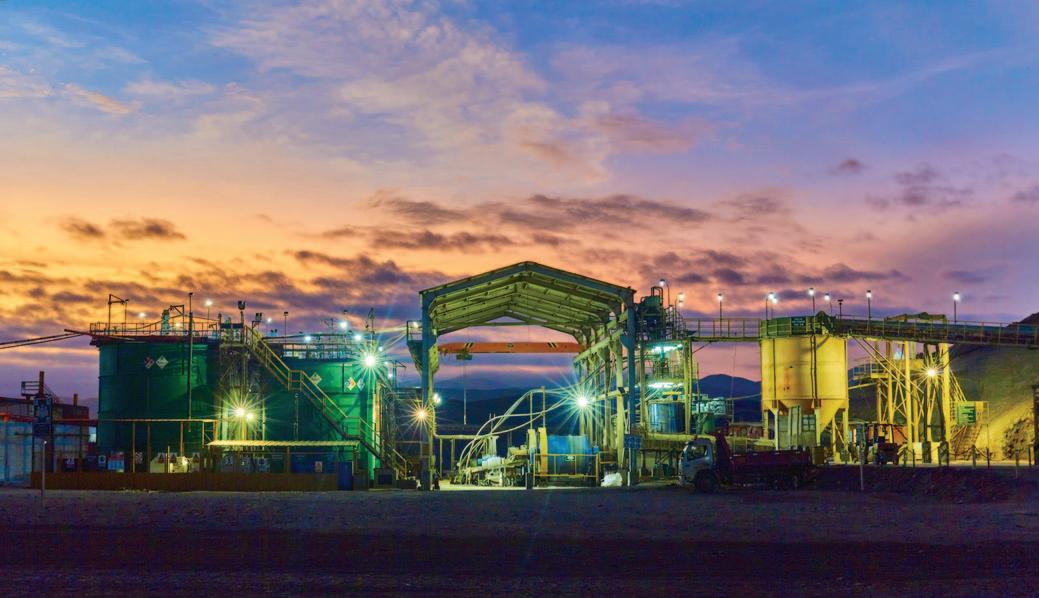
Glencore has no plans to buy or process ore from artisanal miners, which Fleury said is because its two DRC sites are largescale, integrated operations that mine all their own cobalt and copper for processing and export with no need to purchase from any third parties.
Glencore’s approach to building partnerships has been to join the Fair Cobalt Alliance in 2020 to address the “bigger picture and root causes” of the country’s ASM sector. The organization, which also counts Tesla, Google and other civil society and human rights organizations among its members, works to help Congolese ASM cooperatives formalize their operations, address child labour in ASM and develop other economic opportunities in communities. “We realized that what we want to do we cannot do alone,” Fleury said. “We’re an industrial, commercial player and the issues associated to artisanal mining can’t be solved exclusively by a single actor, or by the large-scale mining industry or cobalt supply chain alone.”
Building trust
When a country’s legislation is on side, co-existence models can work well if there are specific conditions in place, Veiga said. Chief among them is a commitment to building trust with miners.
Martineau said Dynacor has built trust through being completely transparent about its pricing and ore analysis. When artisanal miners bring ore to Dynacor’s plant, they watch as it is weighed and crushed, as 60 kilograms is put through a small dry ball mill, and as four samples are prepared from 10 kilograms of the milled material.
The first sample is given to the miner, the second is analyzed immediately and two are set aside. Dynacor’s lab returns its results within 24 hours, and if the miner is happy with the assessed value of the ore, they can be paid upfront. The company pays between 70 to 80 per cent of the gold value in the ore it sells. If the grade of the ore seems unusually high, a third sample is analyzed to confirm it, and if the miner does not trust the company’s analysis, they can take their own sample to another lab. If there is a difference between the two samples, the fourth is sent to an international lab in Lima.
“The miners see all the preparation, it’s very transparent and it’s very appreciated by them,” he said. “They are human beings; we have to treat them with respect.” CIM






Cluff Lake rebirth
Orano Canada spent 21 years decommissioning and reclaiming its Saskatchewan uranium project—almost as long as the 22 years the mine was in operation
By Alexandra Lopez-PachecoThis past May, the Canadian Nuclear Safety Commission (CNSC) accepted Orano’s application to revoke its mining and milling licence for the Cluff Lake uranium project in northern Saskatchewan. While uranium miners from the early 20th century would likely have raised eyebrows at the time and responsibility it took for Orano to move on from the project, for the company and the province, it was cause for celebration.
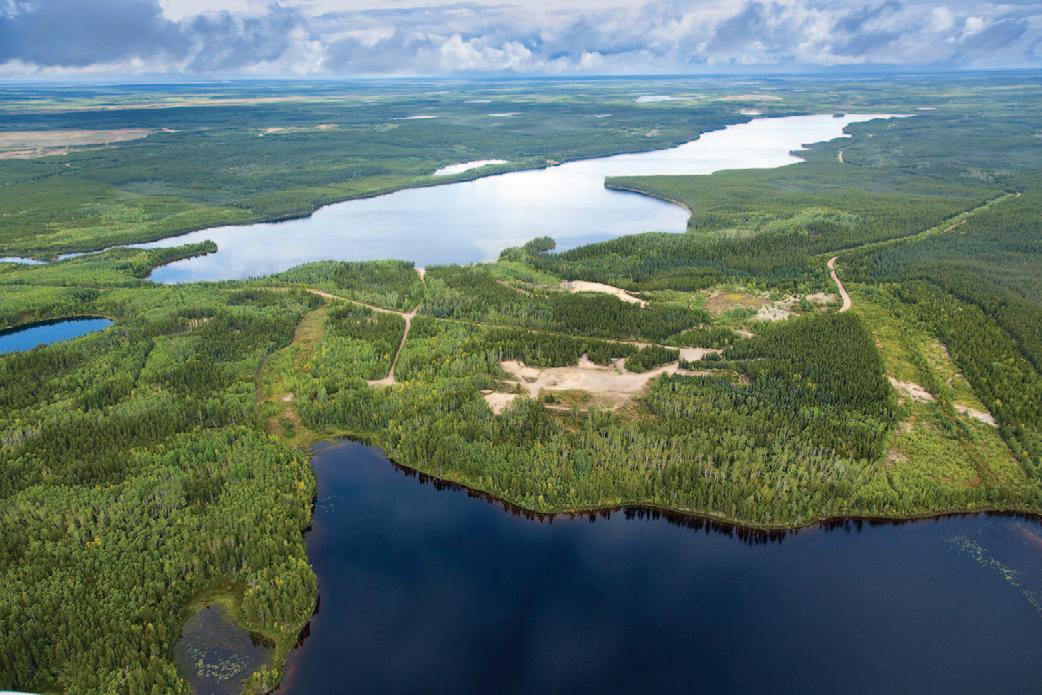
“It’s the first second-generation uranium mine in Saskatchewan,” said Tim Moulding, a manager with compliance assurance at Saskatchewan’s Ministry of Environment. “And it’s the first project that has been through all the environmental processes that are in place now, right from the assessment of the project through to the release and entry into institutional control. It’s an example of the way we want to do things.”
By design
The Cluff Lake project represents the turning point from the environmentally irresponsible approach to uranium mining in Saskatchewan during the first half of the 20th century towards today’s rigorous environmental processes and standards. It also represents the birth of Saskatchewan’s uranium mining sector as a global leader.
It began in 1976 when Orano, then named Amok, submitted an environmental assessment to the Saskatchewan government with the hope of developing a mine and mill at the high-grade uranium ore deposit it had discovered at Cluff Lake. At the time, Saskatchewan was already plagued by the legacy of numerous post-war uranium mining projects near Uranium City on the northern shores of Lake Athabasca; the private mining companies in the area had abandoned the mines once they had extracted the resources with no regard for the risks the sites posed to the nearby communities. For example, the company that owned the Gunnar mining project, once the world’s largest uranium producer, simply flooded the pit and abruptly exited, leaving behind a ghost town surrounded by land haunted by the perilous conditions it had created.
When Saskatchewan’s Ministry of Environment received the environmental assessment for the Cluff Lake development, it asked the Lieutenant-Governor-in-Council for a public inquiry to determine if Saskatchewan should expand its uranium mining industry. Led by Justice Edward Bayda, the 16-month-long Board of Inquiry included the participation of the Atomic Energy Control Board and other federal regulatory agencies. The resulting 1,000-page report, published in 1978, not only gave the green
light to uranium expansion, but it also presented a detailed guidebook with 54 recommendations for uranium mining from cradle to grave that included everything from worker health and safety to environmental and social responsibility.
“It was a review of the environmental aspects and implications of the project before construction, with a general understanding of what the potential impacts could be and that those could be quantified and agreed to before the project was allowed to proceed,” said Moulding. “The commission report made recommendations regarding environmental approvals for the operation, and that led to the approvals process for construction, operation, preliminary decommissioning and reclamation planning. A lot of the work that ended up being part of Cluff Lake’s decommissioning and reclamation planning was initially thought out in that original assessment. That was one of the key pieces on this project [that was more stringent] than what had been done previously, as they started out with an understanding that it would need to be decommissioned and reclaimed properly and started putting together plans to make sure that happened.”
On July 30, 1978, the New York Times accurately predicted the impact the Bayda report and the Cluff Lake project would have on the future of Saskatchewan’s uranium mining industry: “A decision last month by the leftist government of Saskatchewan is due to transform this quiet prairie province into one of the world’s most important suppliers of uranium.”
From end of life to natural rebirth
Before construction of the Cluff Lake project began in 1979, Orano had already submitted its preliminary decommissioning plans and cost estimates. The company updated its plans and submitted them to the Saskatchewan Ministry of Environment for approval every five years.
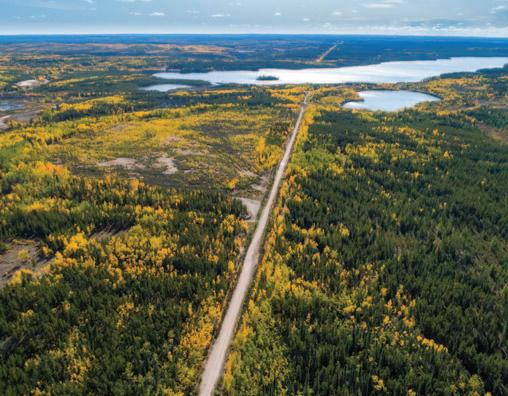
When the operation reached its end of life in 2002, Orano began implementing these plans. By then, Cluff Lake had produced more than 62 million pounds of uranium concentrate from two underground mines and four open pits. The decommissioning of the project took some four years, and consisted of treating all contaminated water, removing all structures and systems— including an air strip, a power plant, sewage treatment systems
and landfills—securely closing off mine openings, backfilling underground mines as well as turning open-pit areas into lakes. This was followed by earthworks and revegetation, including planting hundreds of thousands of trees on the site.
From an environmental perspective, however, the most significant challenge for any mining project lies in the tailings management areas (TMA). In 2000, as Orano was readying to end operations at Cluff Lake, it launched a comprehensive analysis of the project’s TMA, which explored the best options to safely decommission it.
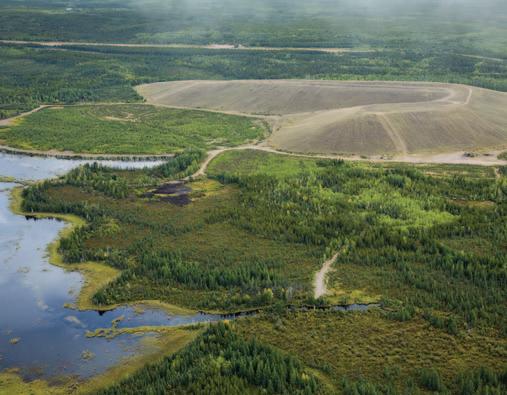
For this analysis, Orano’s team conducted ecological risk assessment modelling for the various options, which predicted their impact on air, water and sediment quality for a period of 10,000 years. This was not theoretical. Instead, it was based on in-depth data from meticulous testing—as required by strenuous regulations governing uranium mining—and decades of research by Orano to better understand the natural environment and water flow at Cluff Lake.
“All through decommissioning and through operation, we monitored,” said Kebbi Hughes, Orano’s senior geo-environmental scientist, who has worked on the decommissioning project since 2007. “At an operating [uranium] mine, they are very cognizant of radiation exposure.”
In the end, Orano chose the option of a soil storm cover, ranging from one to six metres in depth, that is gently sloped to cause most of the rainwater to flow off the area and prevent it from going through the contaminants and radiation buried beneath the surface. Additionally, the design included ditches to capture extreme rainfall events caused by climate change. Orano’s goal was not to simply seal off the TMA; that approach comes with the risk of failure in the containment suddenly releasing large amounts of contaminants into the environment. Instead, Orano’s team set out to create a very slow rate of release over 10,000 years.
“A lot of people wanted us to just put a huge thick cover on the tailings,” said Hughes. “That’s actually worse; a thick cover would take in too much water and would direct it down through the tailings. That would cause a higher flow rate out and we really don’t want that. It has to be just right—thin enough so that a lot of the water evaporates off or is drawn out by vegeta-
tion, and with a predictable rate so the small amount of rainwater that does get through will move through the cover and then the tailings. We can use that rate to understand how quickly contaminants in the tailings will reach the downstream environment. I think it’s important that people think about tailings not as something you want to keep in one spot forever. We can’t expect for the tailings to sit there over thousands of years and do nothing. Instead, what we do is ensure the contaminants move out very slowly at a controlled rate so there is no significant risk to the downstream environment.”
Once the reclamation work was completed in 2006, Orano began testing and monitoring the air, water, land and vegetation to ensure radiation and contaminant levels were back to natural, safe levels and that the TMA cover was behaving as planned. In 2013, after some seven years of monitoring and confirming the results were as predicted, the vast majority of the property was opened to the public for traditional use, from hunting and gathering to fishing and swimming.
Orano, however, continued monitoring the former mine’s TMA and reporting the results to Saskatchewan’s Ministry of Environment. “The post-decommissioning monitoring phase was in place so we could understand that the work that was completed had been effective,” said Moulding. “That’s why it took the time it took.”
Having demonstrated the stability of Cluff Lake’s TMA over almost two decades, Orano was finally allowed by the CNSC in May to begin the process of handing off the site to the Institutional Control Program (ICP).
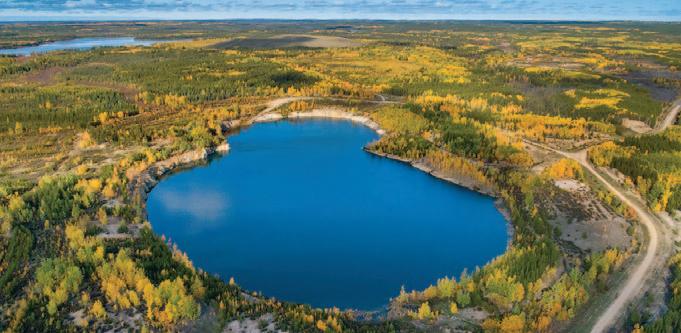
Continuous improvement
The sustainable mining practices in Saskatchewan, from planning to reclamation, have progressed. In 2007, the province established the ICP for reclaimed industrial sites to support safe, environmentally sound decommissioning of mining and mill sites and to ensure ongoing monitoring and maintenance of reclaimed sites. It includes a registry of closed sites and manages funds that the companies decommissioning their projects must pay into.
“We’ve demonstrated that the lakes and rivers are safe, but we still want the province to go up every five years and do some water samples just to make sure it continues to be safe,” said Dale Huffman, Orano Canada’s vice-president of operations. “We have every confidence it will, but this is important for the confidence of the public. We have to make sure there is money for the monitoring program and to make sure if there’s a problem, the expense of that property goes to us, not to the public.”
For perspective, the remediation of the Gunnar mining complex, which finally began in 2006 when the governments of Canada and Saskatchewan contracted the Saskatchewan Research Council to manage the cleanup of 37 abandoned uranium mine sites near Uranium City, is still ongoing.
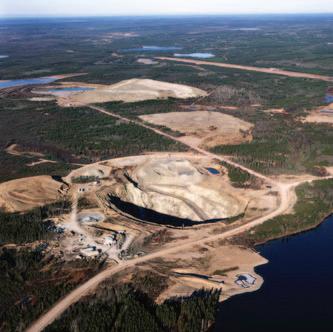
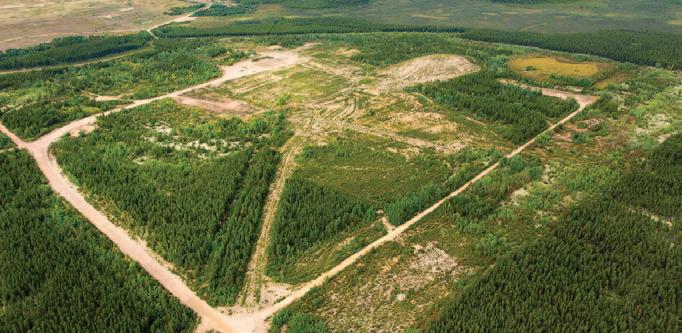
“It’s really important to do this work in a sustainable fashion,” said Hughes. “We can’t just dig things out and then leave piles of sludge around for people to try and clean up later. We can do it well right now and so we should.” CIM
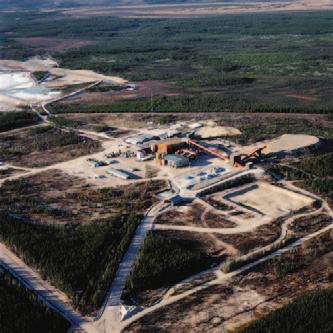
Screen time
Efficiency, uptime and optimization is the focus of companies offering a wide range of screening technologies
By Tijana MitrovicFrom processing to classification, screens and screening media are critical in ensuring the correct particle size for mineral processing, but they can also lower costs and downtime and improve capacity.
Today, manufacturers offer a wide range of screens and screening media solutions for the mining and mineral processing industries that can screen coarse or ultra-fine material, increase capacity and monitor performance.
When customization is key
When FLSmidth acquired the Australian engineering and equipment supply company Ludowici in 2012, it was looking to break into screening technology.
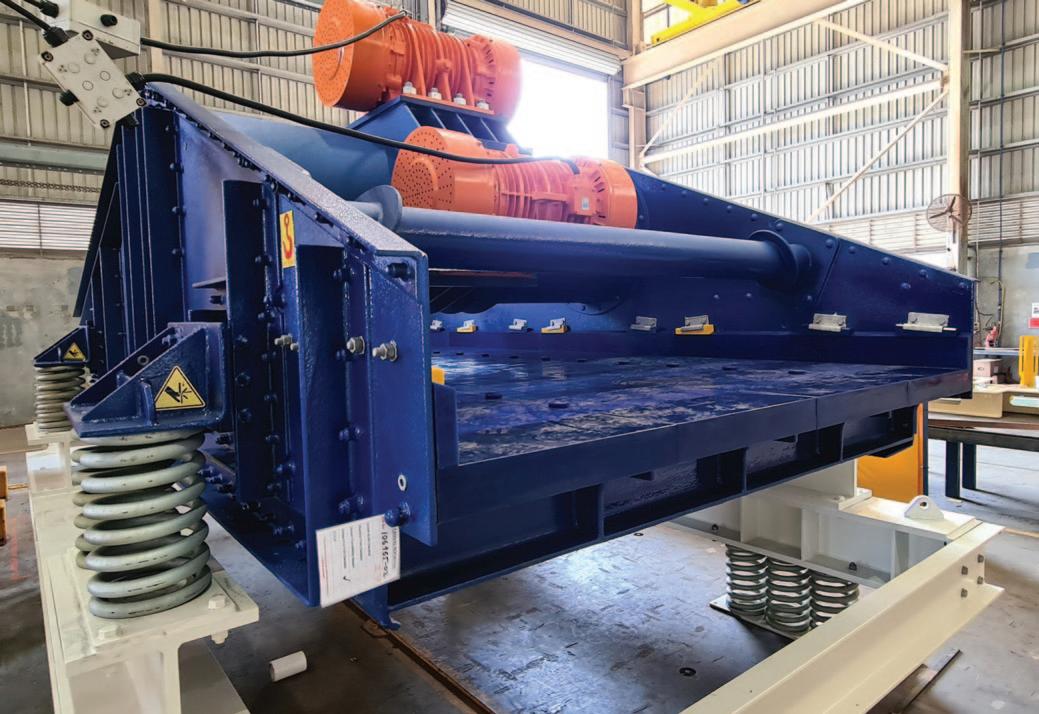
Eddie McKerr, who worked for Ludowici until its acquisition and is now the global product line manager for screens at FLSmidth, explained that when the company shifted its focus from circular to linear motion screens, it helped increase screen sizes and capacities. “Linear motion screens were a fairly significant upgrade on circular motion in terms of their screening efficiency,” he said. “They could also be applied to many more applications than the circular motion screens.”
McKerr added that this is why linear motion screens have been a focus of FLSmidth’s product development over the years. “We’ve been able to bring them in to replace circular motion screens; for example, sometimes on the same size footprint of the screen, it can—under the right conditions—double the
Electrify your operations

throughput capacity because they’re just so much more powerful and efficient,” he noted.
FLSmidth also works with mining companies to customize screens when necessary to make the product work for them. “Understanding what their plant layout looks like and tailoring our screen to match means the client doesn’t have to modify their plant to install our screen,” McKerr explained.
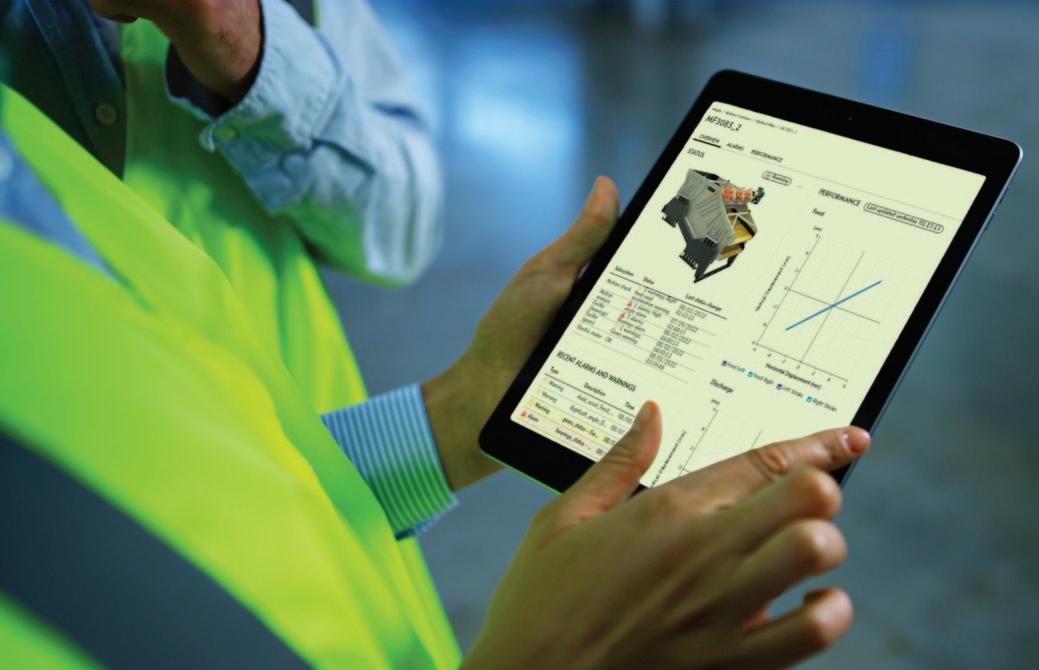
He noted that the company has custom-replaced well in excess of 100 of its competitors’ machines over the years. “We’ve had installations where the customer would be suffering significant breakdowns, downtime and loss of profit every couple of months, and we have been able to customize a screen for them [that] outperforms the replaced unit and has no breakdowns,” McKerr said.
“It’s really about offering them a piece of equipment that’s going to keep working in a tough environment. We’ve got an understanding of all the screening processes so we can apply our screens correctly. We know which ones are right for which duty and how to design them so that they perform continuously and reliably.”
Efficient screening in fewer units
When Derrick wanted to come up with the “ideal solution” for fine particle screening, efficiency was top of mind.
The company’s SuperStack wet screening machine features eight decks and can add upwards of three times the screening capacity of its previous five-deck StackSizer machine. “When we designed the machine, we had to maintain a really high screening efficiency,” explained Baojie Zhang, director of application engineering at Derrick. “With high efficiency and performance, we can increase the recovery and improve the circuit capacities to give the customer a good return on their investment.”
The eight decks operate in parallel, and the SuperStack’s Flo-Divider flow-distribution system equally distributes the material flow from the feed source to each deck into its own feed box. At the same time, two vibrating motors over the upper screen frame ensure that all eight decks vibrate, and an optional repulp spray system sprays water into wash troughs to help undersize material pass through screen openings.
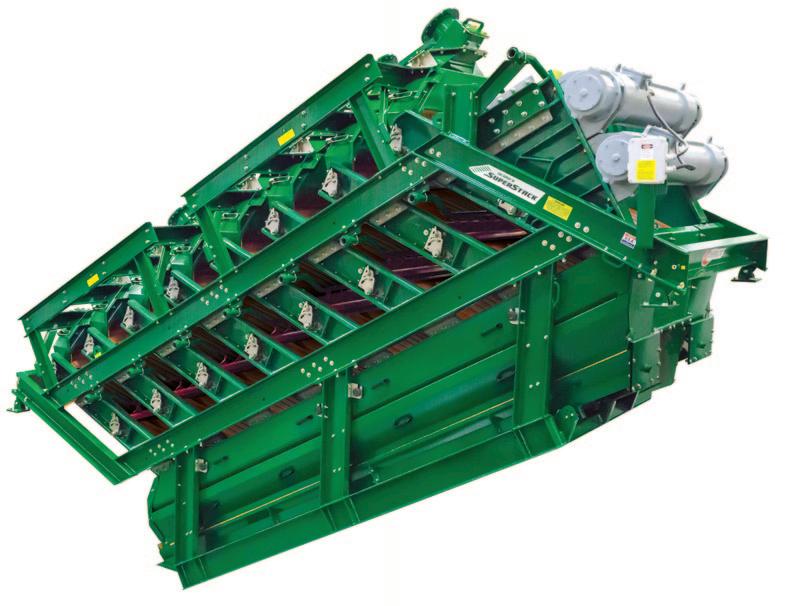
A significant component of the SuperStack is its front-to-back tensioning system. This allows the machine to tension the panel in the direction of the flow rather than side-to-side, which increases capacity and reduces the time required to change screen panels by 80 to 90 per cent when compared to side-to-side tensioning. Zhang noted that when the tension system moves parallel to the material flow, it ensures a more even distribution of the material across the entire screen surface. This helps reduce panel wear by avoiding concentrations of material in repeat areas.
According to Derrick, because the SuperStack can operate with a fewer number of units for a specific application, it can lead to lower capex and opex, meaning mining companies can improve on their capacity, recovery and grade.
Zhang said that this helps miners get a rapid return on investment within a few weeks to a few months. “Customers can also achieve a lower cost of ownership over the machine life: typically, our machines last for five to 10 years, if not 20 or 30 years. We have some customers who have been running our machine for 40 to 50 years.”
Derrick recently worked with Kropz, a phosphate miner in South Africa, at its Elandsfontein rock phosphate project northwest of Cape Town; in January 2021, Derrick delivered four SuperStacks to Kropz for its milling circuit. According to Zhang, the machines, which have been running since 2022, have increased the milling circuit’s throughput, simplified Kropz’s flowsheet by no longer requiring pumps and a hydrosizer, and helped it achieve a lower capex and opex.
“They were very ready to place the purchase order with one of our competitors for 12 machines,” Zhang said. “But we could do the whole application with only four machines, which reduced their total installation cost by more than 50 per cent and provided much better metallurgical performance. Without hesitation, the customer decided to go with our solution.”
Monitoring performance
Miners want to be sure that their equipment is up to par. That is why Metso designed its Metrics monitoring system, which monitors mining processes to optimize performance, support maintenance planning and reduce downtime.
Last year, the company launched its Metrics for screens monitoring system in partnership with Dynamox. Jan Wirth, a director of technology at Metso who heads the technology group for the company’s screening business line, said the product allows users to see what the screen is doing and how well it is doing it.
The system is easy to connect and sends sensor data in real time to the Metrics system, which analyzes performance and
monitors for potential issues. The system’s wireless sensors are strategically placed around the equipment to measure acceleration and temperature, explained Wirth, which then feeds the information into the cloud, where operators can review and make recommendations.
“Ultimately, the goal is to identify problems early, which then gives the operator time to react, to plan or prepare, and to increase the availability of the equipment,” Wirth said.
There are two major elements he highlighted as key benefits of the Metrics system: it allows the company to work closely with the customer to support its digitalization journey and any operational challenges along the way, and increase sustainability by optimizing performance and reducing downtime. “Our aim is to be the best sustainable choice for value-driven screening solutions,” he said. “That’s where Metrics is a key enabler for us.”
Since the system is always running, miners do not need to shut down operations to check equipment performance. “We can see things a lot earlier than in the past,” Wirth explained. “We had screens, for example, where some liners were lost. Typically, if the liner is lost, [the material] would wear into the screen structure, which can then lead to bigger problems. But [with Metrics], we identified it early before it caused any subsequent damage.”
Beyond helping miners be more organized around mine planning and catching issues before they escalate, Wirth believes the system helps miners to improve in availability, sustainability and safety. When it comes to monitoring, being able to detect potential issues and keep a pulse on performance is a boon for miners.
“Monitoring and remote monitoring is a must,” Wirth stated. “We can help customers monitor their entire plants. We’re not specifically focused on just our screens—it can be [from] other suppliers [or] other equipment.” CIM
Career building
CIM launches new cloud-based mentorship program
By Sara King-AbadiArenewed mentorship program from CIM is now available to CIM National members. The CIM Mentorship Program exists to connect newer generations of mining professionals with those more experienced in the industry to provide guidance at the beginning of their careers.
Initially launched in 2018, the program took a hiatus during the pandemic and was relaunched in August with a new platform behind it: MentorCity. This innovative platform allows for streamlined mentor-mentee pairing, a high margin of safety including background checks and a code of conduct, and greater success for participants.
“While we took steps to improve the mentorship experience for both mentees and mentors, an important part of the program update is the addition of MentorCity software,” said Christopher Marilley, director of membership engagement, partnerships and professional development at CIM. “This software will improve the accuracy of the matching process, facilitate meetings and produce reports that will help us provide a better experience for all users.”
All it takes for a mentor or mentee to become part of the program is to register online and complete a profile. Enrolment in the program is free and open to all CIM National members in good standing, including students and recent graduates, anywhere in the world.
“By completing that profile, it will help you align with a mentor who has similar interests,” Marilley explained. “The idea is you match skills and the platform allows them to create their own structure, but [at the same time] it’s a structured platform in that it reminds them they need to engage.”
For SNC-Lavalin senior process engineer and mentor Chris Koutsaris, having a mentor in the industry when he started out 15 years ago would have made all the difference. He explained that from jargon to workplace dynamics, the industry’s learning curve is steep. “When you start out, you don’t know anything,” he said. “Everybody has to figure this stuff out—it keeps you from quitting the industry.”
He believes that having a mentor can help to demystify nuances in the business and keep young talent in mining. “You can look at it like having an older sibling in the workplace,” Koutsaris said.
For Marilley, there are two ways of looking at the program, first as a mentor who is excited to give back to younger people entering the mining industry. “It’s really vital to help guide some of the youth into the work environment because, as we know, students who are coming out of third-year, fourth-year university, they don’t have that experience.”
Then, as a mentee, where having someone to point you in the right direction can have a real impact. “Having a mentor in the industry that you’re looking at, the year you develop your education, is such a great asset to build some confidence and knowing what the next steps are in your career path,” said Marilley.
That helping hand now extends across the globe thanks to the new virtual platform. Mentors and mentees are able to connect across continents, giving valuable insights into a global industry.
“A lot of youth come out of school and one of their passions is to see the world and the mining industry does allow for that,” said Marilley. “Somebody from Australia or South Africa could give you some great insight into what it’s like to work in a different country.”
A mentorship program is also a way to help keep students in mining by offering a window into the real-world possibilities when you enter the workforce, Marilley explained. “Enrolment is down in university programs… keeping these students on the [mining career] path is so important.”
The Mining Industry Human Resources Council’s National Outlook 2021 report found that enrolment in mining engineering undergraduate programs fell by roughly one-third from 2015 to 2019.
Marilley sees the online platform as a “great start” but expects to see the program grow beyond its current iteration. “I think phase two will be bringing [mentors and mentees] together in person and helping them grow their network,” he said. “That’s where we see this program growing.” CIM
Are you interested in becoming a mentor or mentee?
Scan to learn more.

Célébration de l’excellence de l’ICM

Notre industrie est composée de plusieurs personnes travaillantes, créatives et dévouées.
Célébrons-les tous ensemble.
Nominez dès maintenant!

Les nominés n’ont pas besoin d’être membre de l’ICM (à l’exception des candidats nominés pour les Prix de service distingué)
Date limite: Soume琀ez vos nominations avant le 30 novembre 2023

Les Prix de l’ICM constituent un programme appartenant à et opéré par l’Institut canadien des mines, de la métallurgie et du pétrole.
 Par Kelsey Rolfe
Par Kelsey Rolfe
Cela fait pratiquement une décennie que le CIM Magazine s’est plongé pour la dernière fois dans le thème de l’exploitation minière artisanale et à petite échelle (EMAPE). En 2013, la hausse du prix de l’or entraîné par la crise financière mondiale a attiré un grand nombre de personnes vers le secteur de l’EMAPE. S’il est tristement célèbre pour la précarité de ses pratiques en matière de santé et d’environnement ainsi que de ses normes de travail, ce secteur est pourtant une source importante de revenus pour les communautés et ce, depuis des générations. Il emploie bien plus de mineurs que le secteur minier industriel dans des régions où, souvent, les sociétés minières cherchent à établir ou à développer leurs activités.
Les conflits qui ont résulté entre les mineurs du secteur de l’EMAPE et les sociétés minières industrielles exploitant les mêmes gisements ont souvent fait la une des journaux et l’objet de poursuites. En revanche, le nombre inconnu de mineurs artisanaux qui ont perdu la vie dans des accidents et des effondrements de mines a souvent été passé sous silence.
À l’époque à laquelle nous avions exploré ce thème, peu de sociétés minières étaient prédisposées à aborder ce problème épineux avec nous. Barrick Gold, et c’est tout à son honneur, avait accepté de nous en parler. Le représentant de la société avait mis en avant certains des efforts mis en œuvre pour réduire les tensions à sa mine de North Mara, en Tanzanie. Il avait aussi reconnu qu’il était extrêmement complexe de trouver une solution réalisable permettant d’améliorer les pratiques en matière de sécurité et d’environnement tout en réconciliant les deux secteurs.
Dix ans plus tard, Barrick fait toujours face à ces difficultés et aux retombées juridiques de ce conflit non résolu avec les mineurs artisanaux en Tanzanie.
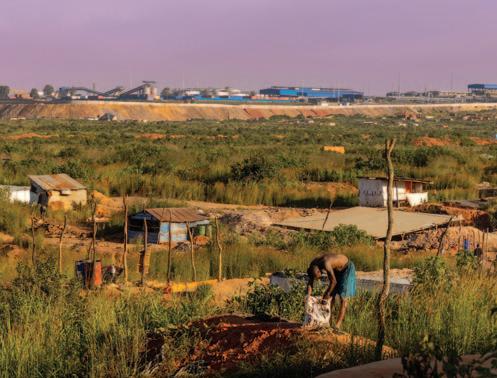
Dans l’article de fond de ce numéro, intitulé « À la croisée de deux industries » (p. 58), notre collaboratrice régulière Kelsey Rolfe nous offre un rapport de situation unique.
L’officialisation, un cadre dédié aux normes dans le secteur de l’EMAPE qui permettrait de commencer à aborder les risques inhérents à ce secteur, reste un objectif difficile à atteindre. La création d’un programme d’achat de diamants par De Beers constitue un progrès important. Son fonctionnement est instructif, tout comme l’engagement durable nécessaire pour qu’il fonctionne.
Par Alice MartinLe rôle du cobalt dans la transition énergétique, et la contribution majeure du secteur de l’EMAPE à la production globale de minéraux critiques, a relancé le débat sur l’officialisation. Les fabricants cherchent à démontrer leur engagement à l’égard des pratiques durables. Pourtant, en supprimant le cobalt produit par les mineurs du secteur de l’EMAPE, on risquerait d’être rapidement confrontés à une crise de l’approvisionnement.
Il serait opportun d’indiquer la provenance du cobalt lorsque ce dernier a été obtenu auprès de mineurs artisanaux, et ceci pourrait constituer une victoire importante.
Comme le détaille notre article, un tel aboutissement ne pourra se concrétiser qu’après un effort soutenu et de plusieurs années. Jusqu’à présent, peu ont eu la possibilité ou ont fait preuve de la persévérance nécessaire pour consacrer le temps et les efforts requis, et c’est bien là la difficulté.
Ryan Bergen, Rédacteur en chef editor@cim.orgUn engagement à l’égard de notre avenir commun
Les nouvelles d’événements climatiques qui nous arrivent du monde entier, notamment les récents incendies tragiques sur l’île de Maui, viennent nous rappeler que nous sommes toutes et tous des parties prenantes dans les effets du changement climatique. Entre la responsabilité face au changement climatique d’une part, et les besoins de nos diverses parties prenantes et des détenteurs de droits fonciers d’autre part, l’industrie minière se trouve confrontée à un parcours parsemé d’obstacles, mais les possibilités qui s’offrent à elle sont remarquables. L’année 2023 a imposé une réalité indéniable : la crise climatique n’est plus une préoccupation lointaine, mais un appel urgent à l’action. Les vagues de chaleur extrêmes et les feux de forêts qui ont dévasté le Canada d’est en ouest cette année viennent nous rappeler que les répercussions du changement climatique ne sont plus un scénario futur, mais une réalité bien présente.
Notre industrie ne peut s’isoler de ces bouleversements sismiques. En ma qualité de directeur des finances à B2Gold Corp., une grande société de production d’or fortement engagée envers l’exploitation minière responsable, je suis parfaitement conscient de la double difficulté que nous rencontrons. Nous devons drastiquement réduire nos émissions de gaz à effet de serre (GES) et atténuer nos incidences sur le climat, tout en contribuant simultanément à la prospérité de nos employés, de
nos collectivités locales, des gouvernements des pays d’accueil et de l’environnement dans lequel nous menons nos activités.
À B2Gold, comme dans de nombreuses autres sociétés minières, nous nous engageons à relever ce défi en fixant l’objectif de réduire nos émissions de GES de 30 % à l’horizon 2030. Toutefois, fixer des objectifs ne constitue que la première étape d’un parcours long et complexe. Compte tenu de sa nature, notre industrie consomme énormément d’énergie et opère souvent dans des lieux reculés du monde. La quête de sources d’énergie renouvelables, l’électrification de nos exploitations et les progrès en matière d’efficacité énergétique sont au cœur de la stratégie de notre industrie. Toutefois, nombre de technologies requièrent encore des améliorations importantes ou des conditions de marché adéquates avant que leur mise en œuvre ne devienne techniquement ou économiquement envisageable. La tâche qui nous attend est loin d’être aisée. Ainsi, les efforts de notre industrie pour transformer ses exploitations en des sites à faible émission de carbone requièrent de l’ambition, de l’innovation et de la détermination.
Pour atteindre nos objectifs en matière de réduction des émissions, nous ne nous contentons pas de tracer une voie vers un avenir plus durable. Nous honorons également notre engagement envers nos parties prenantes et nos communautés. L’industrie minière, légitimement, est une figure phare du progrès économique. Elle est source d’emplois, de revenus et d’investissements pour des pays et des régions du monde entier. Nous avons l’obligation de nous assurer que les moyens que nous employons pour réduire nos émissions sont sensibles aux besoins de nos employés, de nos communautés et de nos gouvernements. Nous reconnaissons le droit des nations d’exploiter leurs ressources à des fins de développement, et il est de notre devoir de faciliter ceci tout en maintenant nos obligations à l’égard du climat.
Si les défis que doit relever notre industrie sont redoutables, ils ne sont pas insurmontables. Le paysage dynamique de la transition climatique nous contraint à nous adapter continuellement et à chercher de nouveaux partenariats et de nouvelles voies et technologies. Si cette voie est incertaine, je suis convaincu que l’industrie saura faire (et fera) face à la crise climatique. Notre résilience fait notre force, et notre engagement à l’égard de l’innovation et de la responsabilité est inébranlable.
Alors que nous cherchons nos marques dans la transition climatique, nous ne nous contentons pas de protéger notre environnement. Nous contribuons aux moyens de subsistance de nos collectivités et à l’avenir des générations futures. Notre engagement à l’égard de la responsabilité face au changement climatique est, essentiellement, un engagement envers notre avenir commun. Un avenir qui privilégiera l’inclusion, la résilience et la durabilité.
Mike Cinnamond Président de l’ICM
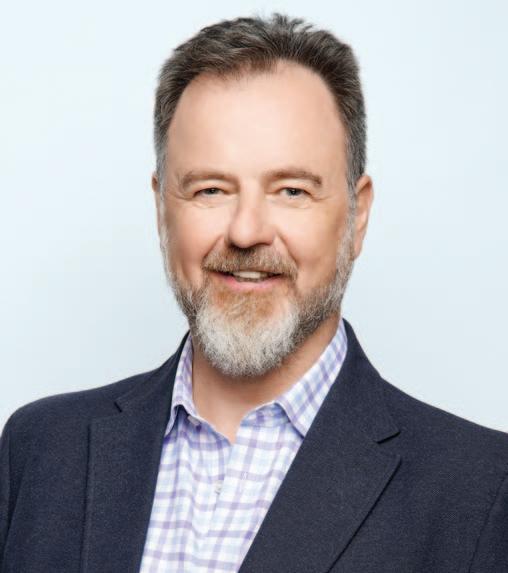
À la croisée de deux industries
L’officialisation de l’exploitation minière artisanale et à petite échelle : une étape nécessaire pour répondre à la demande mondiale en minéraux critiques
 Par Kelsey Rolfe
Par Kelsey Rolfe
La mine artisanale de cobalt et de cuivre de Kamilombe en RDC est située entre diverses exploitations minières industrielles. On peut voir en arrière-plan une mine de cuivre industrielle exploitée par La Sino-Congolaise des Mines (Sicomines).
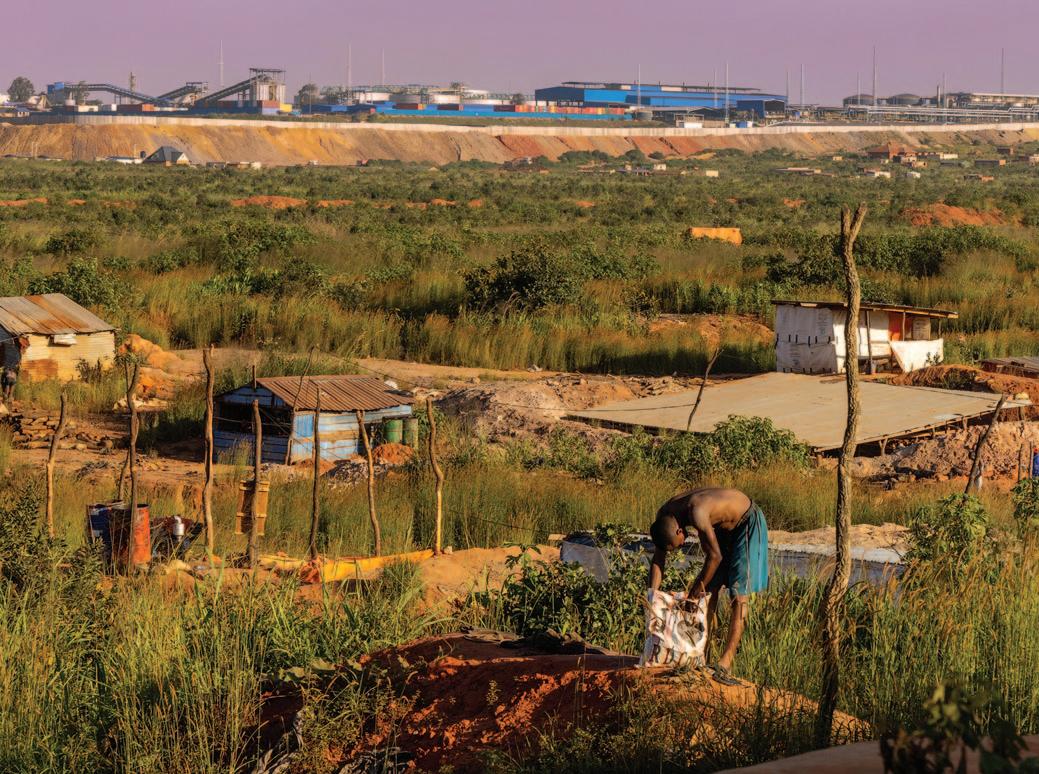
Jean Martineau n’a jamais vraiment adhéré à la manière dont les petites sociétés minières financent leur exploration. Pour lui, l’émission d’une série d’actions sur le marché public pour financer les travaux d’exploration ne contribuait qu’à atténuer la valeur de la participation de la direction dans la propriété au fil du temps. Ainsi, lorsque Dynacor Group, la société qu’il dirigeait depuis peu en tant que président et directeur général, a acheté une petite société privée au Pérou en 1996, M. Martineau y a vu une occasion pour son usine de traitement de l’or à moitié construite. Dynacor a terminé la construction de son concentrateur pouvant traiter 50 tonnes par jour (tpj) en 1998. Elle prévoyait d’extraire et de traiter du minerai du principal filon de sa concession minière, et de l’utiliser pour financer l’exploration continue sur le site.
La région abritait de nombreux mineurs artisanaux qui cherchaient à vendre leur minerai. Les personnes menant des activités minières artisanales le font de manière non officielle et travaillent majoritairement avec des outils rudimentaires ou non mécanisés. « Nous avons pensé que même si cela ne nous concernait pas, nous pourrions les aider tout en gagnant de l’argent. Nous ne nous sommes toutefois pas [attardé] sur le sujet », déclarait M. Martineau.
Cependant, le prix de l’or a atteint des sommets en 1998, passant d’environ 290 dollars l’once à 1 300 dollars l’once à la
fin 2010, et le nombre de mineurs artisanaux a augmenté en parallèle. Dynacor a développé un réseau progressivement plus vaste de producteurs constitués de mineurs artisanaux, et a continué à renforcer la capacité de production de son usine. Le traitement du minerai extrait de manière artisanale est rapidement devenu la principale activité de la société. En novembre 2022, Dynacor a terminé l’expansion de son concentrateur, qui affiche désormais une capacité de traitement de 500 tpj. La société collabore aujourd’hui avec environ 1 000 coopératives d’extraction minière artisanale, qui comptent entre 5 000 et 6 000 mineurs.
Toutefois, son modèle opérationnel a rencontré plusieurs difficultés, indiquait M. Martineau. Dynacor a dû établir des normes pour les types de minerai que la société peut accepter afin de garantir la régularité du taux de récupération. Elle a créé des sièges dans l’ouest du Pérou, où 50 employés créent des liens avec les mineurs et analysent les propriétés métallurgiques de leur minerai. Elle a dû adapter le cadre juridique du pays à ces changements concernant les mineurs artisanaux, et travaille désormais exclusivement avec ceux qui sont officialisés ou en instance d’officialisation. Elle leur propose également une formation en matière de santé et de sécurité, une aide de la part de géologues et une aide pour toutes les formalités administratives du gouvernement.
Dynacor fait partie du petit nombre (qui ne cesse de croître) de sociétés minières collaborant directement avec des mineurs qui travaillent dans le secteur de l’exploitation minière artisanale et à petite échelle (EMAPE). Le secteur de l’EMAPE, qui emploie environ 45 millions de personnes à l’échelle mondiale et en soutient économiquement des millions, inclut des activités allant de petits groupes de mineurs, qui creusent souvent dans des concessions détenues par des sociétés minières, à des coopératives officielles qui emploient des mineurs, mais dont les équipements ne sont généralement pas aussi sophistiqués que ceux des grandes sociétés minières. À l’échelle mondiale, on compte environ 20 millions de personnes travaillant à l’extraction artisanale de l’or. Le reste se répartit entre l’extraction de pierres précieuses, de diamants et de minéraux critiques tels que le cobalt, le cuivre et le tantale.
Le secteur de l’EMAPE a depuis longtemps mauvaise réputation en raison des conditions de travail dangereuses, des pratiques environnementales précaires et des cas de travail des enfants ou de travail forcé. Pour toutes ces raisons, les sociétés minières et leurs acheteurs en aval ont généralement préféré ne pas traiter avec les mineurs du secteur de l’EMAPE afin d’éviter les risques juridiques et d’entacher leur réputation. Toutefois, les experts indiquent que les modèles de coexistence sont essentiels pour aider à officialiser ce secteur et à répondre à certains des problèmes les plus profondément ancrés, tout comme l’est le plaidoyer de la part des acheteurs de minéraux critiques.
Un changement de mentalité au sein des sociétés minières s’opère « doucement mais sûrement », indiquait Marcello Veiga, professeur émérite au Norman B. Keevil Institute of Mining Engineering (l’institut Norman B. Keevil de génie minier) de l’université de la Colombie-Britannique (UBC). M. Veiga, qui travaille avec diverses sociétés minières sur la manière de mobiliser les mineurs artisanaux, était le coauteur d’une étude de 2022 pour la revue The Extractive Industries and Society sur les différentes approches à la coexistence entre les sociétés d’extraction aurifère et les mineurs artisanaux en Amérique latine. Elle concerne tout autant les sociétés permettant aux mineurs de travailler sur leurs concessions avec un minimum, voire pas du tout d’implication, que les entités qui offrent une aide et un soutien techniques, et les sociétés telles que Dynacor, qui achètent et traitent
le minerai issu de l’EMAPE. L’étude mettait en lumière les arrangements avec les mineurs artisanaux dans des sites tels que la mine de Fruta del Norte de Lundin Gold, en Équateur, et le projet de Gramalote d’AngloGold Ashanti et B2Gold, en Colombie.
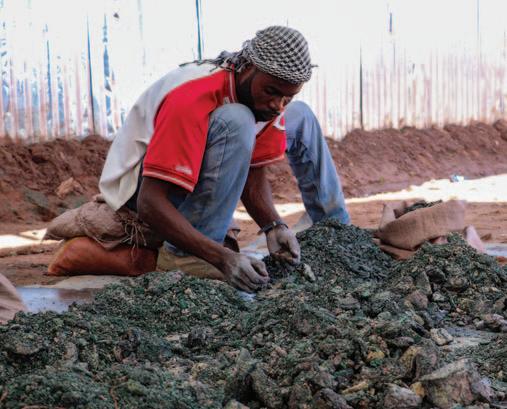
La demande vorace en minéraux critiques peut obliger davantage de sociétés minières à contribuer à l’officialisation du secteur, indiquait Rob Karpati, conseiller supérieur de Blended Capital Group, une société de conseils en entreprise et en investissement. « Au final, c’est une approche où tout le monde a soit à y gagner, soit à y perdre. D’un côté, le manque de participation [avec le secteur de l’EMAPE] mène au conflit et à la destruction de valeur. De l’autre, une participation sérieuse mène à une collaboration et une valeur mutuelle qui s’étend à la communauté et à la chaîne de valeur, tout en renforçant la productivité », indiquait-il.
« L’EMAPE est un secteur légitime qui existe depuis plusieurs siècles sous diverses formes. [En] lui conférant une stabilité, en le formant et en l’incitant à adopter des pratiques exemplaires, ce secteur devient équitable et la productivité ne s’en porte que mieux. En d’autres termes, on peut [davantage] contribuer à la transition énergétique si l’on dispose de plus de cobalt et de cuivre. »
Différentes approches
Jusqu’à présent, l’engagement auprès du secteur de l’EMAPE émanait principalement d’organisations non gouvernementales (ONG) et d’organismes intergouvernementaux comme le Programme des Nations Unies pour l’environnement (PNUE). La plupart ont pour objectif de dispenser une formation en matière de santé et de sécurité et d’aborder les questions environnementales.
Si ces projets sont bien intentionnés, ils restent « superficiels », déclarait M. Veiga. Prenons par exemple des programmes visant à éradiquer l’utilisation du mercure dans le traitement de l’or extrait de manière artisanale. D’après le PNUE, l’extraction minière artisanale et à petite échelle d’or est responsable de 37 % de la pollution mondiale au mercure. Toutefois, les programmes visant à enseigner aux mineurs artisanaux les dangers pour la santé et l’environnement du mercure ne tiennent pas compte des réalités financières des individus ou des exploitations plus petites. « Il est bien sûr important de le leur enseigner, mais sans argent, ils en feront peu de cas », ajoutait M. Veiga.
En outre, de nombreux mineurs travaillant dans l’extraction minière artisanale et à petite échelle d’or ne traitent pas l’or euxmêmes. Au contraire, ils envoient leur minerai à des intermédiaires disposant de centres de traitement, que M. Veiga qualifie « d’escrocs ». Une fois que les mineurs livrent leur minerai, les centres de traitement récupèrent un faible pourcentage d’or (généralement 30 %, voire moins), et payent les mineurs des sommes dérisoires. Les centres conservent les résidus, et extraient eux-mêmes le reste de l’or à l’aide de cyanure. « Lorsqu’on prétend qu’il faut trouver des solutions de remplacement au mercure, [je suis tenté de dire] qu’il faut arrêter les escrocs », indiquait-il. « La seule solution est que les sociétés travaillent main dans la main avec les mineurs artisanaux. »
Ruby Stocklin-Weinberg, directrice du programme GemFair du groupe De Beers, indiquait que les programmes menés par des ONG ne durent généralement pas suffisamment longtemps pour introduire des changements durables. La recherche qu’elle menait dans le cadre de son doctorat à l’UBC portait sur le développement de programmes de formation ayant une incidence
positive pour les mineurs artisanaux. « La plupart des projets que j’ai étudiés duraient [entre] 3 et 5 ans. Ce n’est pas suffisant », déplorait-elle.
GemFair, qui a commencé en 2018 en tant que programme pilote, achète des diamants aux mineurs artisanaux en Sierra Leone et les revend sur le marché international. Une équipe d’employés de De Beers dans le district de Kono évalue les activités du secteur de l’EMAPE afin de garantir que leurs pratiques en matière de travail, de santé et de sécurité et d’environnement répondent aux normes minimales requises par la société pour une participation au programme. La société propose aussi une formation en classe et pratique avec des mineurs afin qu’ils améliorent leurs pratiques, et elle a obtenu un équipement de sécurité qui leur est destiné.
D’après Mme Stocklin-Weinberg, l’évolution du programme démontre la valeur de la collaboration avec des mineurs artisanaux sur une période plus longue. Depuis l’étape pilote initiale (qui s’est transformée en programme complet en 2021), l’équipe de GemFair a trouvé des manières plus efficaces pour inciter les mineurs à rejoindre le programme et pour les former, ce qui a permis d’ajouter environ 50 sites d’EMAPE par an. La société, ajoutait-elle, réexamine son approche envers la surveillance des sites miniers, mais n’a trouvé aucune preuve de travail des enfants ou de travail forcé, de financement de conflit ou de violation des droits de l’homme dans les exploitations avec lesquelles elle collabore. De Beers prévoit de faire évoluer ses normes pour permettre aux mineurs de rejoindre le programme plus tôt afin de répondre dès que possible aux exigences. Le groupe envisage de proposer une formation thématique, notamment sur des sujets tels que l’assainissement des sites.
« Nous avons encore tellement à apprendre, même après cinq années », déclarait-elle. « La plupart des projets seraient normalement terminés. »
L’Artisanal Gold Council (AGC, le conseil de l’extraction aurifère artisanale) de Victoria, en Colombie-Britannique, cherche à offrir une formation aux mineurs du secteur de l’EMAPE et à développer des chaînes d’approvisionnement responsables. Quatre programmes sont en cours en Mongolie, aux Philippines, au Burkina Faso et en Guyane. Son programme au Burkina Faso, qui a commencé en 2019 et devrait prendre fin en 2025, forme 150 mineurs aux technologies de traitement de l’or sans mercure,
et les aide à s’organiser en coopératives, à demander des permis d’exploiter et à obtenir le financement de leurs activités.
Saidou Kabre, directeur de projet régional de l’AGC pour le Burkina Faso, indiquait qu’avec l’aide de l’AGC, la procédure d’officialisation prenait environ un mois. « La complexité est que la plupart des mineurs sont analphabètes, et ne sont pas en possession des documents requis », indiquait-il. Pour préparer la fin du soutien offert par le programme, il expliquait que l’AGC encourage la création de liens entre les agences gouvernementales concernées, les coopératives existantes et d’autres parties prenantes importantes, notamment des institutions financières.
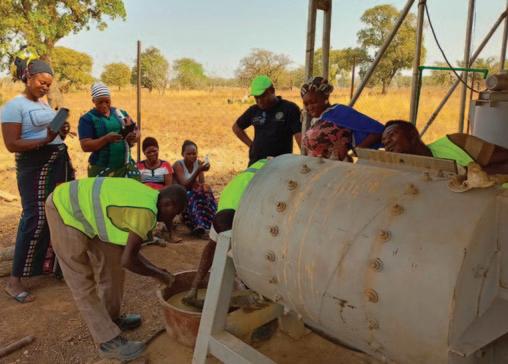
M. Kabre reconnaissait que les technologies de traitement de l’or sans mercure auxquelles étaient formés les mineurs sont coûteuses et uniquement utilisées sur l’un des sites pilotes dans le pays à l’heure actuelle. L’intensification des activités afin de servir les intérêts des quelque 800 sites d’extraction minière artisanale du Burkina Faso exigerait un plus grand soutien des donateurs et d’autres collaborateurs, expliquait-il. L’une des solutions envisagées par AGC est de développer une capacité de fabrication avec des professionnels locaux afin que l’équipement soit construit dans la région plutôt qu’importé.
Explorer le paysage juridique
Inciter les sociétés minières à approfondir les relations coexistantes avec les mineurs artisanaux est plus facile à dire qu’à faire. L’un des principaux obstacles porte sur le paysage juridique de nombreux pays entourant le secteur de l’EMAPE.
« Peu de pays producteurs accordent une catégorie propre dans le code minier à l’extraction minière artisanale », indiquait Mme Stocklin-Weinberg. Les réglementations claires de la Sierra Leone concernant le secteur de l’EMAPE constituaient une « très grande motivation » pour De Beers pour commencer à travailler là-bas.
Dynacor envisage de construire des concentrateurs d’or dans deux autres pays, indiquait M. Martineau. Lorsque des représentants des pays d’Amérique latine et d’Afrique l’ont contacté, la première chose qu’il a demandée était de savoir comment et si les mineurs artisanaux existaient aux yeux du droit minier du pays. « Si mon concentrateur est légal, comment pourrais-je acheter du minerai auprès de mineurs travaillant dans l’illégalité ? », expliquait-il. Au Sénégal, l’un des pays où Dynacor envisage d’implanter ses activités, le gouvernement a réservé une zone spéciale où les mineurs artisanaux peuvent exercer leurs activités en toute légalité à partir du moment où ils sont inscrits au ministère des mines et de la géologie.
Même les pays disposant de procédures d’officialisation avaient tendance à être trop axés sur la bureaucratie et à contenir de trop nombreuses épreuves à franchir pour les mineurs, indiquait M. Veiga. Ceci peut s’avérer particulièrement difficile pour les mineurs ayant de faibles niveaux d’alphabétisation et pour ceux vivant loin des bureaux du gouvernement.
L’approche envers l’officialisation du secteur de l’EMAPE adoptée au Pérou a requis plusieurs révisions pour répondre aux réalités des mineurs artisanaux. Une version précédente de la législation exigeait que les activités de ce secteur soient soumises au même type d’évaluation environnementale qu’une grande société minière, procédure qui a depuis été simplifiée. À ce jour, le pays compte environ 9 600 sites d’EMAPE officialisés. D’après M. Martineau, la procédure s’améliore. Toutefois, Dynacor doit souvent accompagner ses fournisseurs pour qu’ils la comprennent.
Pour se conformer à la loi, la société dispose d’un processus de vérification rigoureux reposant sur 27 points. Lorsqu’elle envisage d’embaucher un nouveau mineur, elle vérifiera le lieu où il mène ses activités, s’assurera qu’il possède un droit légal ou qu’il est en droit de travailler sur la concession, et vérifiera à quelle étape de la procédure d’officialisation il se trouve. Dynacor envoie également un géologue sur la propriété pour confirmer que le minerai vient effectivement de là-bas, et pour déterminer si des enfants travaillent sur le site.
Officialiser les mineurs de la RDC
La République démocratique du Congo (RDC) s’est retrouvée au cœur des discussions sur l’officialisation du secteur de l’EMAPE. D’après Ressources naturelles Canada (RNCan), en 2021, la RDC abritait 46 % des gisements connus de cobalt dans le monde, et était responsable de 73 % de la production de cobalt au niveau mondial. Le cobalt produit par le secteur de l’EMAPE représente de 15 % à 30 % de la production annuelle de cobalt, et 10 % de la production mondiale de cobalt.
En 2018, le pays a établi un cadre visant à officialiser les activités du secteur de l’EMAPE et à envoyer les mineurs artisanaux vers des exploitations à petite échelle. Ceci obligeait les mineurs à s’enregistrer, à recevoir des permis et à mener leurs activités dans une zone désignée légalement. Toutefois, d’après AnneMarie Fleury, directrice de l’approvisionnement responsable à Glencore, « peu d’exploitations artisanales et à petite échelle répondent à ces spécifications à l’heure actuelle ».
Un projet pilote d’officialisation du secteur de l’EMAPE de courte durée mettait en avant les améliorations aux niveaux des activités et des moyens de subsistance pour les mineurs travaillant dans des exploitations artisanales et à petite échelle légales. Le projet, lancé par Chemaf Resources et Trafigura Group en 2018 avec le soutien des autorités congolaises, a permis à une coopérative de mineurs artisanaux de travailler dans des petites mines à ciel ouvert sur la concession de Mutoshi de Chemaf. Les sociétés ont offert aux mineurs une assistance technique, une formation, un équipement de sécurité et des informations géologiques. Le projet a également réuni des femmes dans la main-d’œuvre. Dorothée Baumann-Pauly, directrice du Geneva Center for Business and Human Rights (GCBHR, le centre de ressources sur les entreprises et les droits de l’homme de Genève) de la Geneva School for Economics and Management (l’école d’économie et de gestion de Genève), indiquait dans une étude de février 2023 que cette démarche avait entraîné une hausse des revenus familiaux et avait permis aux enfants d’être scolarisés, réduisant par là même le travail des enfants.
Toutefois, la suspension du projet en mars 2020 en raison de la pandémie de Covid-19 a anéanti les effets de ces changements. Lors d’une visite sur le site en décembre 2022, Mme Baumann-Pauly a appris que les normes d’officialisation n’étaient plus observées. Les mineurs ne portaient plus d’équipement de protection individuelle (ÉPI), les mines à ciel ouvert avaient été remplacées par « environ 150 puits instables et mal ventilés qui menaient à des tunnels verticaux profonds et horizontaux longs ». En outre, plus de 15 000 mineurs, dont des enfants, travaillaient sur le site, soit une forte hausse par rapport aux 5 000 adultes qui y travaillaient durant le projet pilote d’officialisation.
Dans un courriel à l’équipe du CIM Magazine, Victoria Dix, responsable des relations avec les médias de Trafigura, indiquait que la société avait choisi de ne pas relancer l’exploitation
Un groupe de mineurs artisanaux (qu’on appelle creuseurs en RDC) se servent d’une corde pour descendre le long de l’un des tunnels parmi les centaines qui existent à la mine de Kamilombe au début de leur journée de travail.
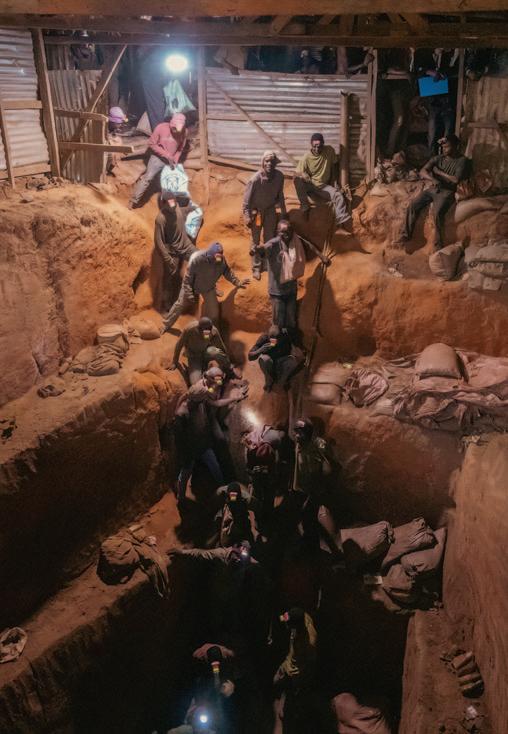
en raison des changements dans la loi congolaise de mars 2021 visant l’établissement de l’Entreprise Générale du Cobalt (EGC), une agence chargée de surveiller l’extraction minière artisanale et l’achat de cobalt issu de l’EMAPE au niveau national avant l’étape de traitement. Le lancement de l’EGC a été entravé par des controverses au niveau de l’administration interne.
Ces types de conditions opérationnelles sont la raison pour laquelle de nombreuses grandes sociétés d’électronique et automobiles ont tenté d’exclure, dans leurs contrats, le cobalt provenant du secteur de l’EMAPE dans la fabrication de leurs produits.
Toutefois, l’étude de Mme Baumann-Pauly appelait les utilisateurs finaux de cobalt à collaborer avec les sociétés minières afin de les encourager à une officialisation correcte de ce secteur en RDC. « Sans le cobalt issu du secteur de l’EMAPE, les acheteurs ne seront pas en mesure de faire face à la demande mondiale, qui devrait quadrupler d’ici 2030 », indiquait-elle dans un communiqué de presse.
Michael Posner, directeur du Center for Business and Human Rights (le centre de ressources sur les entreprises et les droits de l’homme) de l’école de commerce Stern de l’université de New York, déclarait que les sociétés d’extraction du cobalt et les acheteurs auraient tout intérêt à collaborer afin d’établir des normes quant à la manière de mobiliser les mineurs artisanaux. « L’effort doit être collectif », déclarait-il.
Mme Fleury était du même avis, ajoutant que Glencore avait développé son approche envers les exploitations artisanales et à petite échelle ces dernières années. « Nous sommes conscients de l’importance des producteurs du secteur de l’EMAPE dans la chaîne d’approvisionnement du cobalt et dans les communautés de la RDC. Les sociétés industrielles comme la nôtre ont un rôle à jouer, mais nous avons besoin de partenariats pour faire face aux problèmes. »
Glencore ne prévoit pas d’acheter ou de traiter le minerai de mineurs artisanaux. D’après Mme Fleury, c’est parce que ses deux sites de RDC sont de grandes exploitations intégrées qui extraient l’intégralité de leur cobalt à des fins de traitement et d’export sans avoir besoin d’acheter auprès de tiers.
L’approche de Glencore vis-à-vis du renforcement du partenariat l’a incité à rejoindre l’Alliance du Cobalt Équitable en 2020 afin d’aborder « le tableau général de la situation et les causes profondes » de l’existence du secteur de l’EMAPE dans le pays. L’organisation, qui compte également parmi ses membres les entreprises Tesla, Google et d’autres organisations de la société civile et des droits de l’homme, s’efforce d’aider les coopératives du secteur de l’EMAPE à officialiser leurs activités, d’aborder le problème du travail des enfants dans ce secteur et de créer d’autres débouchés économiques dans les communautés. « Nous sommes conscients que seuls, nous ne pouvons atteindre notre objectif », déclarait Mme Fleury. « Nous sommes un acteur industriel et commercial, et les problèmes associés à l’extraction minière artisanale ne peuvent être résolus par un seul acteur, ni par l’industrie minière à grande échelle ou la chaîne d’approvisionnement du cobalt de manière indépendante. »
Instaurer la confiance
Lorsque la législation d’un pays entre en jeu, les modèles de coexistence fonctionnent bien si des conditions spécifiques existent, indiquait M. Veiga. L’un des éléments essentiels est un engagement à instaurer la confiance avec les mineurs.
D’après M. Martineau, Dynacor a réussi à instaurer la confiance en faisant preuve d’une totale transparence sur sa tarification et son analyse du minerai. Lorsque les mineurs artisanaux amènent du minerai à l’usine de Dynacor, ils assistent à la pesée et au broyage. Quelque 60 kilogrammes de minerai sont envoyés dans un broyeur à boulets à sec, et quatre échantillons sont préparés à partir de 10 kilogrammes de matériel broyé.
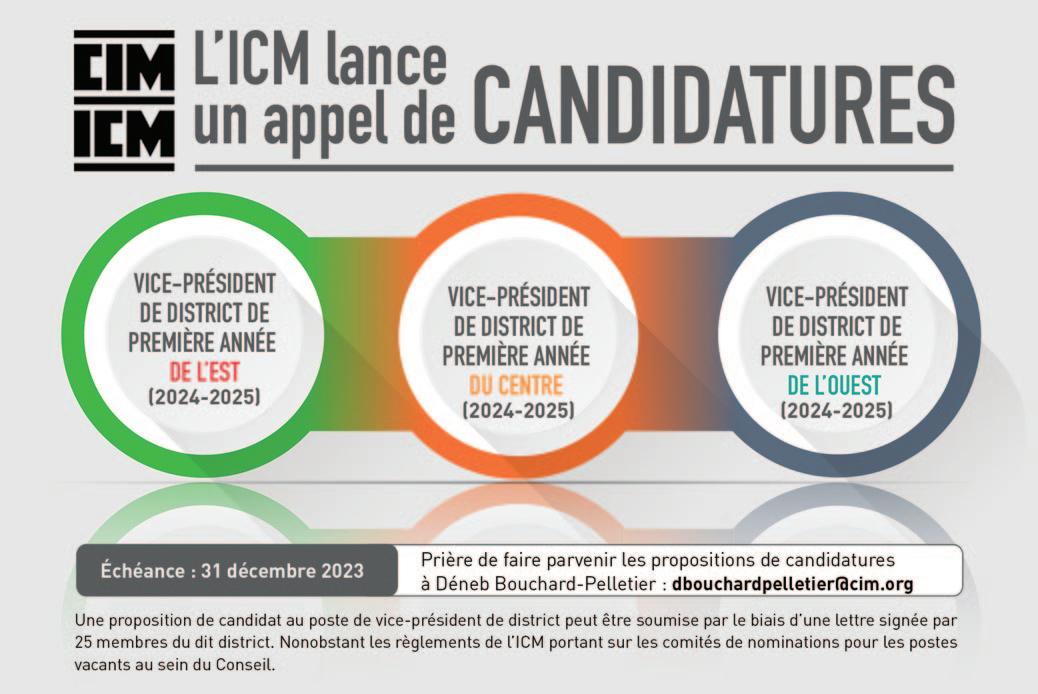
Le premier échantillon est remis au mineur, le second est analysé immédiatement, et les deux autres sont mis de côté. Le laboratoire de Dynacor renvoie ses résultats dans les 24 heures. Si le mineur est satisfait de la valeur évaluée du minerai, il est réglé d’avance. La société paye 70 % à 80 % de la valeur de l’or dans le minerai qu’il vend. Si la teneur du minerai paraît exceptionnellement élevée, un troisième échantillon est analysé pour le confirmer. Si le mineur n’a pas confiance dans l’analyse effectuée par la société, il peut amener son propre échantillon dans un autre laboratoire. Si une différence est constatée entre les deux échantillons, le quatrième est envoyé à un laboratoire international à Lima.
« Les mineurs assistent à l’intégralité de la préparation. Le processus est très transparent, ce qu’ils apprécient », ajoute-t-il. « Ce sont des êtres humains. Nous nous devons de les traiter avec respect. » ICM
Québec investit pour valoriser les résidus miniers amiantés
Par Alice MartinLe gouvernement du Québec a alloué 3 millions de dollars sur une période de cinq ans à l’Université de Sherbrooke pour la création d’une chaire de recherche qui étudiera la récupération de minéraux critiques et stratégiques des résidus miniers amiantés.
Le financement du gouvernement provincial servira à établir et soutenir la Chaire de recherche sur la valorisation des résidus miniers amiantés, qui a commencé son travail en juin. La chaire de recherche vise à accroître les connaissances sur la concentration et la première transformation des minéraux critiques et stratégiques contenus dans les résidus miniers amiantés ainsi qu’à développer des processus pour les extraire.
Les résidus miniers amiantés sont principalement riches en magnésium et contiennent aussi du nickel. Ces deux minéraux critiques sont nécessaires à la transition énergétique pour leur usage dans des panneaux solaires et des batteries de voitures électriques.
Selon Gervais Soucy, directeur du département de génie chimique et de génie biotechnologique à l’Université de Sherbrooke, ainsi que le co-titulaire de la chaire de recherche, le financement aidera les chercheurs à entreprendre une variété de projets.
« Nous pourrons former des personnes hautement qualifiées, comme des étudiants à la maîtrise et au doctorat et des techniciens, pour supporter l’industrie, » indiquait M. Soucy. « Nous allons aussi faire le bilan de la littérature des 50 dernières
années [sur la valorisation de ces résidus] et le rendre disponible au public et aux entreprises. »
Avec la revue de littérature scientifique, M. Soucy expliquait qu’il sera possible de déterminer quelles technologies sont les plus efficaces et prometteuses pour valoriser les résidus miniers amiantés.
« On veut éviter de réinventer la roue, donc on va voir quelle recherche a été faite, et comment on peut l’améliorer, » indiquait-il. « Il y a des technologies qui ont été utilisées il y a une dizaine d’années qui étaient basées sur les combustibles, peutêtre qu’on peut remplacer la source d’énergie combustible par une autre source plus durable. »
L’annonce a été faite à Val-des-Sources (anciennement Asbestos, renommée après un référendum en 2020), où se situent plusieurs mines d’amiante dont l’exploitation est terminée. Néanmoins, environ 800 millions de tonnes de résidus miniers amiantés sont encore entreposées sur des sites dans les régions de l’Estrie et de Chaudière-Appalaches, selon le gouvernement provincial. L’Université est stratégiquement positionnée pour la recherche, étant située à 56 kilomètres de Val-des-Sources.
Pour éviter de transporter les résidus miniers amiantés, les projets de recherche de plus grande envergure seront entrepris directement à Val-des-Sources, tandis que les plus petits se tiendront à l’Université directement. ICM
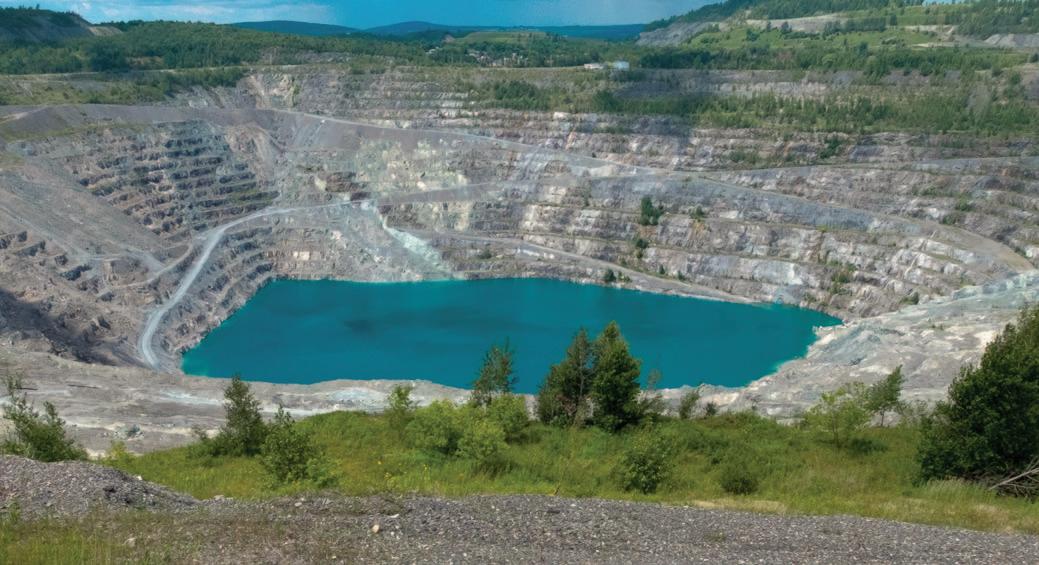
AERIAL EXPLORATION
Northern Aerial Minerals Exploration (N.A.M.E.) was formed in 1928 with the backing of financier John E. Hammell, who became the company’s president.
The Canadian Mining Hall of Fame, which inducted Hammell in 1991, stated that “N.A.M.E. was the genesis of exploration in the North that resulted in some of Canadian mining’s greatest accomplishments through the exploits of the bush pilots who came to be identified with mineral exploration in Canada.”
This is an excerpt from the paper “Aerial Exploration,” by the staff of N.A.M.E., with an introduction by Hammell, which was presented at the CIM Annual General Meeting in Winnipeg, Manitoba, in March 1929.
One hundred thousand miles of flying over the North country without a single air casualty; much of it over virgin territory; some of it over regions that abound with possibilities for minerals; all of it effective, for exploration and the establishment of bases and supply-stations, and for the carrying of men and their tools and provisions— this, briefly, is the record of Northern Aerial Minerals Exploration, Limited, a Canadian company organized less than nine months ago, which has been functioning, without interruption, during spring, summer, and now into winter.
Our ’planes have ranged from the Alaskan boundary on the west to the Labrador coast on the east, and from the Transcontinental railway north to the Arctic circle. Our prospectors, carried on trips of hundreds, and occasionally thousands, of miles, have gone over large sections of country which were never before explored, and at the end of the prospecting season the Company finds itself in possession of several groups of important gold claims, which look most promising. In addition to this, we have been in contact with deposits of almost every known mineral.
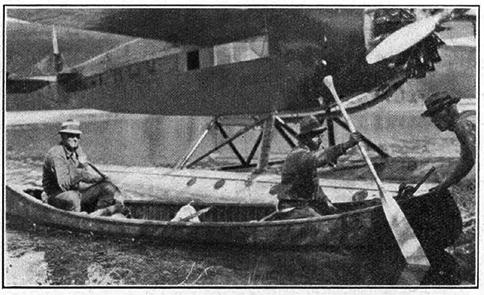
We have, for instance, staked five miles of claims on Belcher island, in Hudson bay. This, added to the very large area the Company had previously secured, gives us one of the greatest iron deposits on the North American continent, or in the world. While there are problems to overcome, and we are not getting excited over the prospects, Belcher island in the future may be the means of building large metal centres on the shores of Hudson bay. One can visualize the possibility of Canada dominating the iron and steel trade of the world by reason of such vast iron storehouses.
I wish to draw attention to the fact that, while the aviation feature is the spectacular side of the Company, N.A.M.E. is
not a flying company. It is definitely and supremely a mining exploration company, and uses, as necessity demands, every form of transport, from canoes and dog teams to tractors and railways. The airplane is an arm of the service, and the most important one, becoming increasingly important as the organization becomes more highly developed. There can be no doubt that the future of mineral exploration will depend on aircraft. When the Company was launched, I said that more development would result from the use of airplanes by experienced men in the next five years than had been accomplished in the last fifty years. This has been demonstrated in a few months’ operations. Below are enumerated a few of the advantages gained by the use of the airplane:
1. Safety. Since 1926, when the first serious air transport started in Patricia district, there have been no casualties among air passengers, whereas (about) 42 men have lost their lives by the old methods.
2. Communication and Supervision—the key to effective prospecting. Our parties are at all times in touch with district engineers and headquarters, and receive help and advice on the ground when they need it.
3. Morale. Increased out of all proportion. Men are in touch with civilization and have had the worry and labour of transportation of supplies removed. They can apply themselves 100 per cent to the work (prospecting) within a convenient radius of their main camp. For their purposes, this main camp is the equivalent of Timmins or Cochrane or any other town on the steel. When they are through with that particular locality, they, their canoes, and their supplies are transported to another area in a fraction of a day, and work resumes
4. Aerial Observation. Geological boundaries can be outlined roughly by an engineer or experienced prospector, and topographical features of the country can be supplied to the field parties in remarkably quick time.
Bear in mind that transportation is probably the biggest problem the prospector has to face, and when the airplane eliminates this for him, you can use your imagination to picture the field before our prospectors.
I do not mean that it will ever be possible actually to explore for minerals by airplane. It is possible from the air to
pick out formations in the barren lands, which are not timbered or overburdened, but for actual exploration the prospector must be set down on the ground. He can be carried in a few hours into districts that ordinarily could only be reached after weeks of travel. He can be kept in touch with his Company and the outside world, and he can be supplied with food, explosives, and tools.
I wish to point out here that airplane exploration, instead of adding to the dangers of a pioneer country, actually renders the work much less hazardous. During all of our flying last year, there was not a single crash, and we were constantly in touch with all the men working from our air bases. There is practically no danger of a man being lost in the bush or starving when he is in our service, and little danger to the pilots, as ’planes are always sent out in pairs. The different bases know each day where every ’plane is operating and where every man may be picked up.
We have now three large camps in the North which are stocked with two years’ provisions, and we have 26 bases where gasoline and oil are cached. With a flying range of 1,000 miles, this means we can be in almost daily contact with every mineral section of Canada. For special missions, we have engineers and large ’planes in readiness.
We are operating in a country which has tremendous rewards for those who are highly organized, know the game, and are bold enough to strike deeply into the new areas. Northern Canada is such a rich mineral country that it may pay back enormous outlays through a single discovery.
Early Developments
The idea of using aircraft in the Canadian North is an old one. Ask any old prospector who has spent many a weary day over the portages. He will tell you how, years ago, he dreamed of things as they are today. His dreams, naturally, were very vague. Back in 1915, when we discovered Flin Flon, I told the boys I would some day provide them with airplanes, at which they laughed.
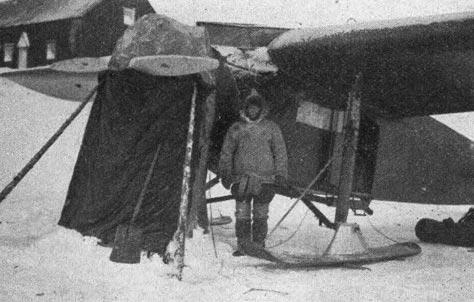
The first uses to which aircraft were put in Northern Canada were naturally the most obvious: observation, with aerial sketching and photography following. These uses of aircraft were closely associated with the timber and pulp industries of the North, and the flying was done largely by Dominion and Provincial government aircraft, the Laurentide Air Service being a notable exception. Aerial transportation came along at the end of the parade and—a point worth noting—was from the start closely associated with, and sponsored by, the mining industry. This opened a new era in northern flying. The mining industry demanded, and got,
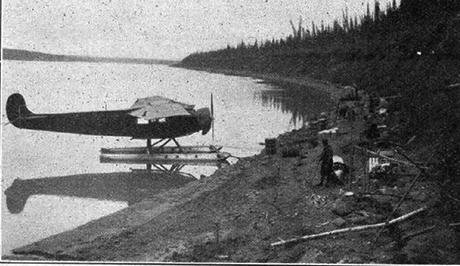
(1) Transportation throughout the winter season as well as in summer.
(2) Cheaper and more efficient transportation of men and goods by air.
This was effected by the introduction of the most modern types of ’plane, which widened the horizon for exploration and development beyond all expectations; and this led to increased demands, and to the organization, first, of airtransport companies, and, finally, of exploration companies operating their own aircraft.
Safety
A preliminary estimate from the Department of Civil Aviation places the amount of flying in mining-transportation and exploration in Canada at 630,000 miles for 1928. So far as is known, there were no casualties to prospectors nor loss of supplies.
N.A.M.E. ’planes covered 100,500 miles on miningtransportation and exploration, with no loss of men or supplies. One N.A.M.E. ’plane sank at Churchill harbour, due largely to lack of mooring facilities; but it was salvaged, and the loss represents about 30 per cent of the cost of the ’plane and is covered in the reserve for contingencies and included in the estimate of flying cost.
In the first year’s operation of any company, naturally the maximum of efficiency is not attained. The above story is one of an organization brought into existence and spread from Ungava to the Yukon almost overnight. With this experience behind, and a year to consolidate and gather up the loose ends, the economy and effectiveness of N.A.M.E. prospecting methods should be so obvious to exploration companies that it will become standard. CIM

Electrifying your mine also —
ABB Ability™ eMine.
For your world, and mine.
improves the world beyond it.
Did you know that every electrified mining truck eliminates enough CO 2 emissions per year to save 3,000 square meters of arctic ice? Imagine the impact of electrifying the entire mine. ABB Ability™ eMine makes that possible. Building on decades of experience and expertise, we fully integrate electrification and digital systems from the mine to the port, reducing your environmental impact, lowering your costs and raising your productivity. Refreshing, isn’t it?

Let’s write the future of mining. Together. new.abb.com/mining/emine
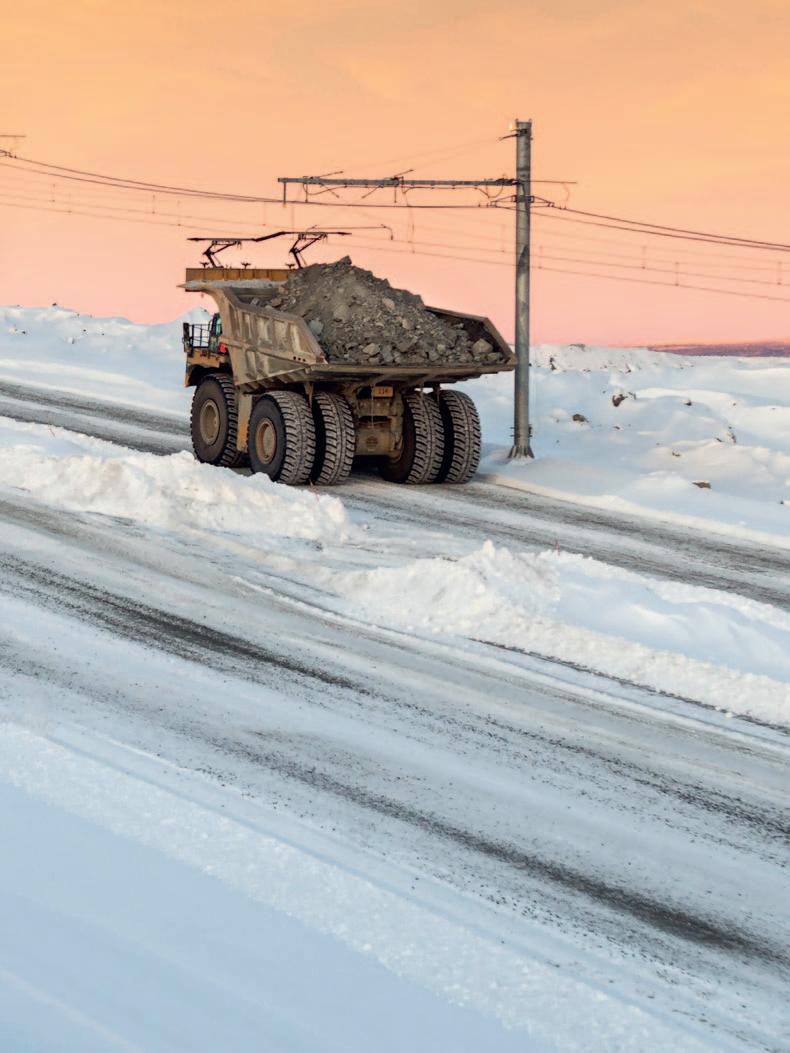
AUTOMINE MAPPING SOLUTION NEXT GENERATION AUTOMATION SOLUTIONS ®
AutoMine® Mapping Solution is the frst solution from the Next Generation program at Sandvik. It brings together two of the Next Generation technologies to make one state-of-the-art solution to enhance mining operations.
This innovative AutoMine® solution is designed to maximize productivity and improve safety of autonomous vehicle navigation in underground mining operations by utilizing mapped data. It enables a vehicle to map an automated underground environment with a 3D Mine Mapping Tool and then uses the information to generate 3D maps of the mine. The data can then be used by 2D underground equipment to operate safely during mining operations
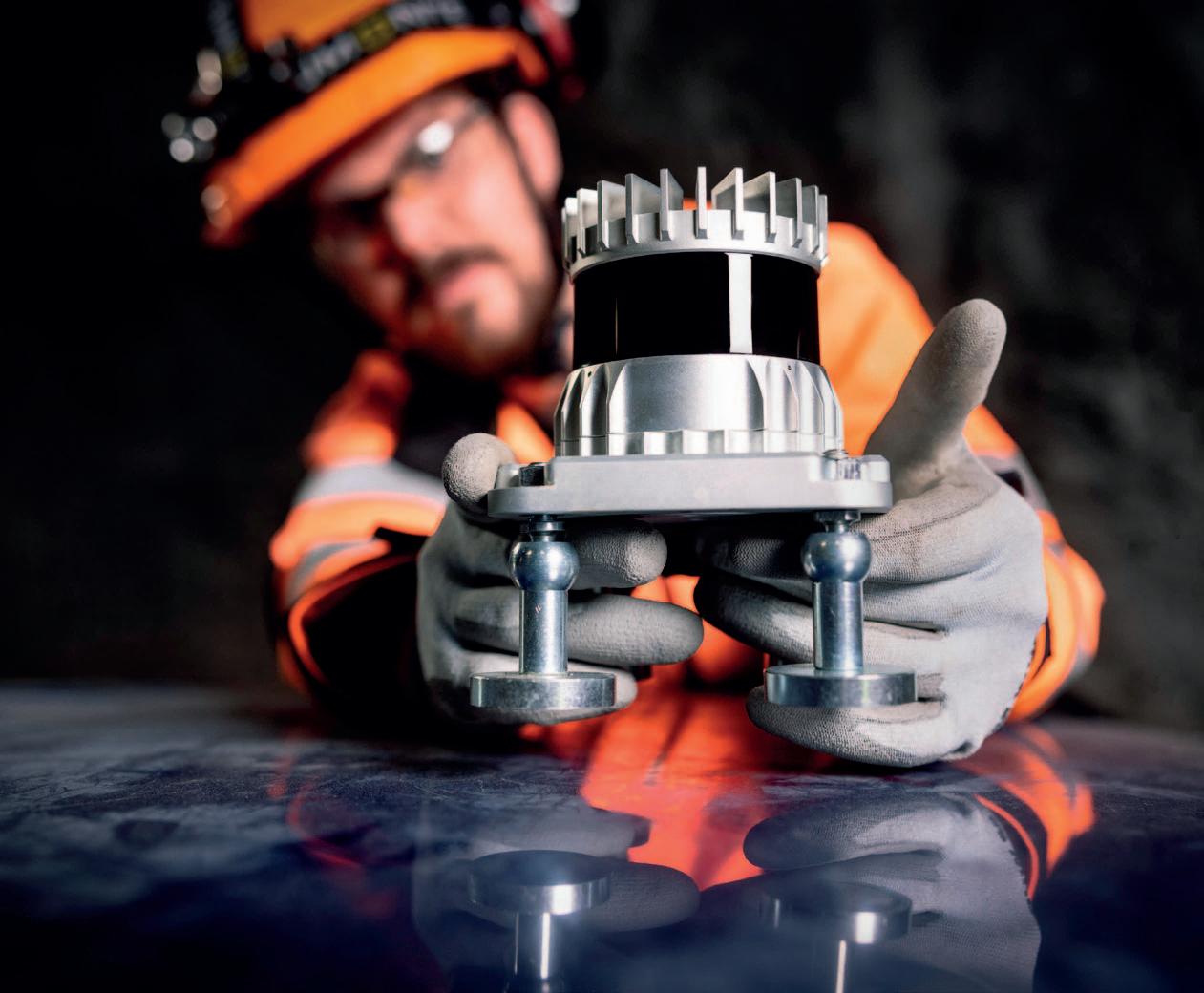
EXPLORE NEXT GENERATION AUTOMATION SOLUTIONS
ROCKTECHNOLOGY.SANDVIK

